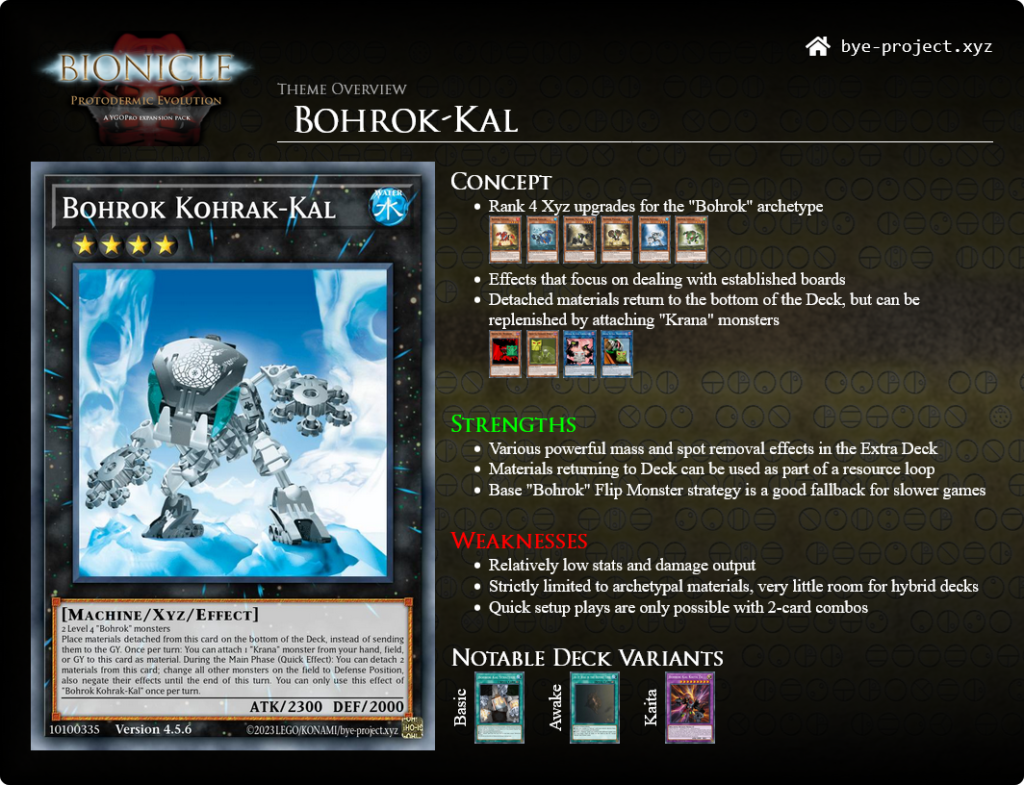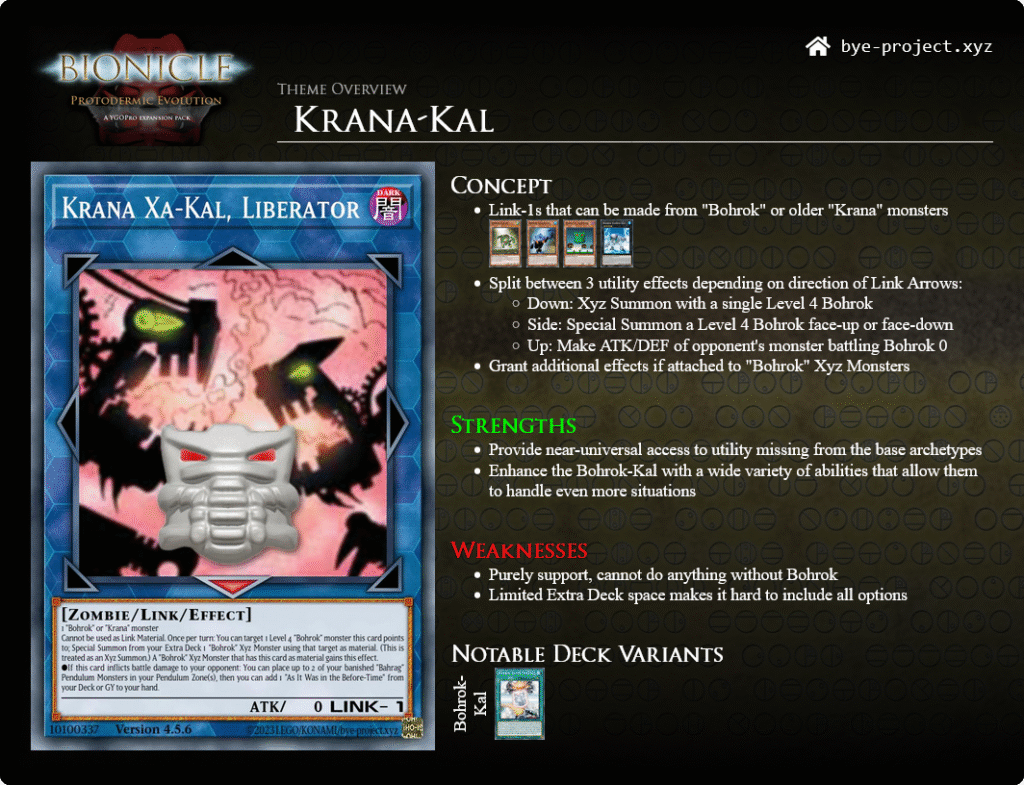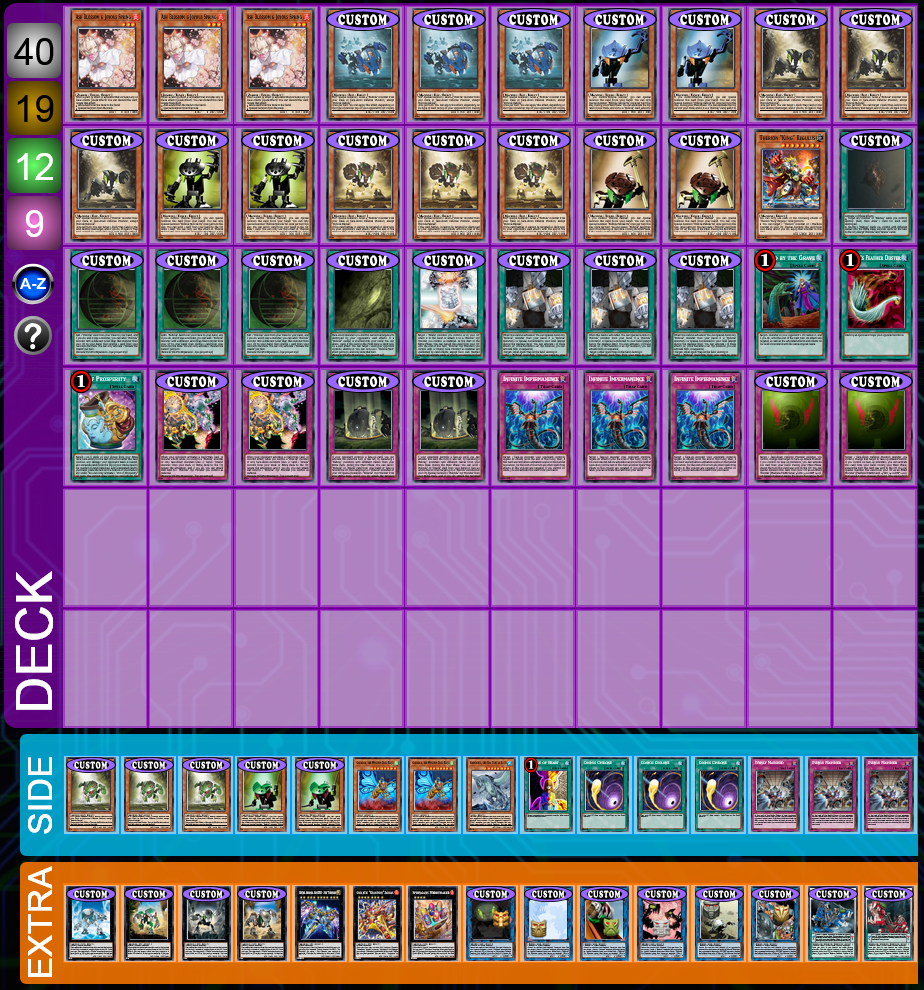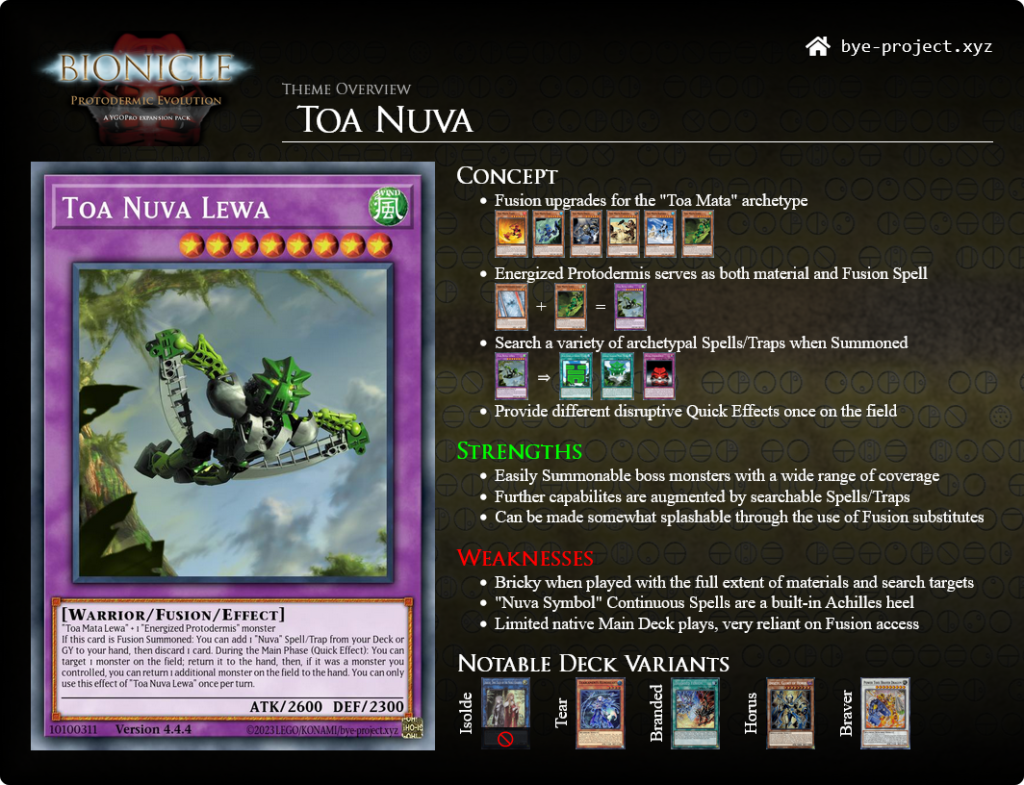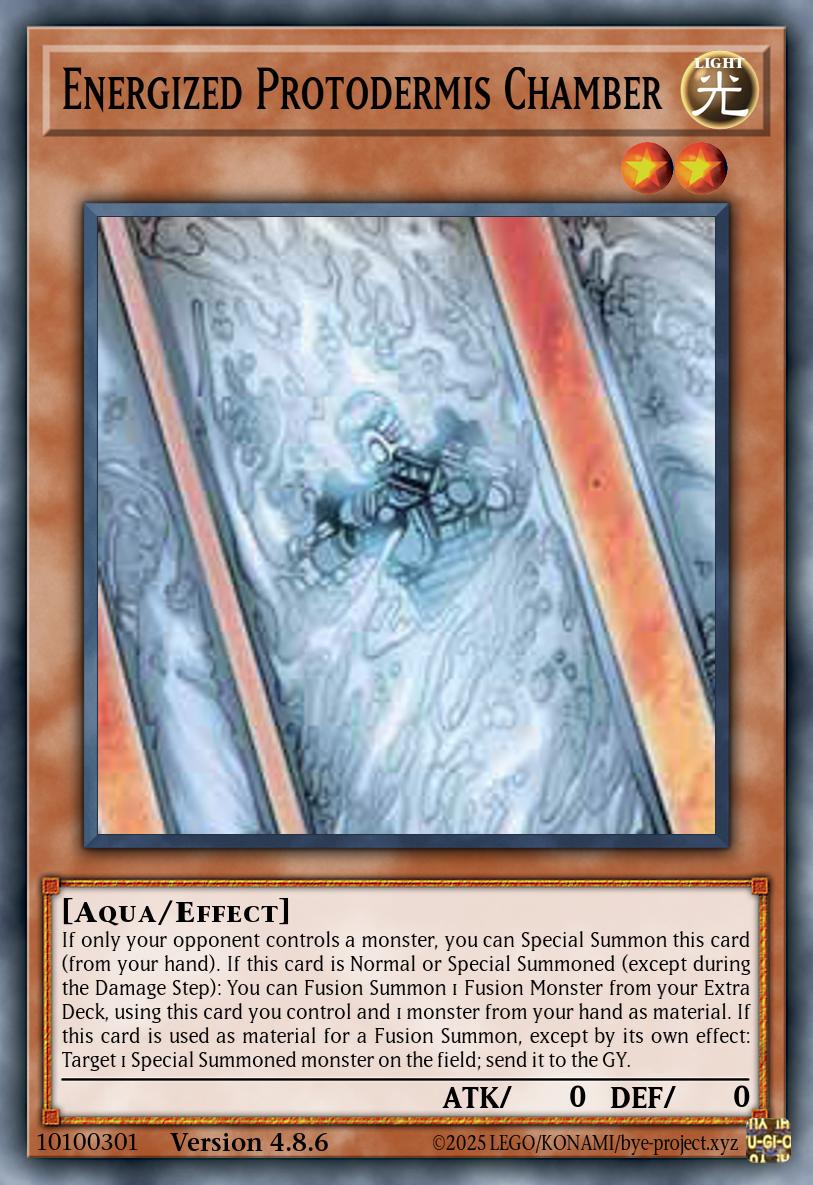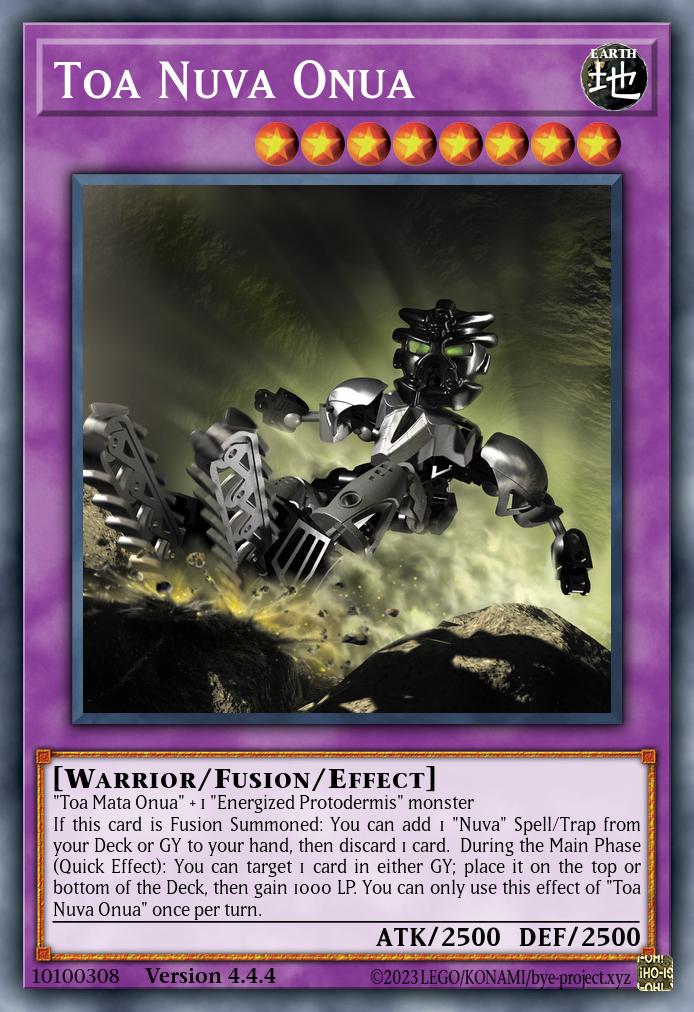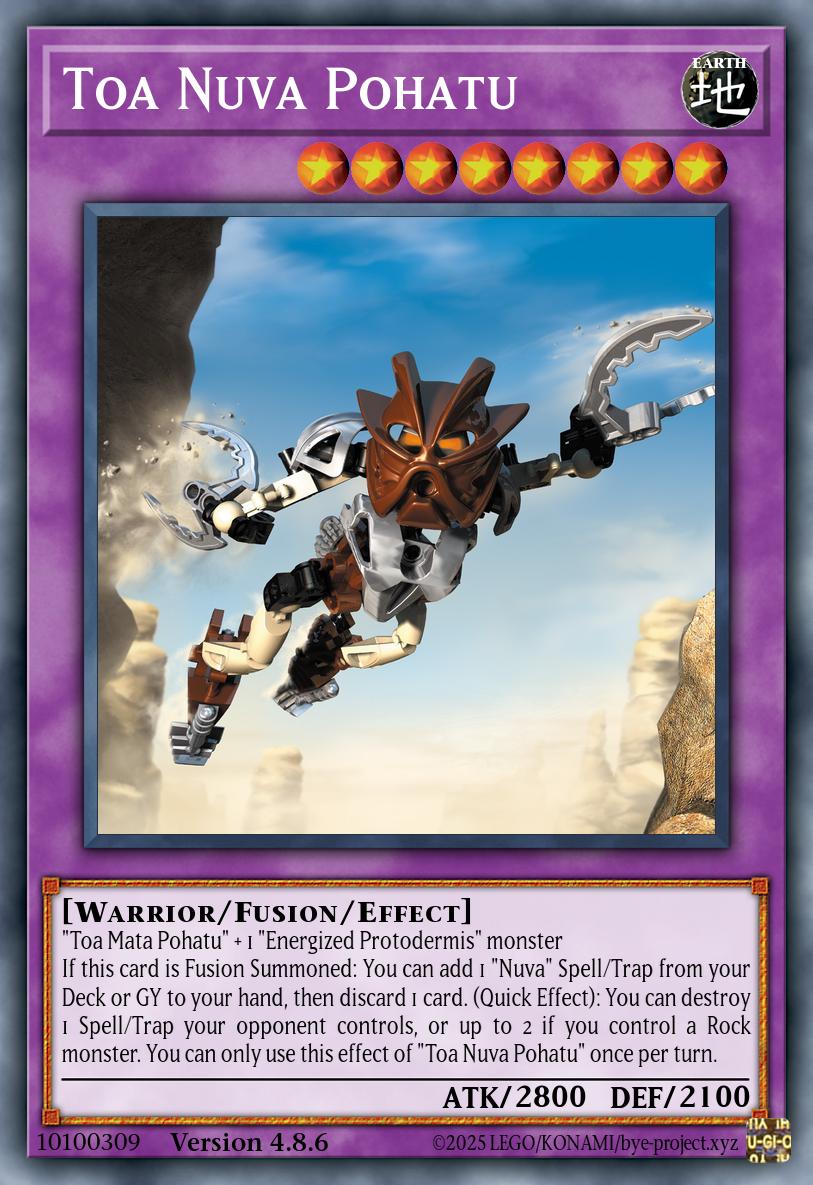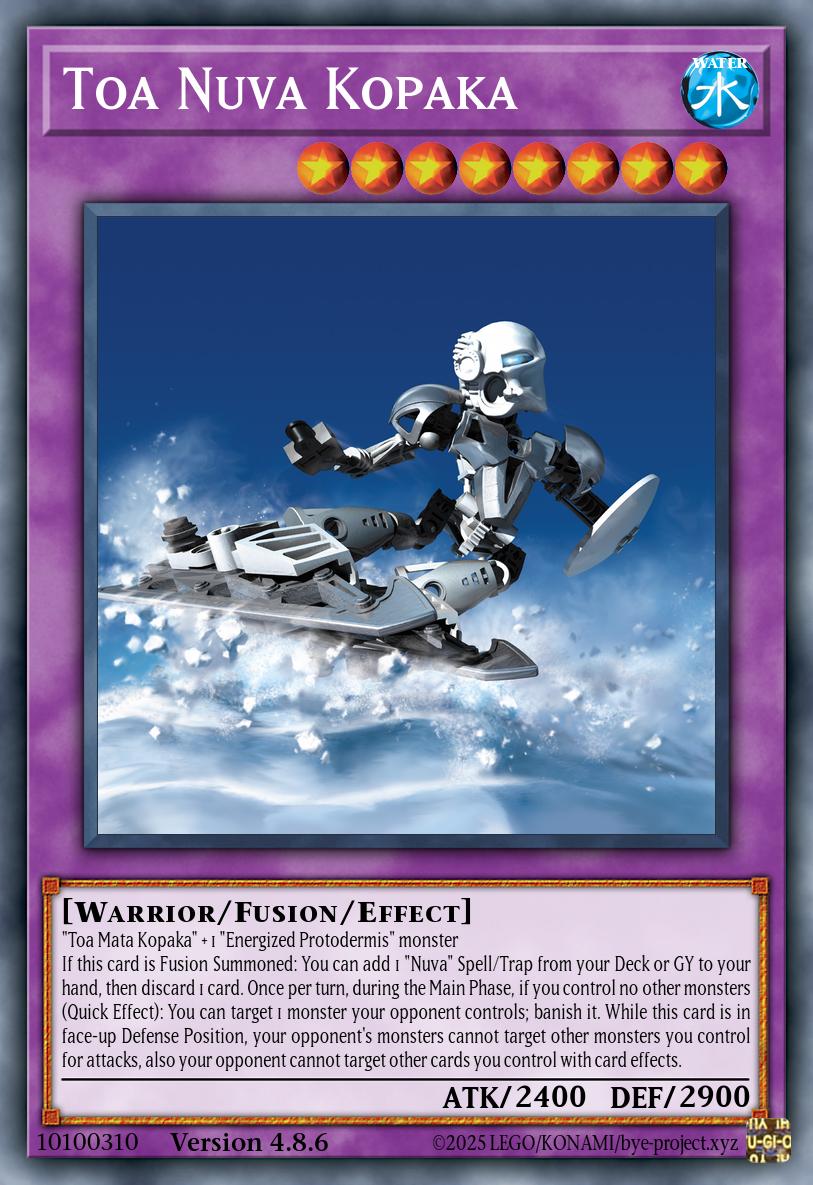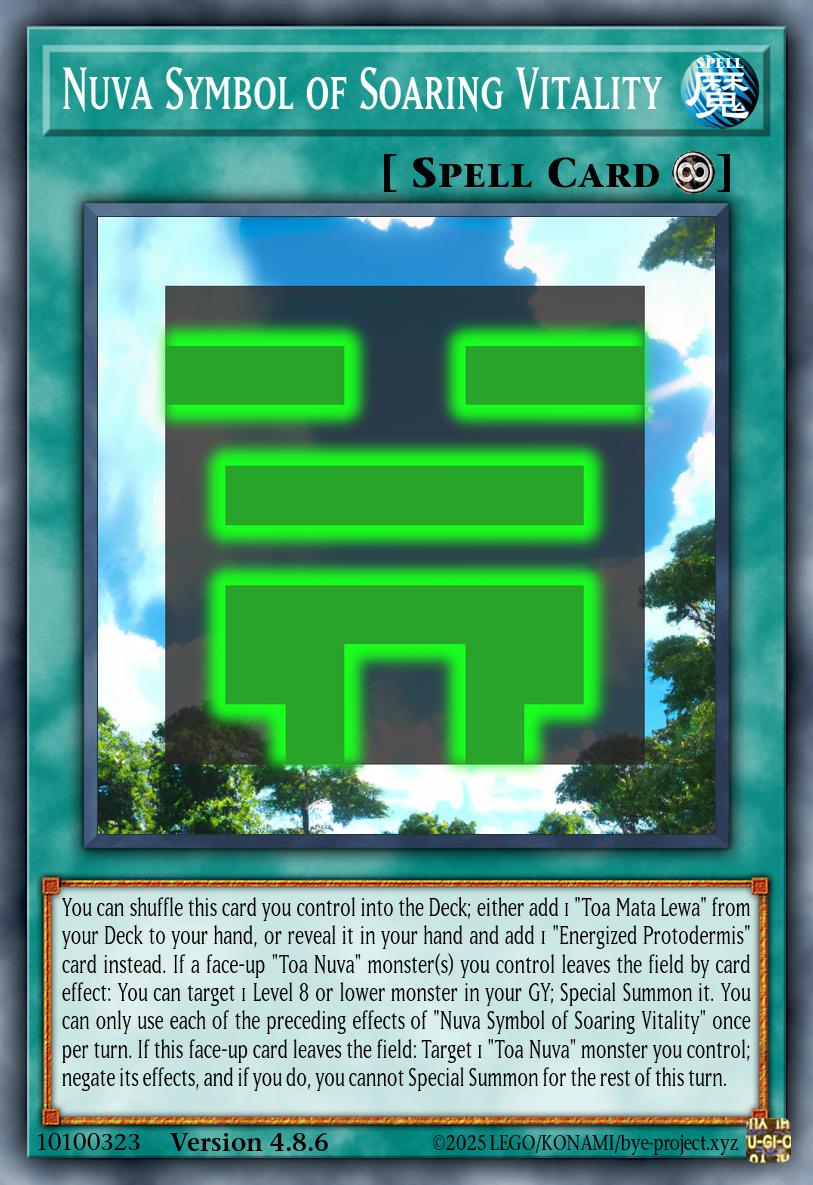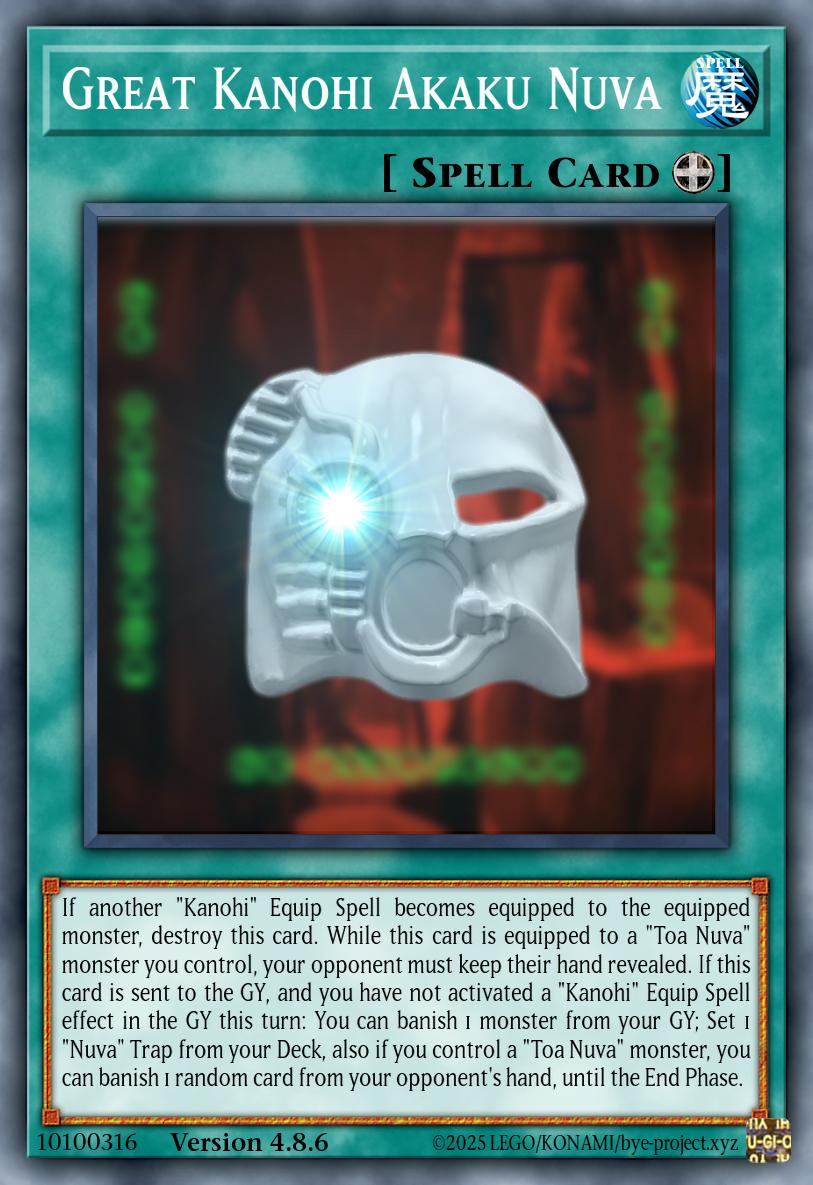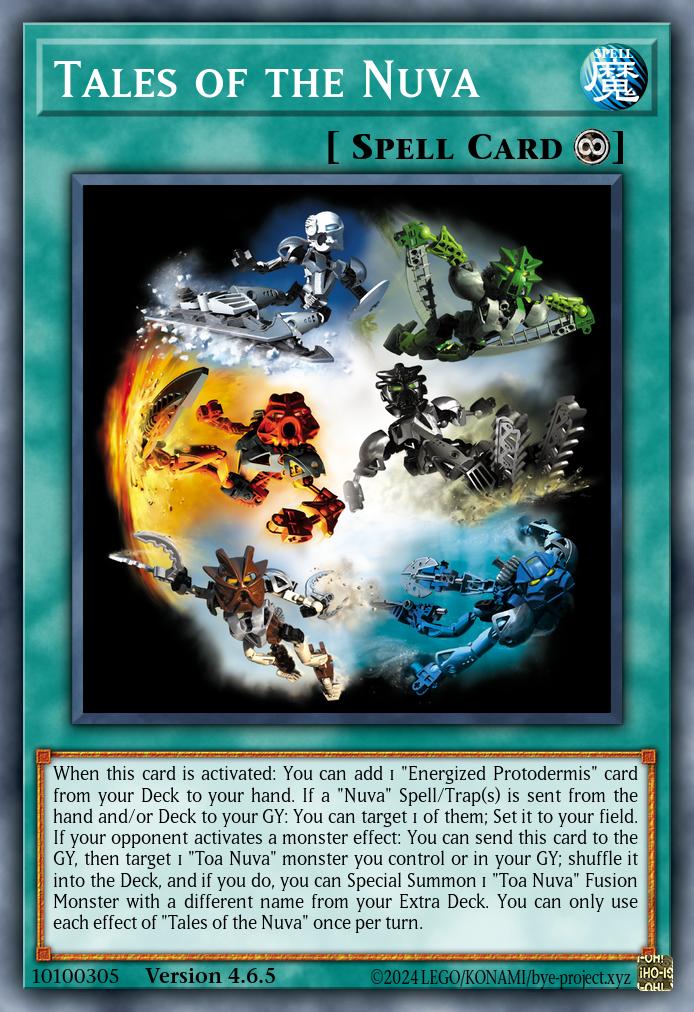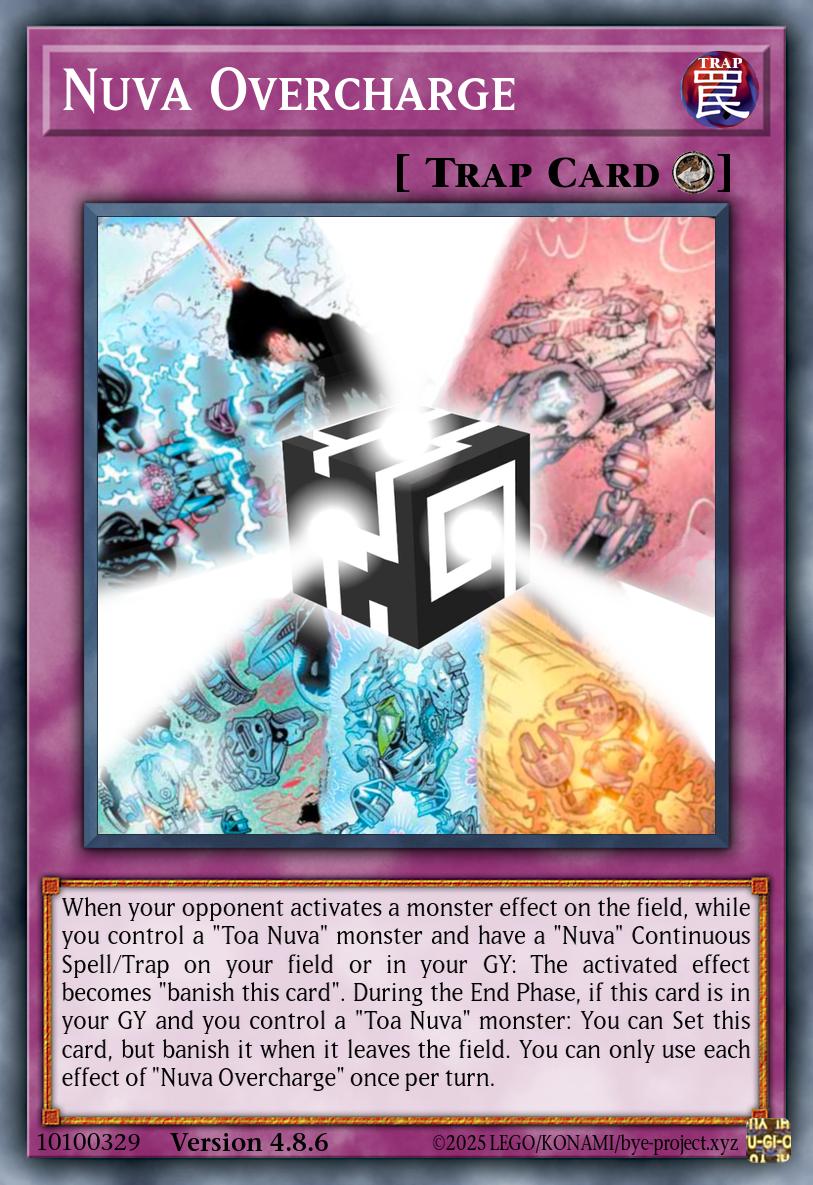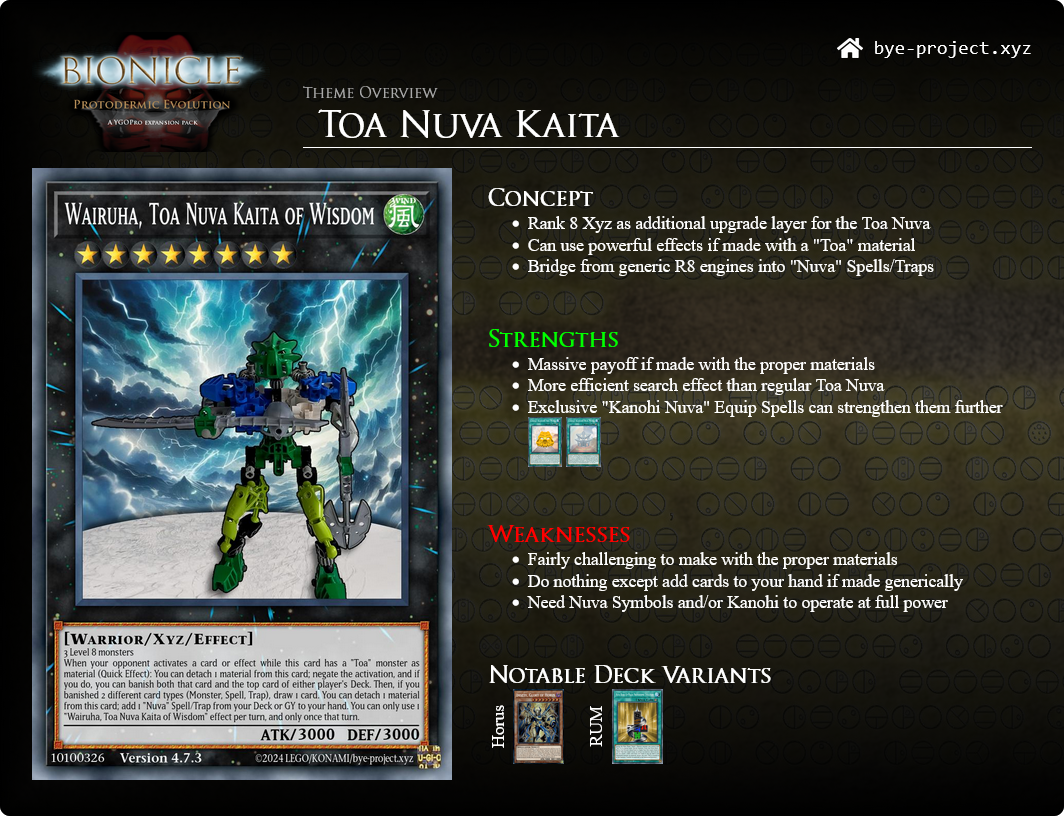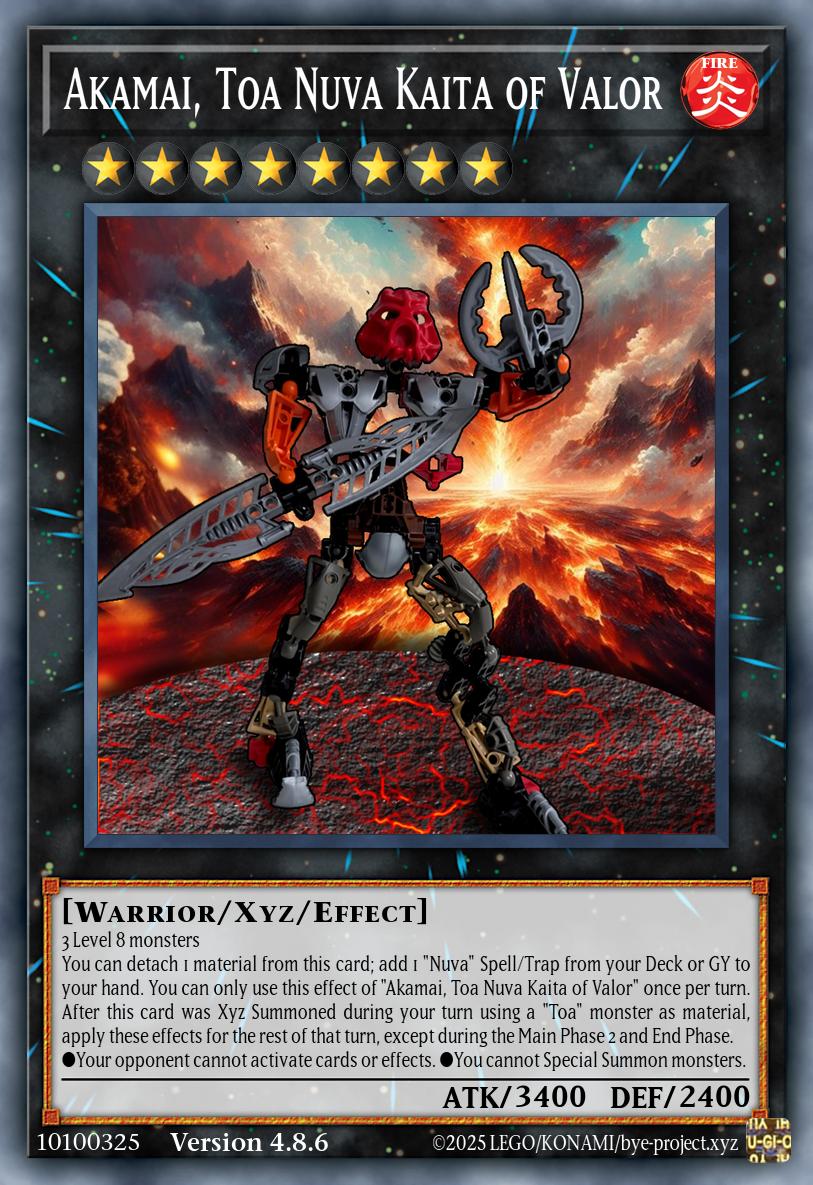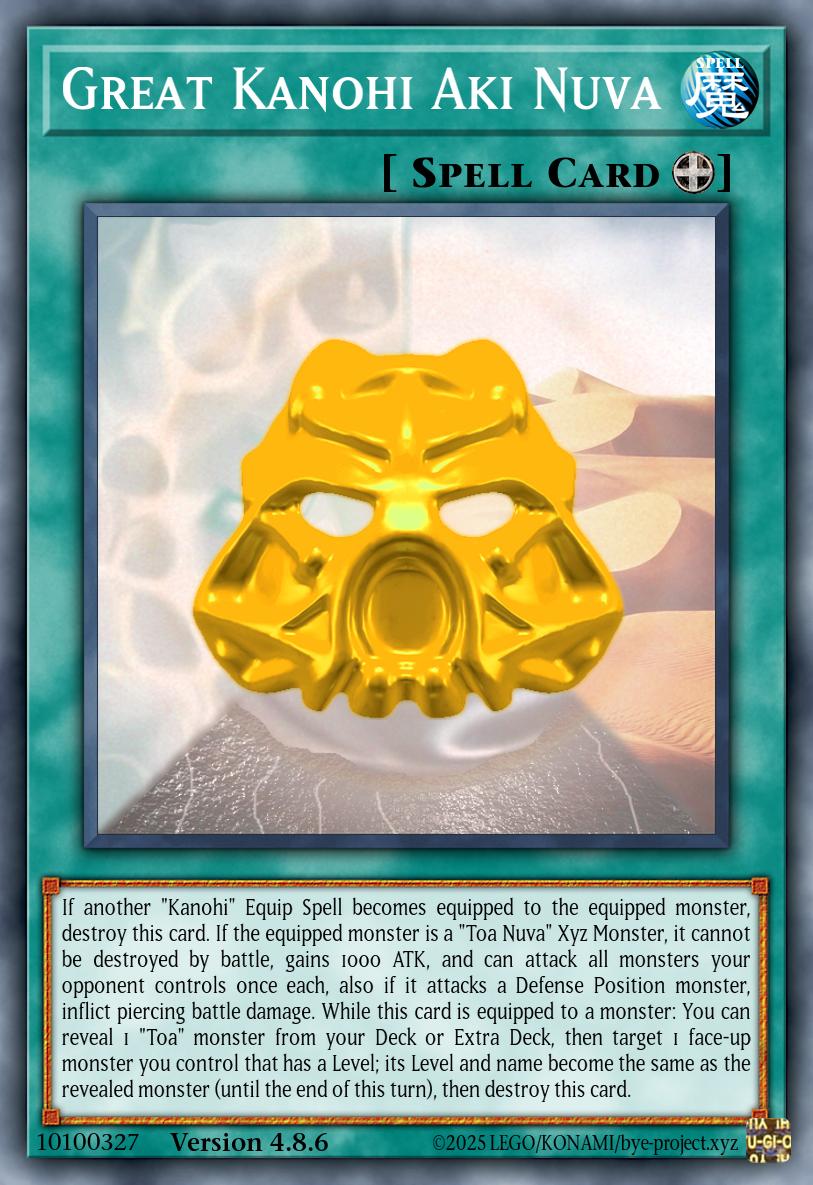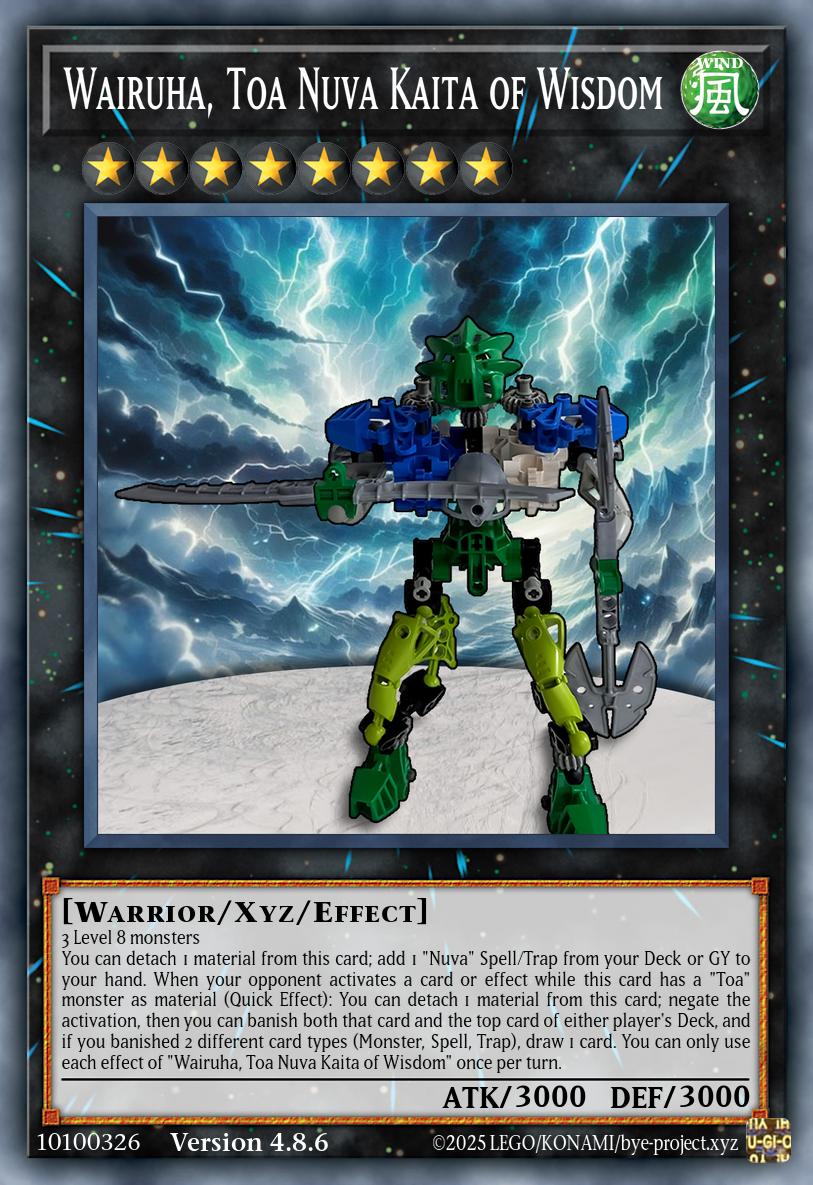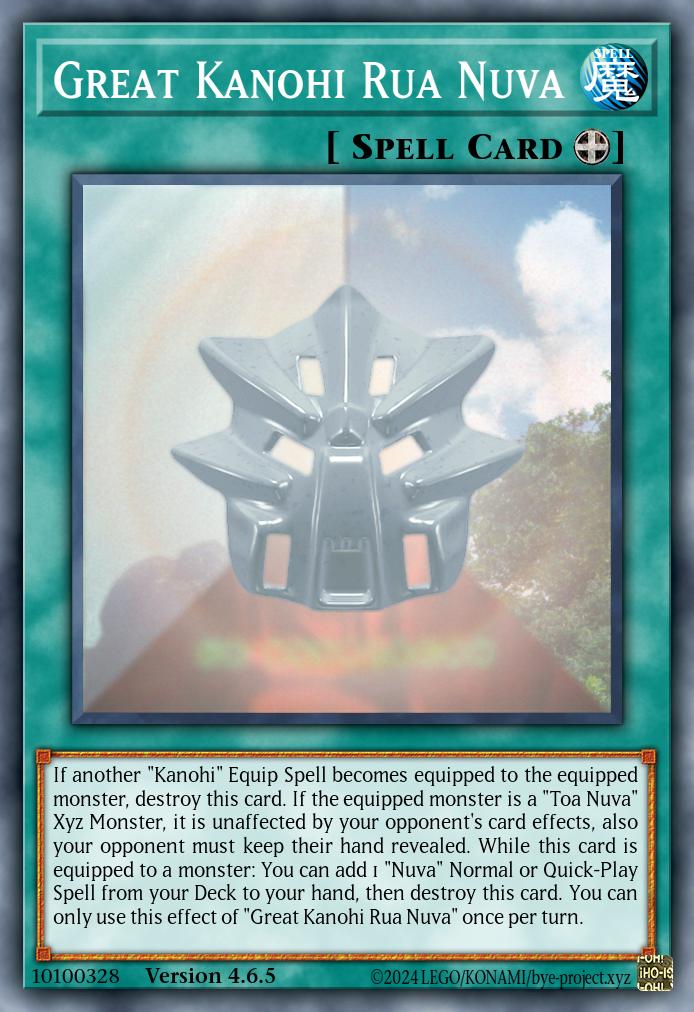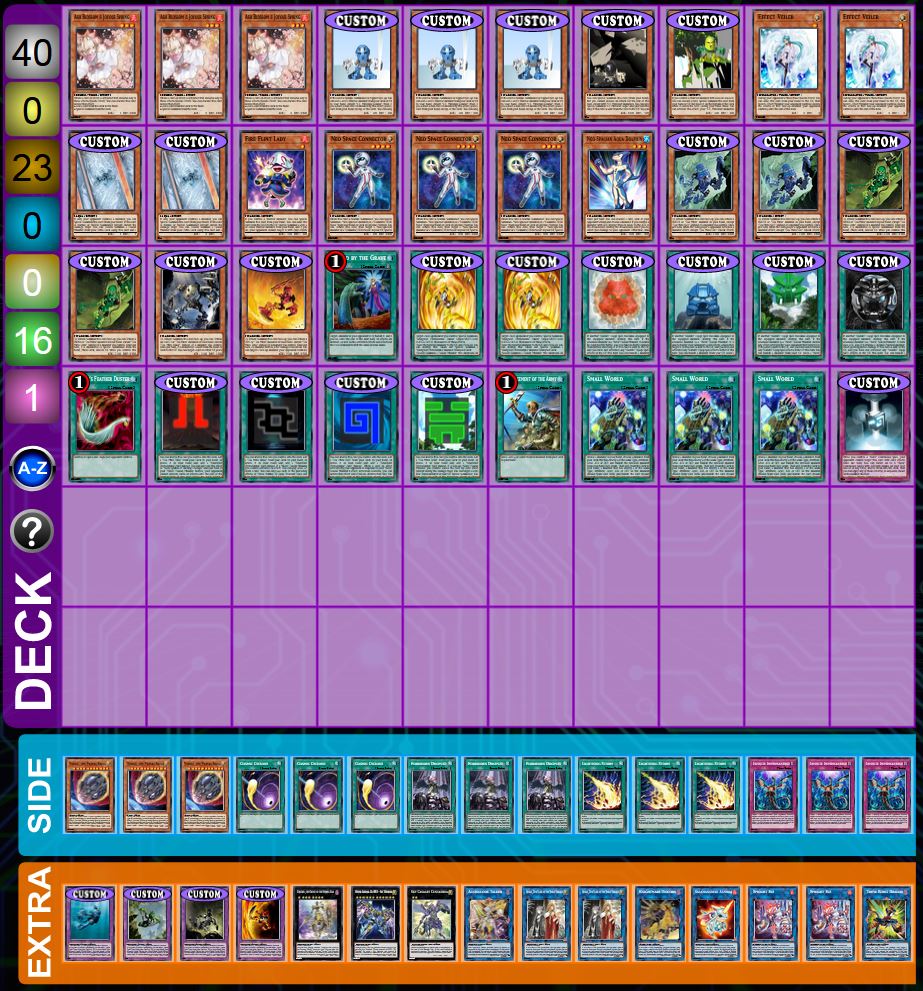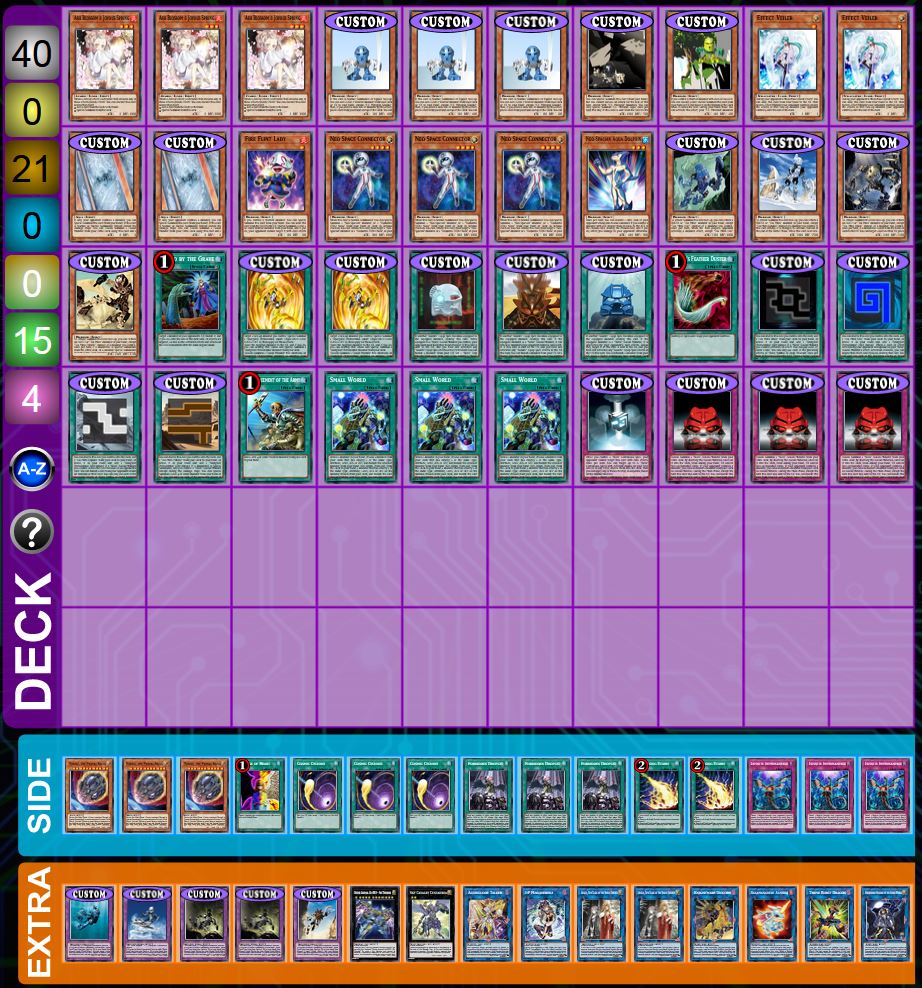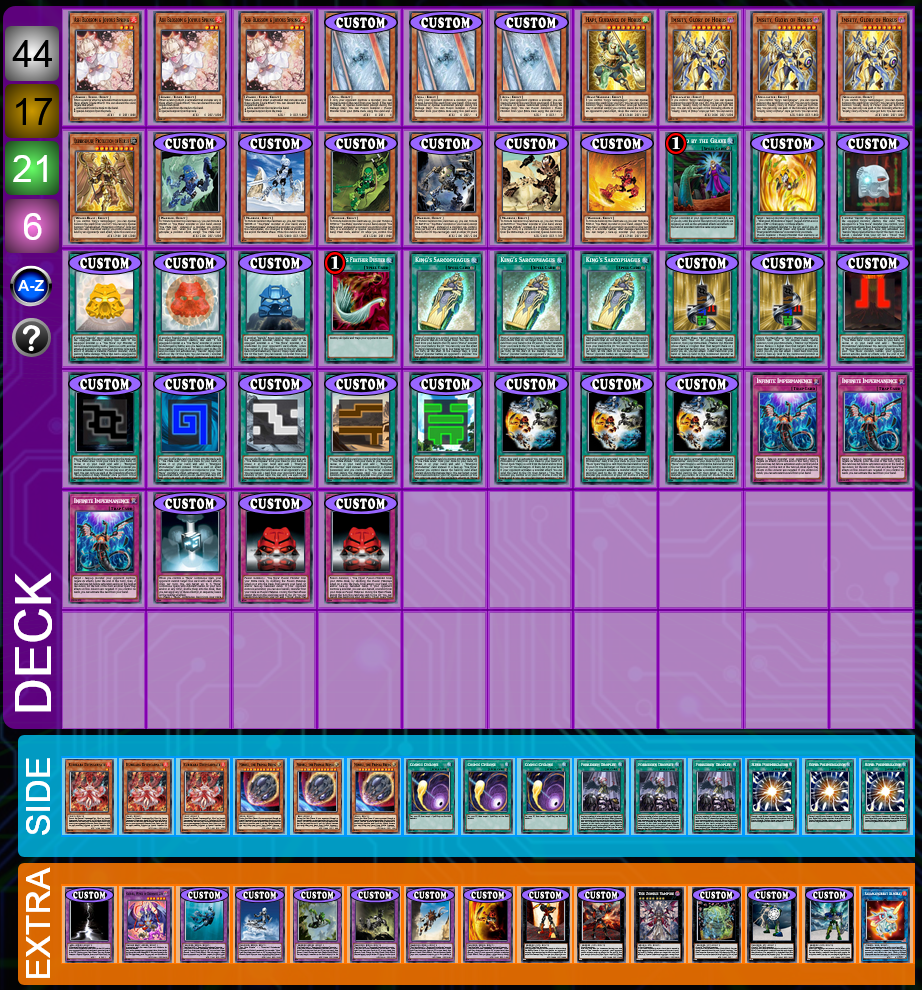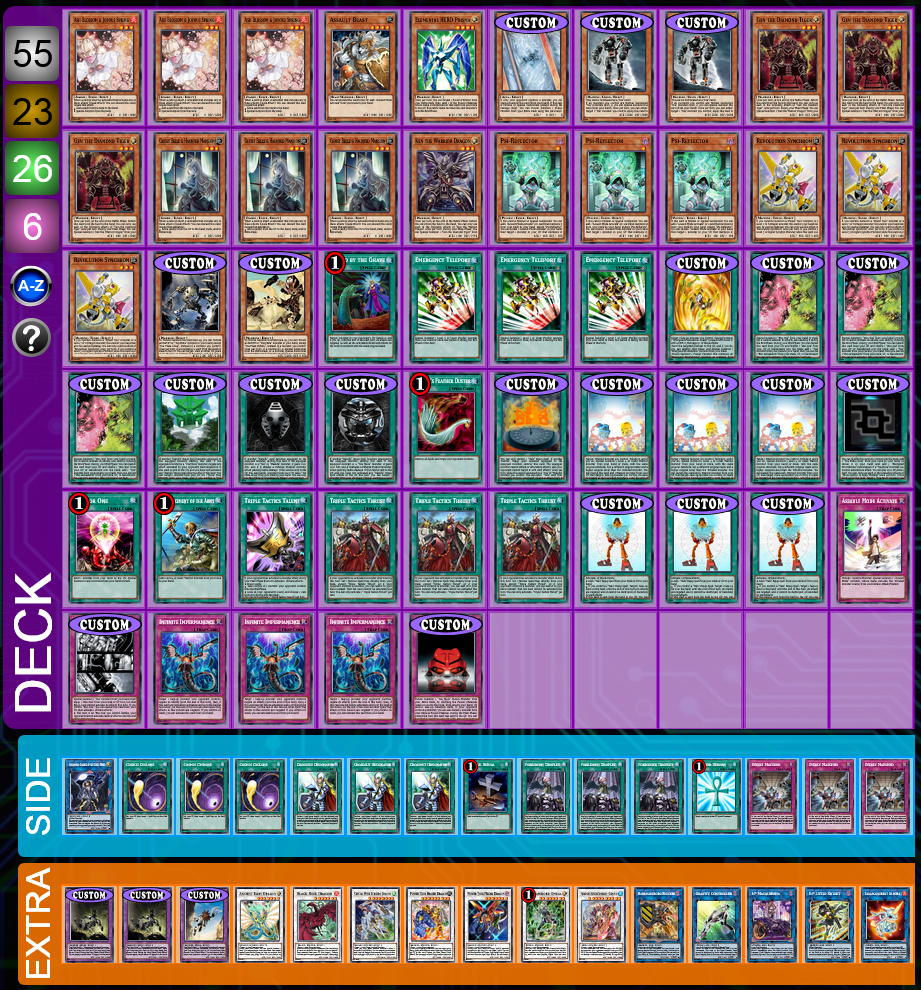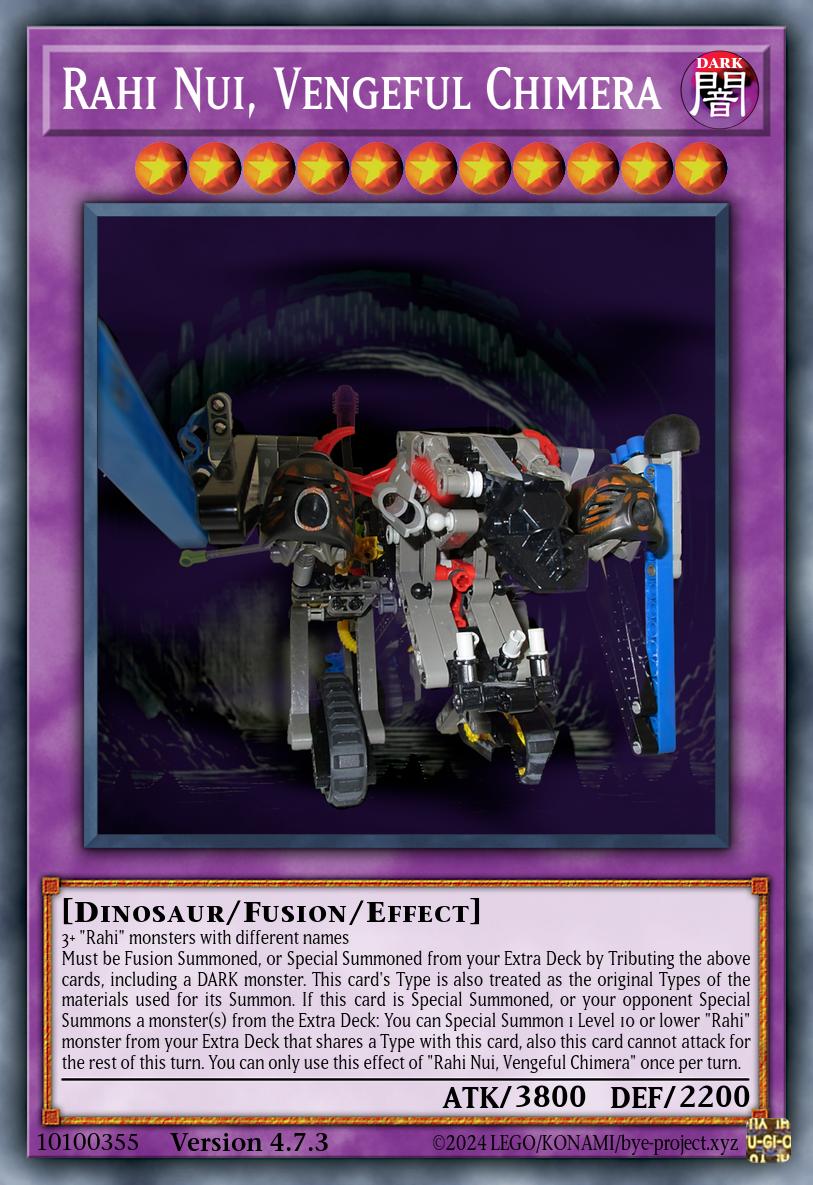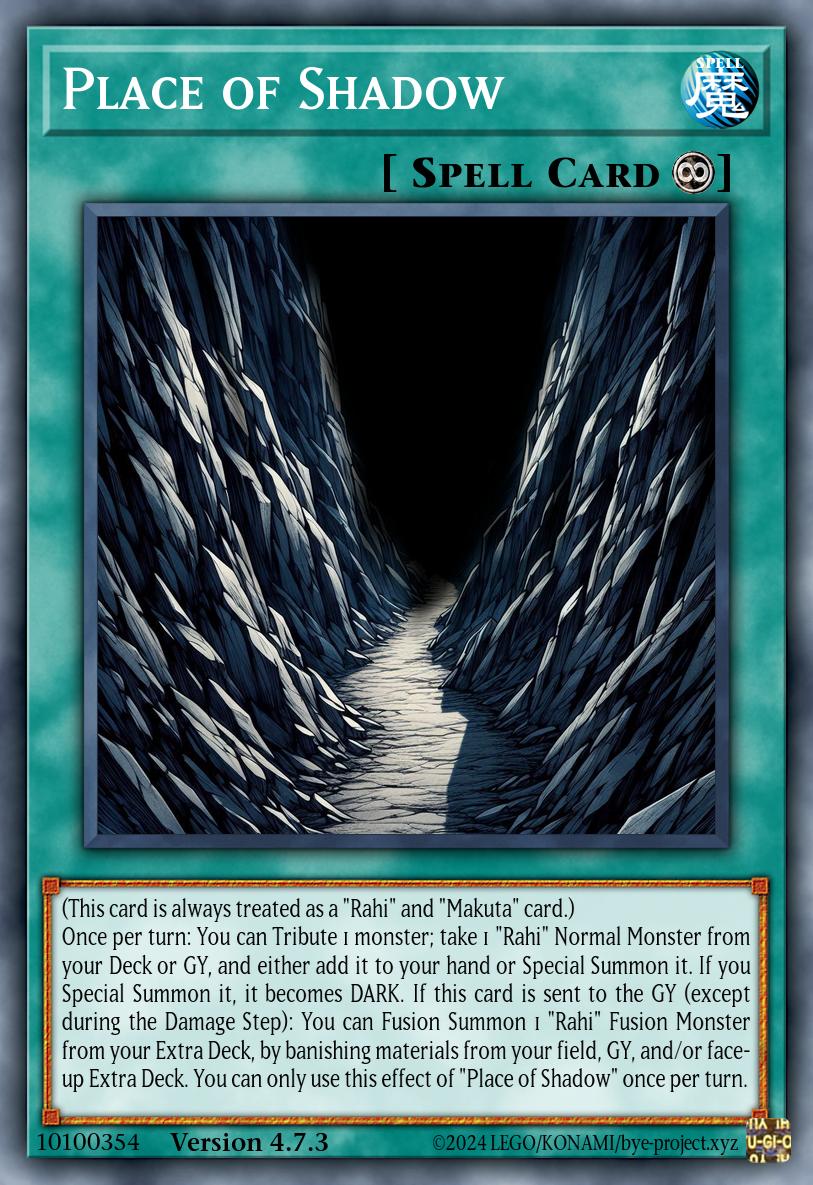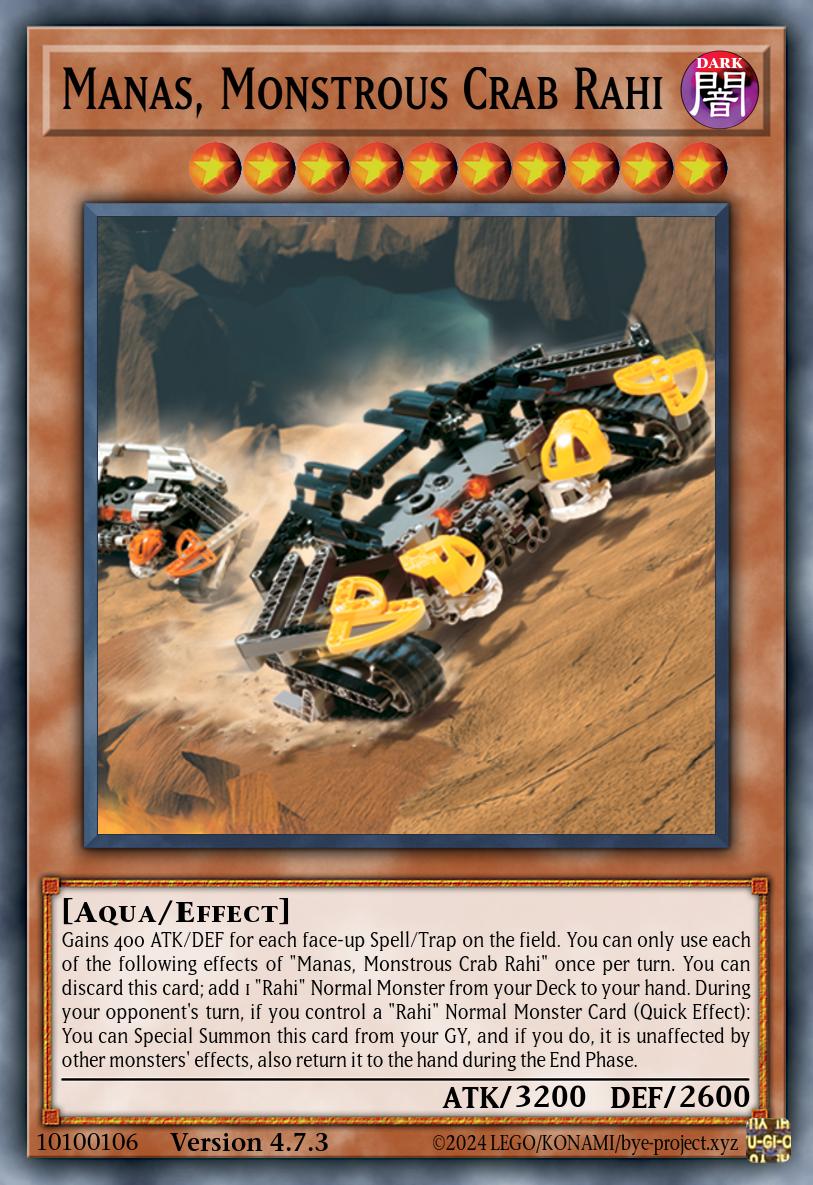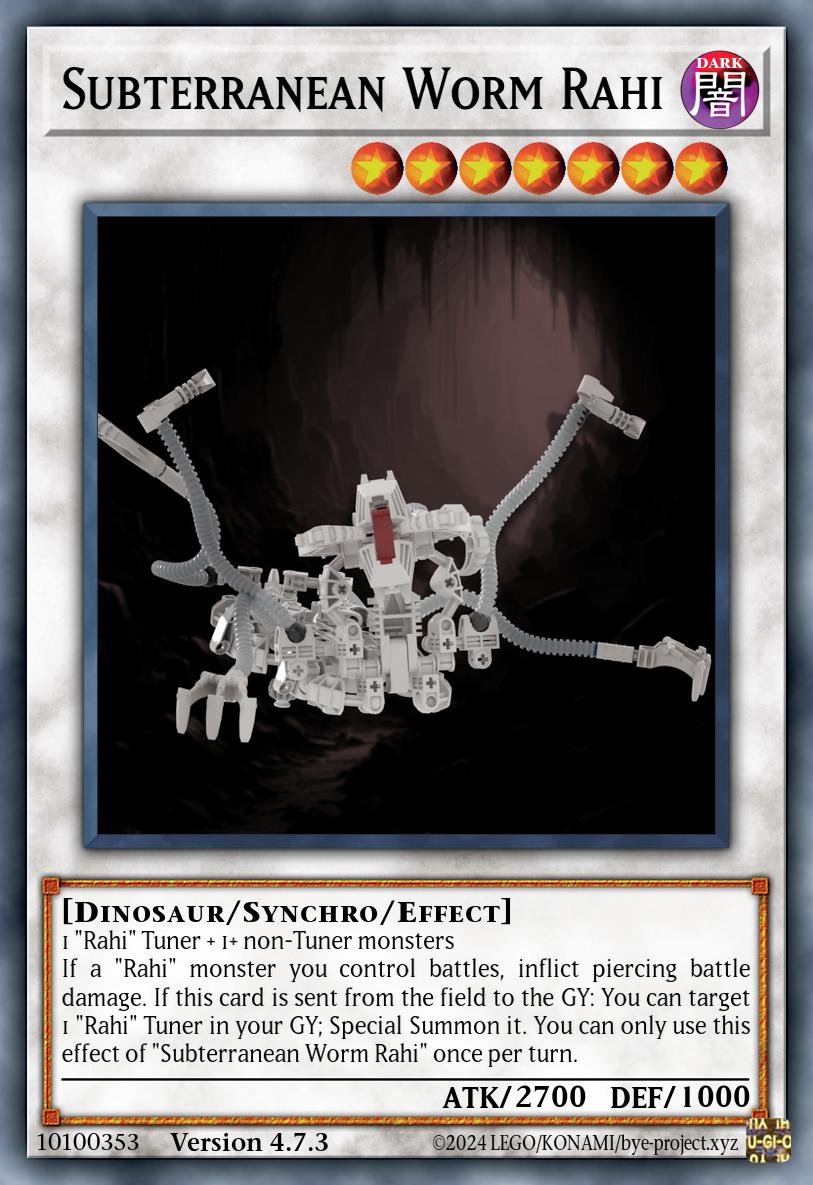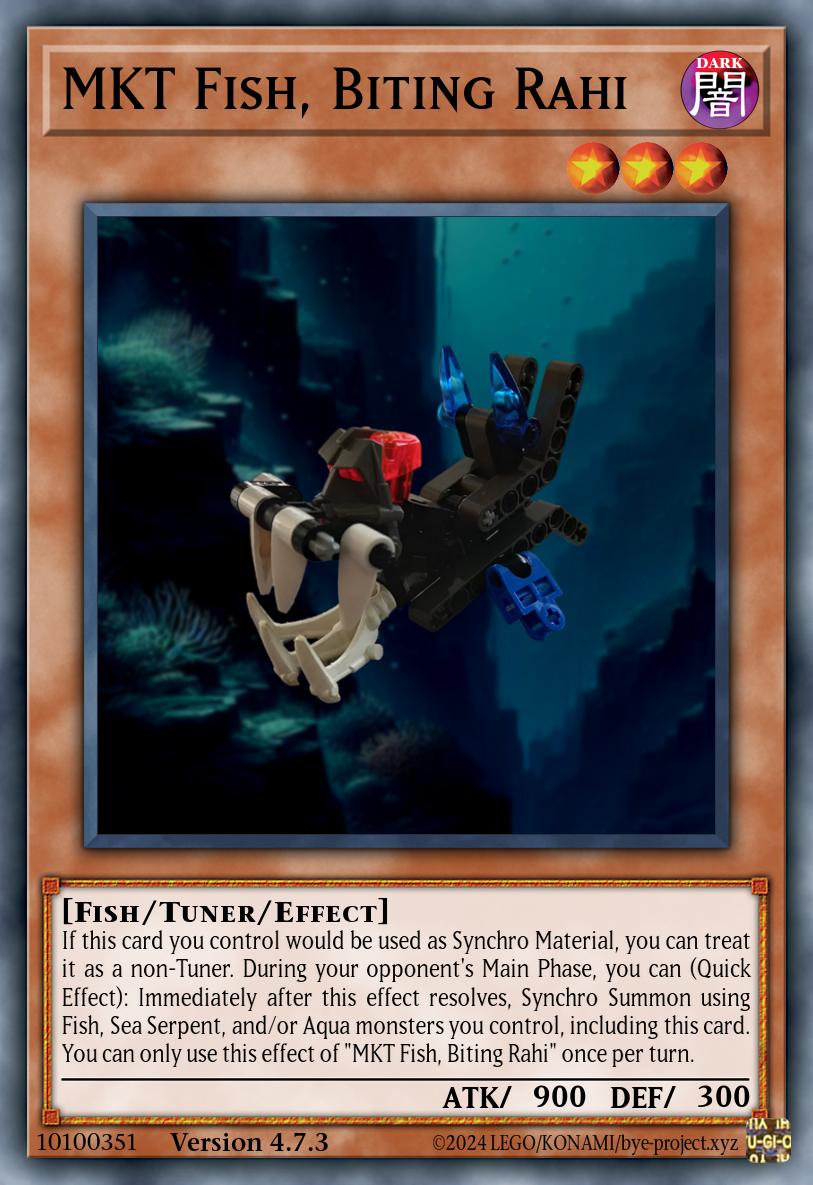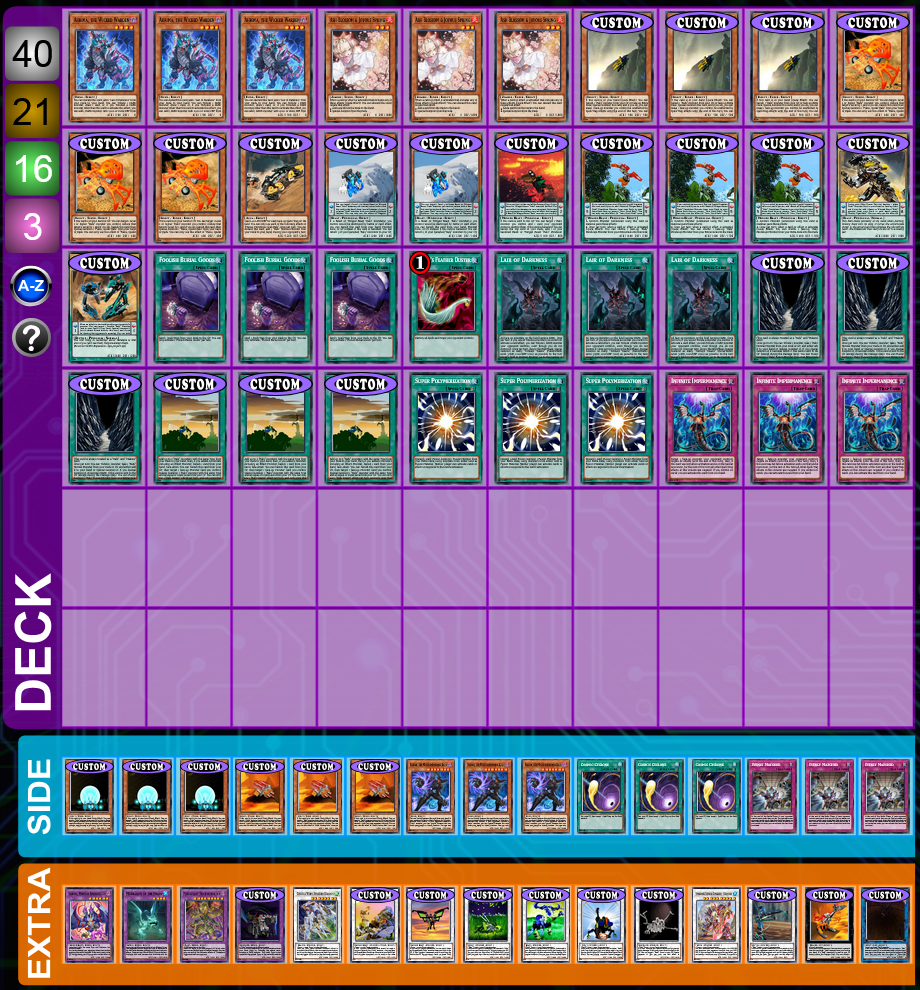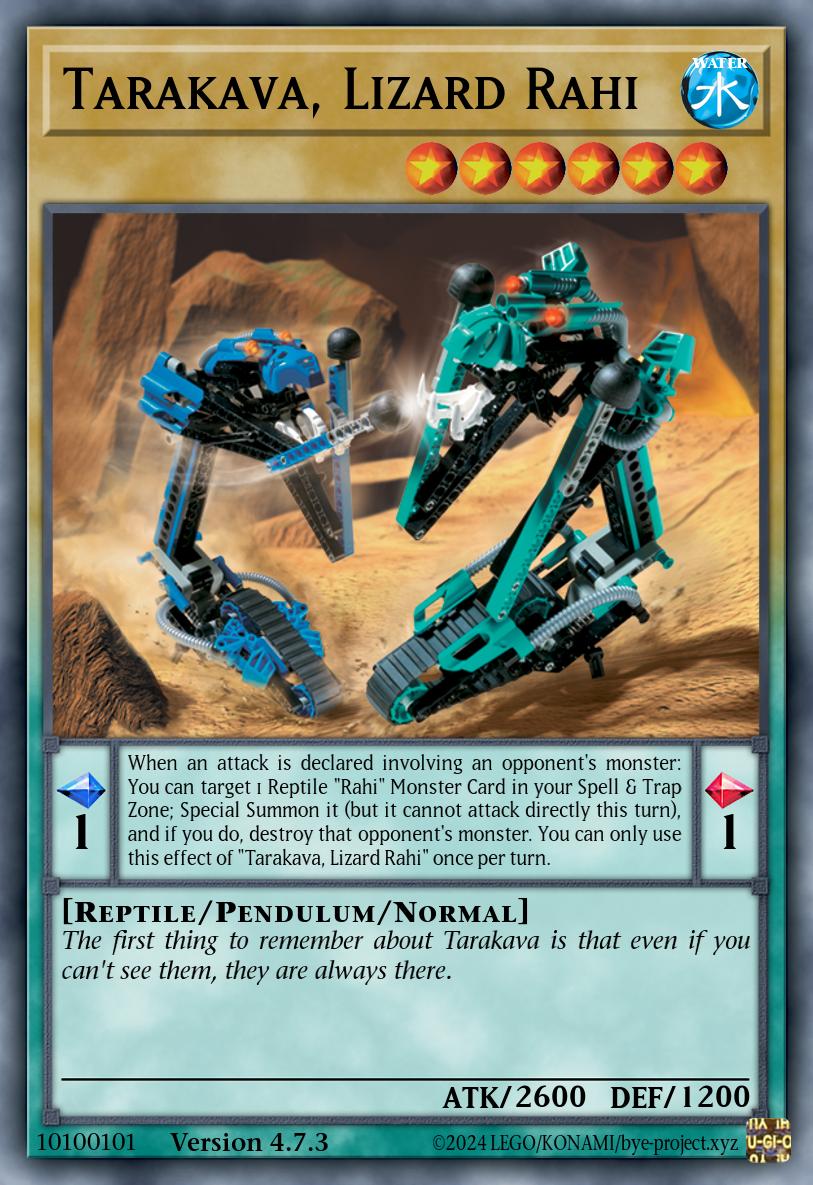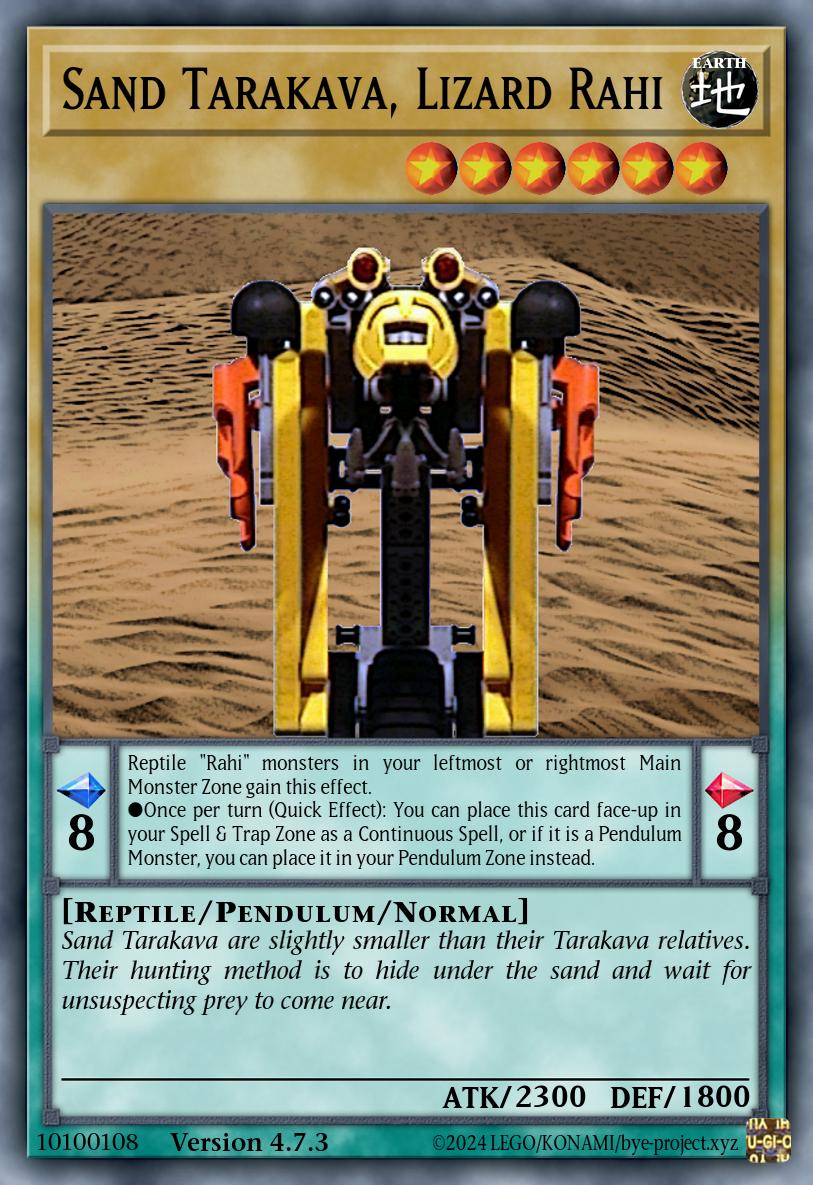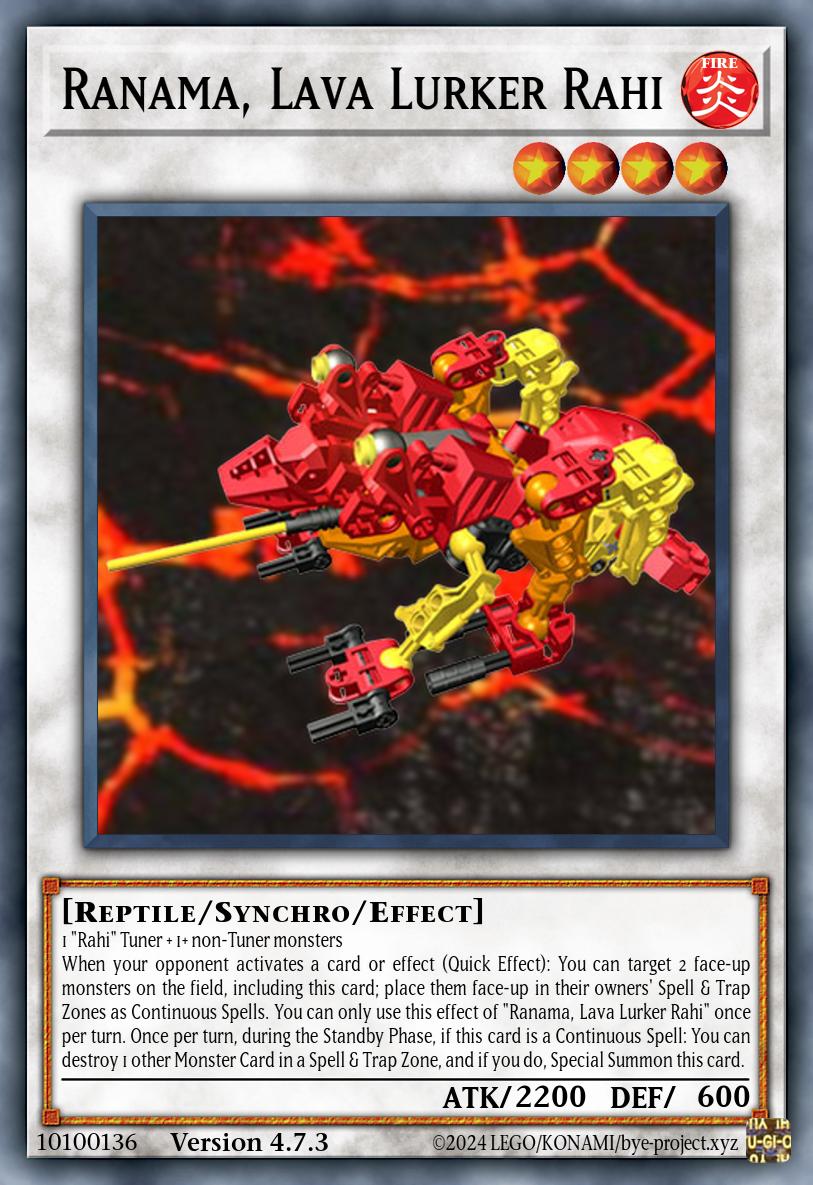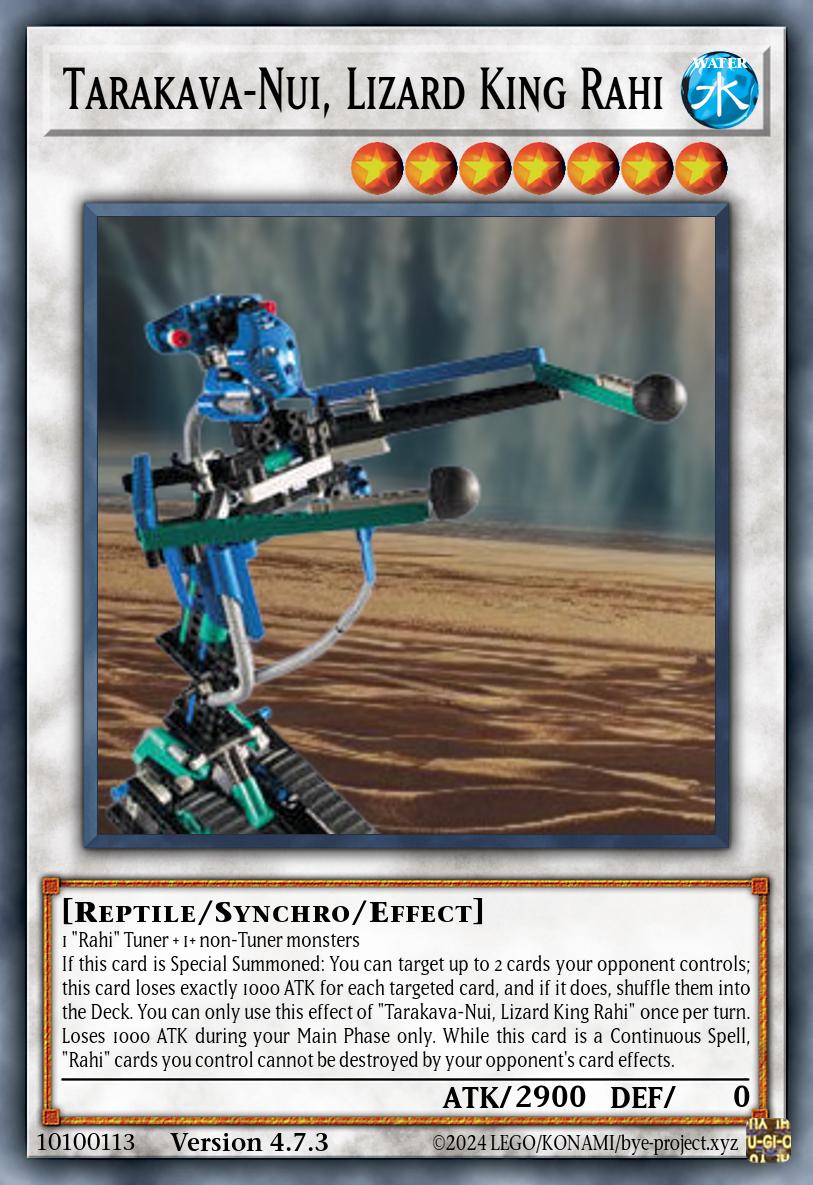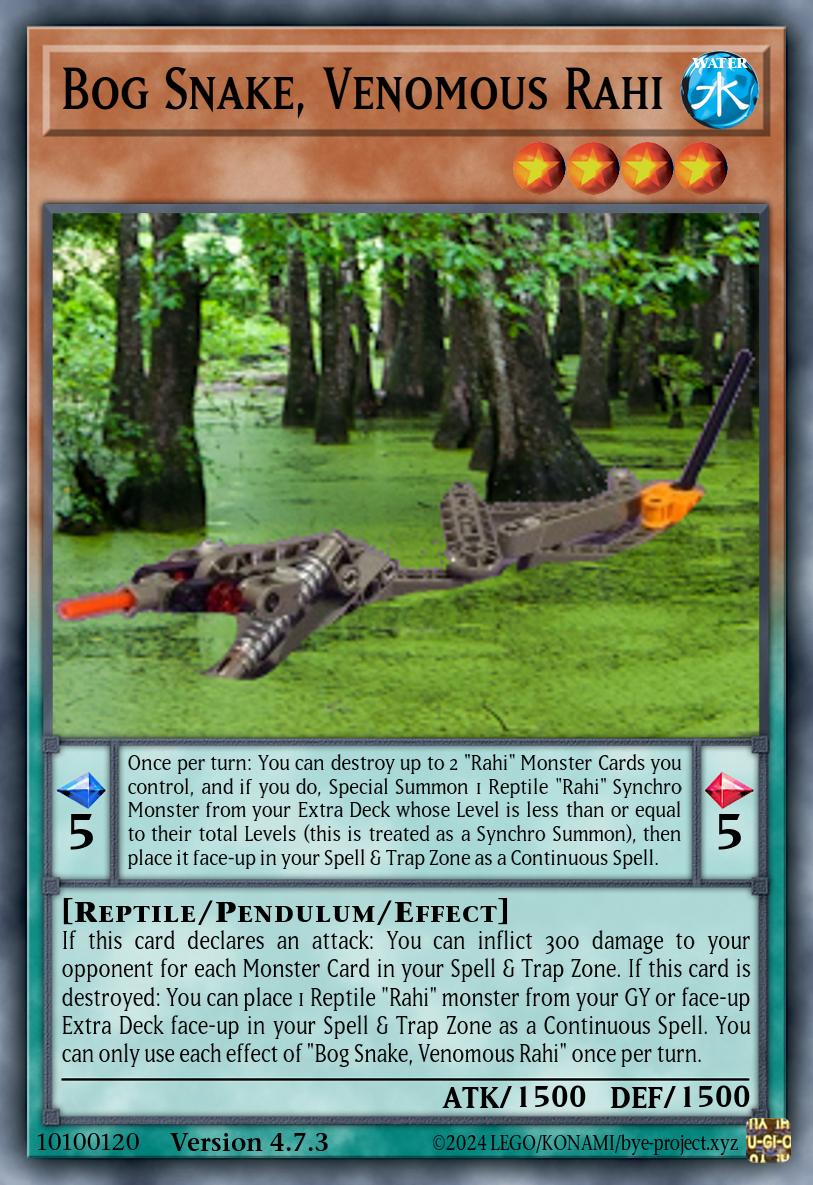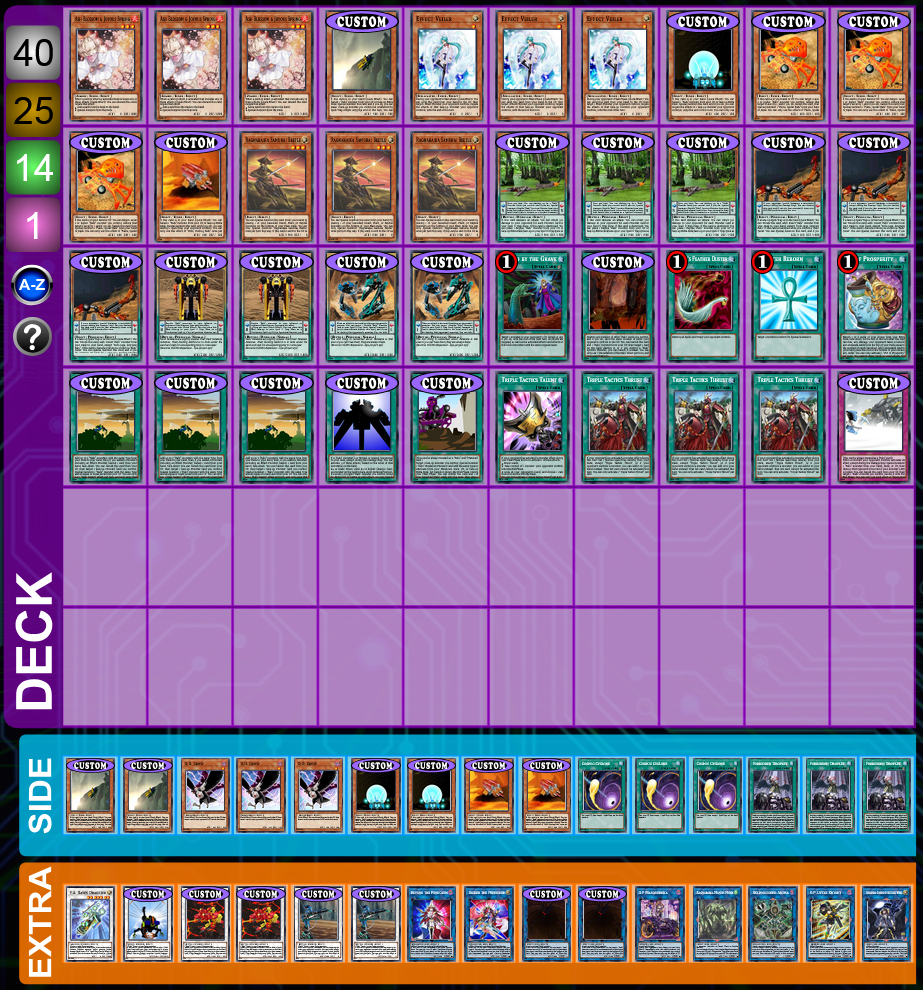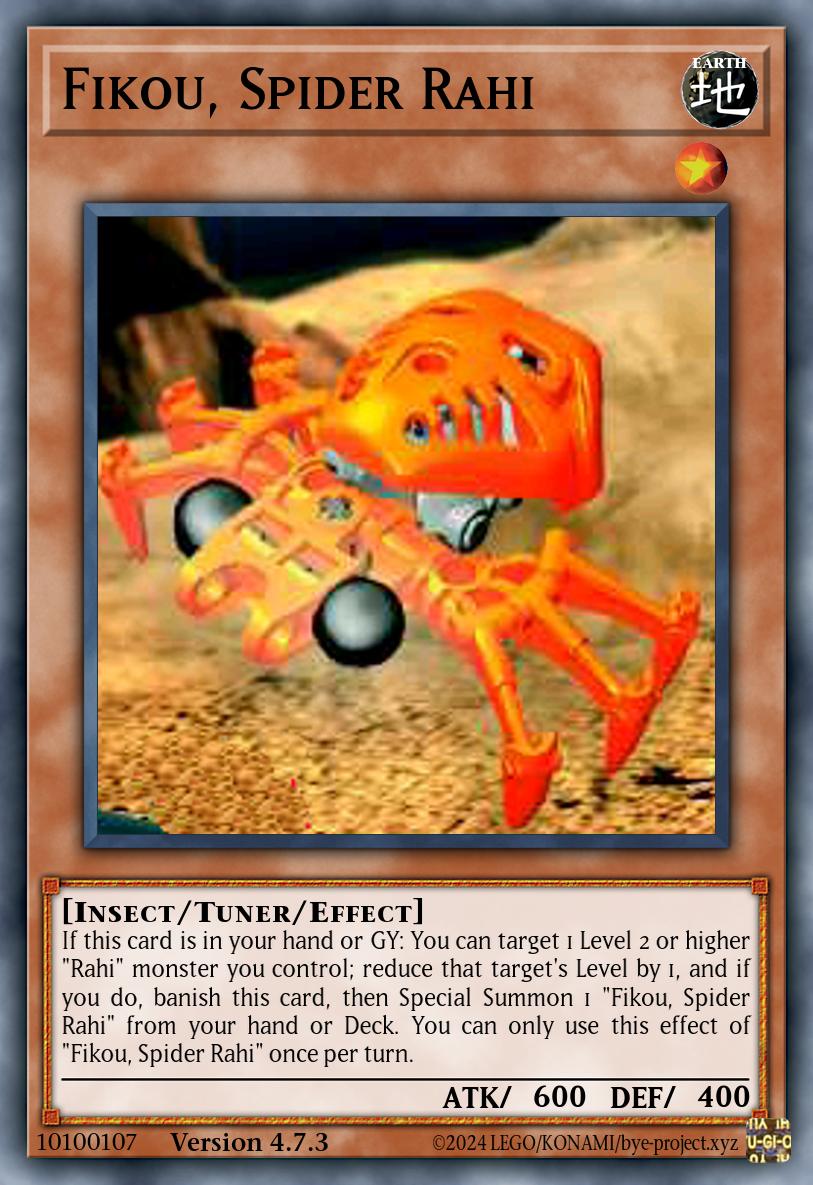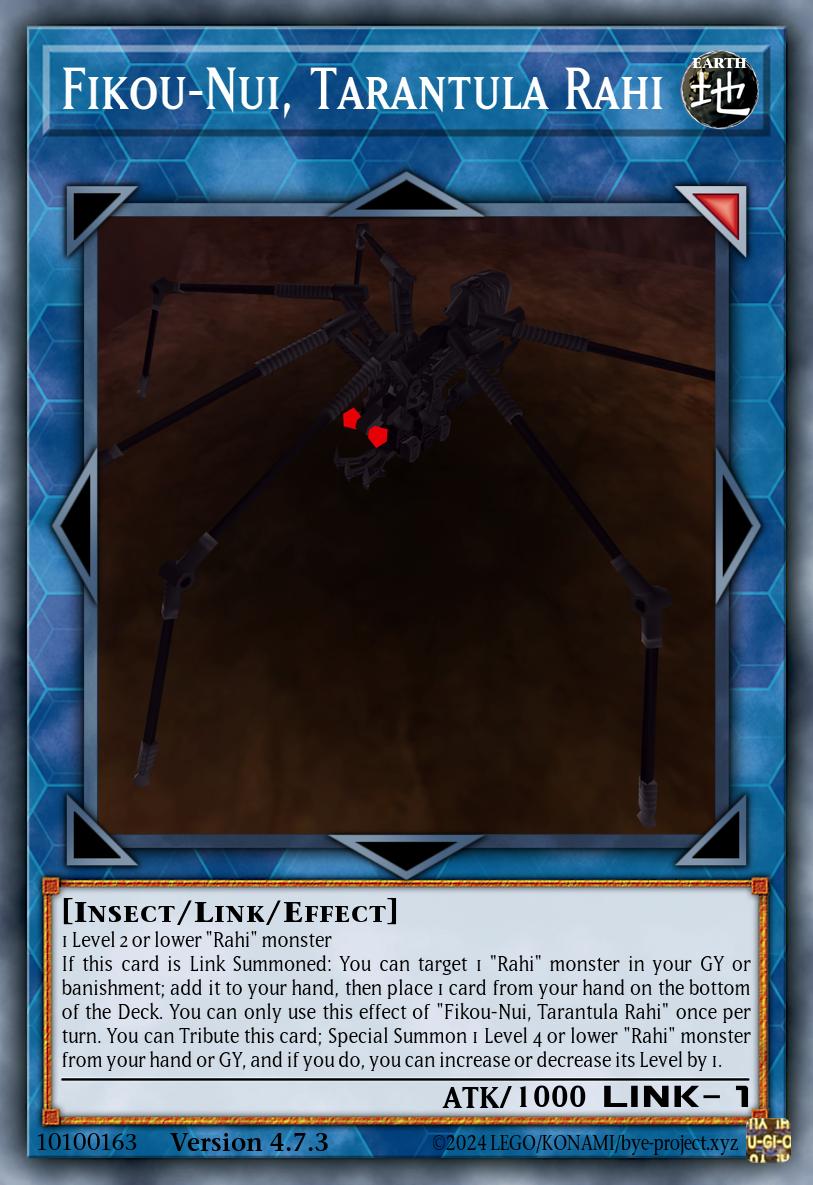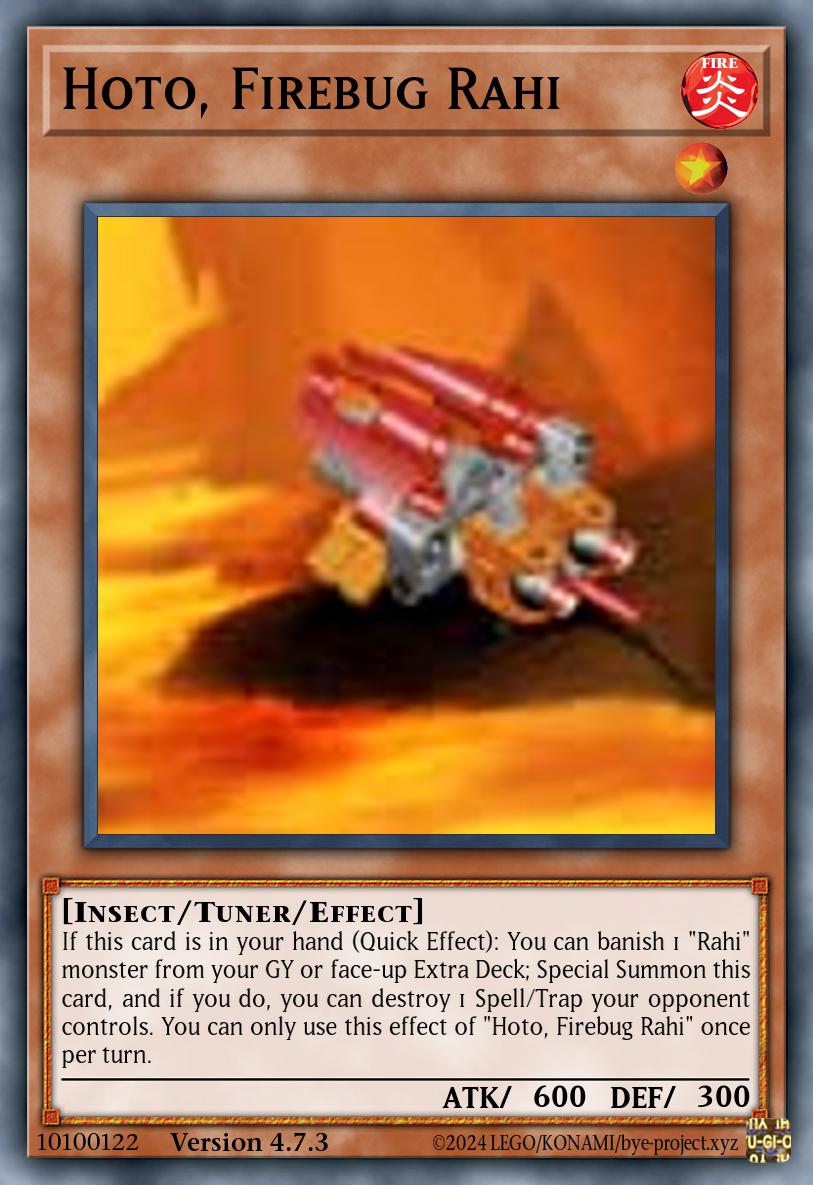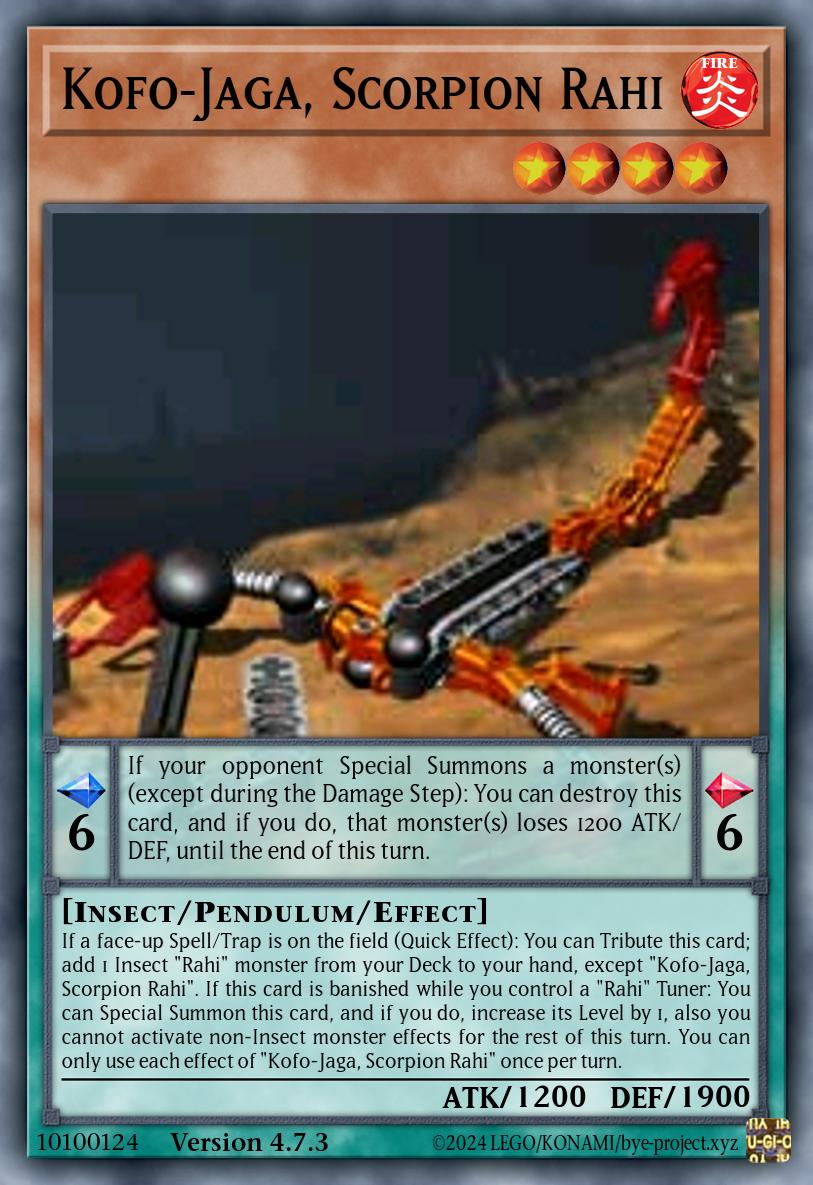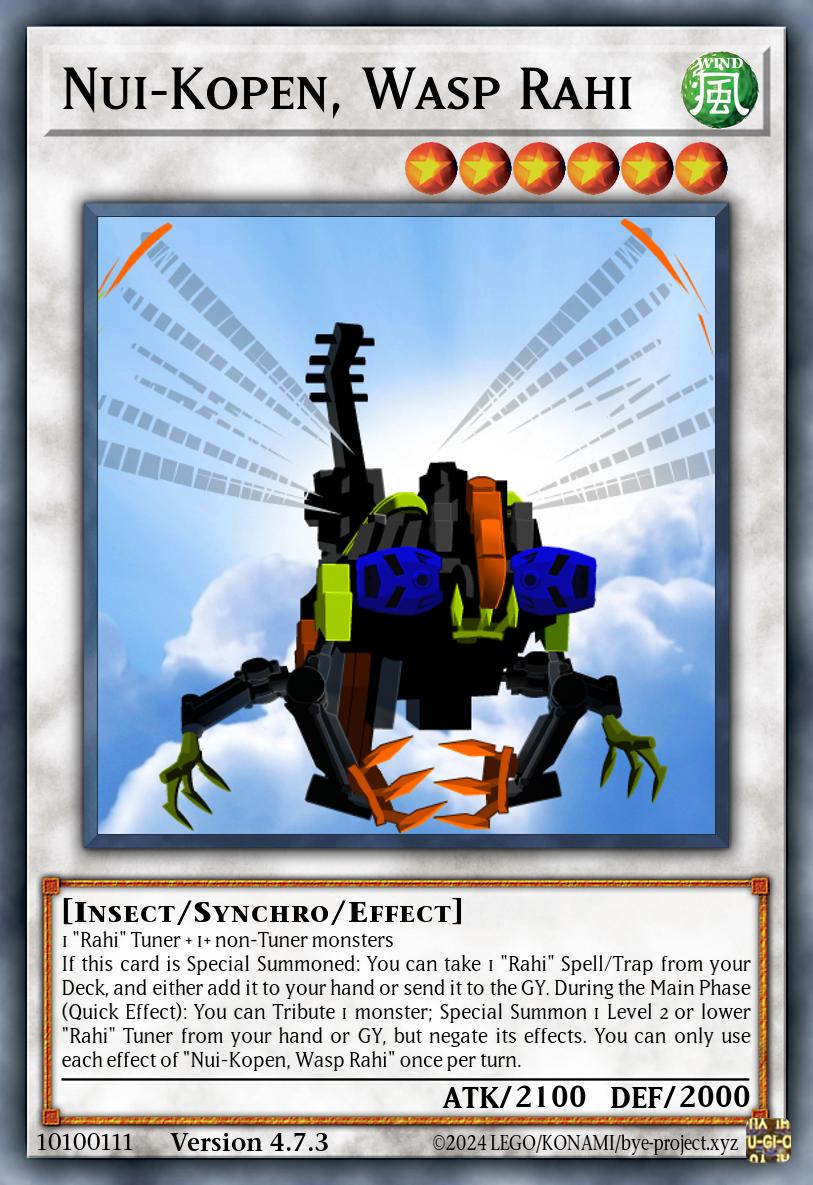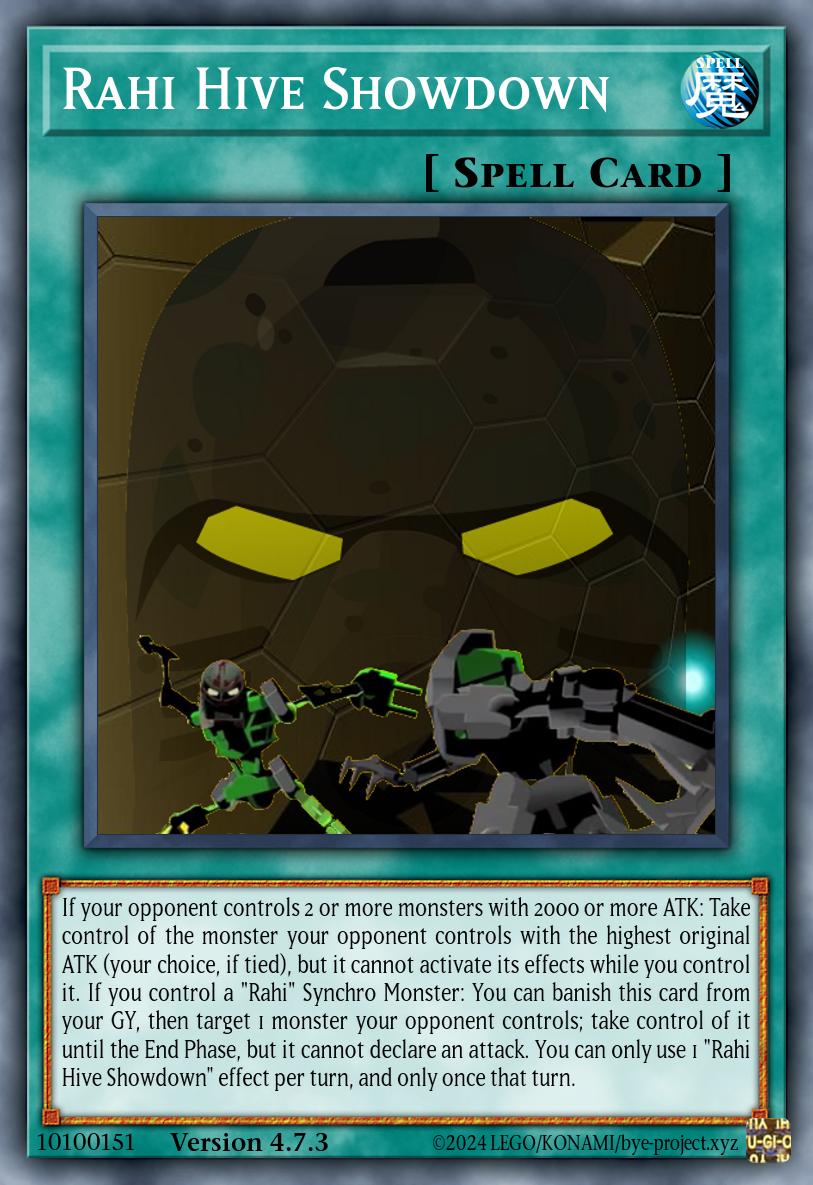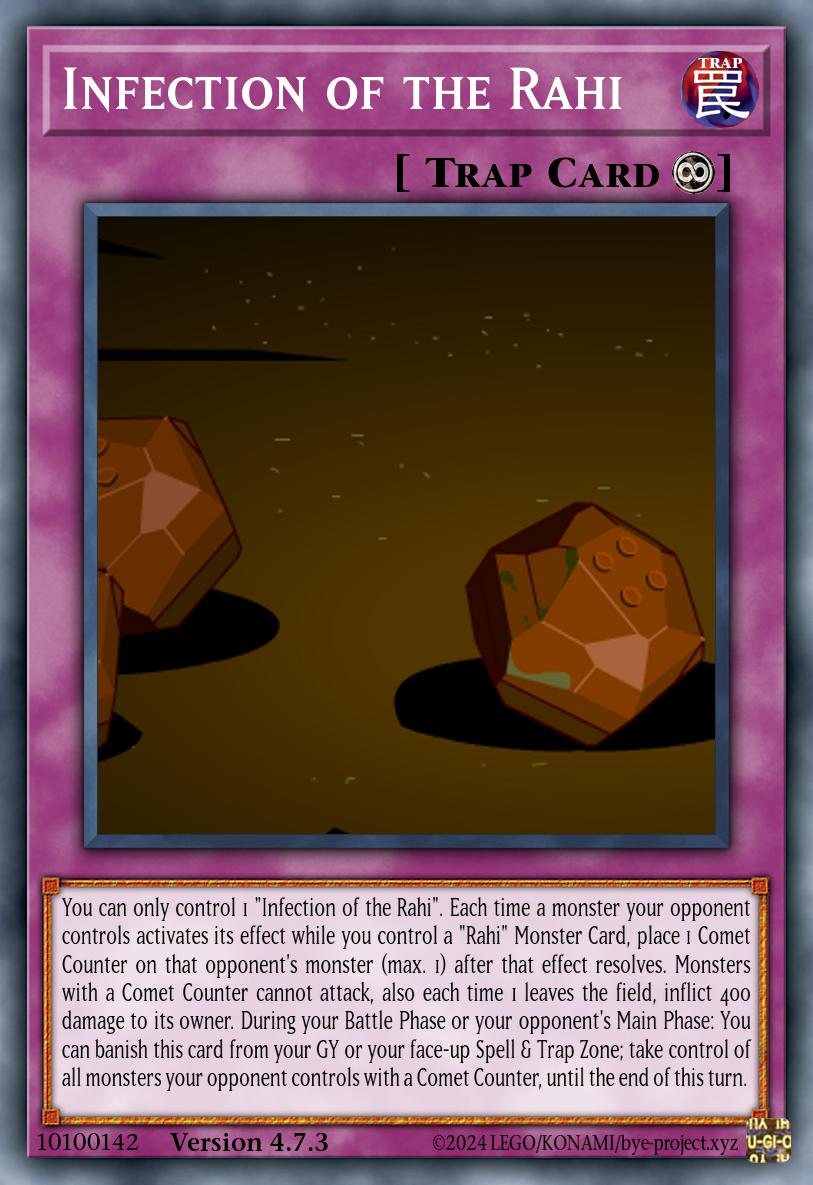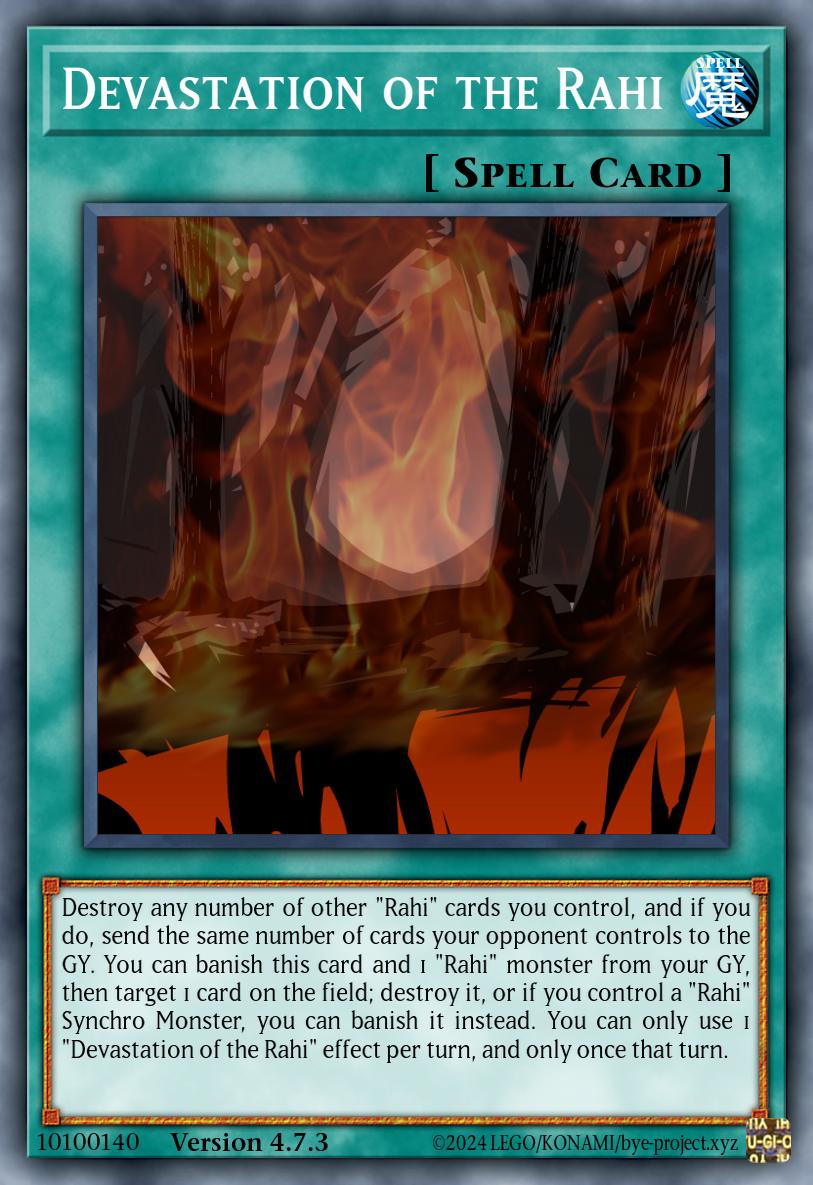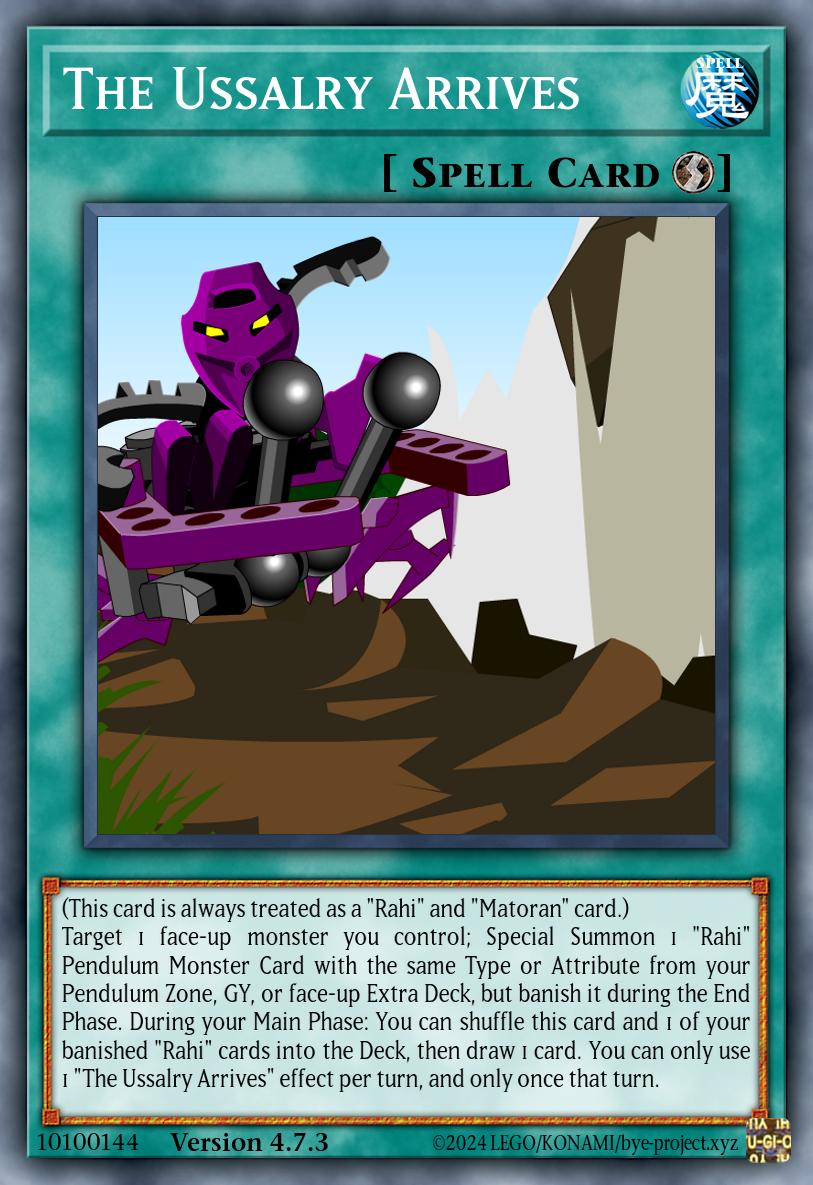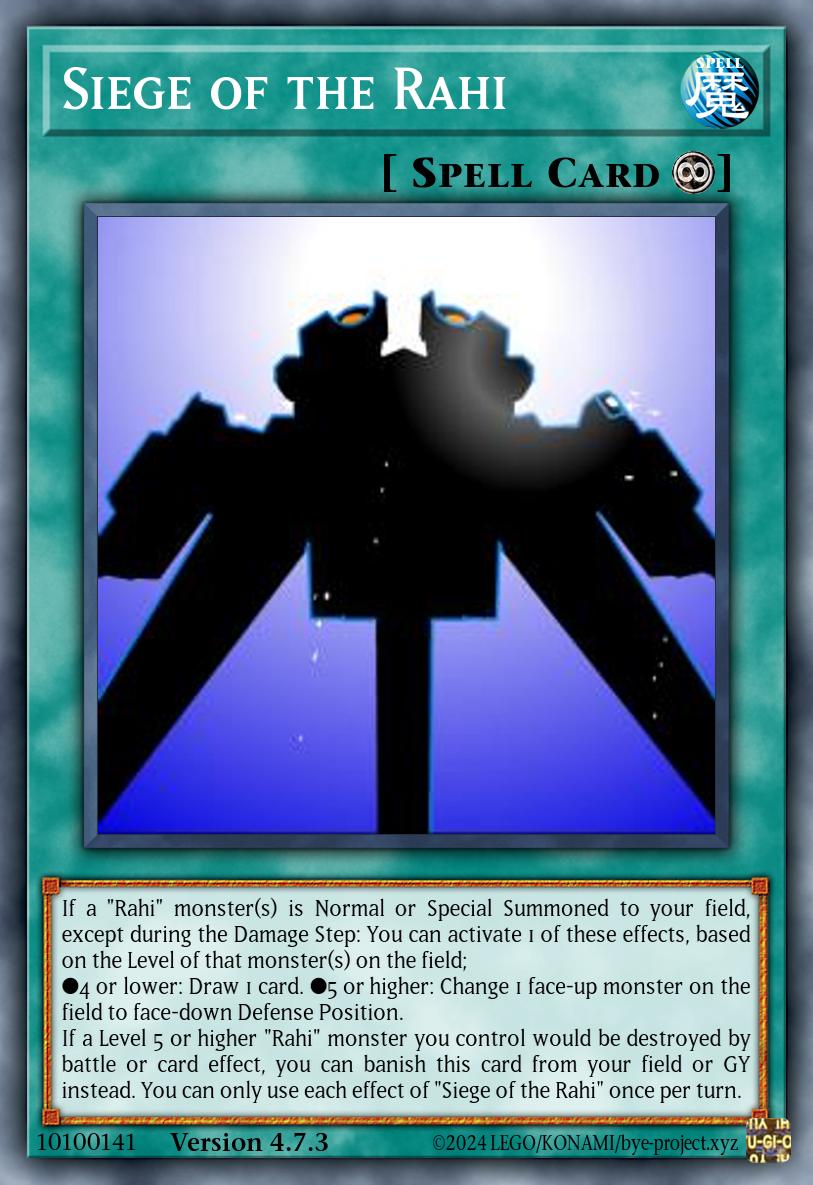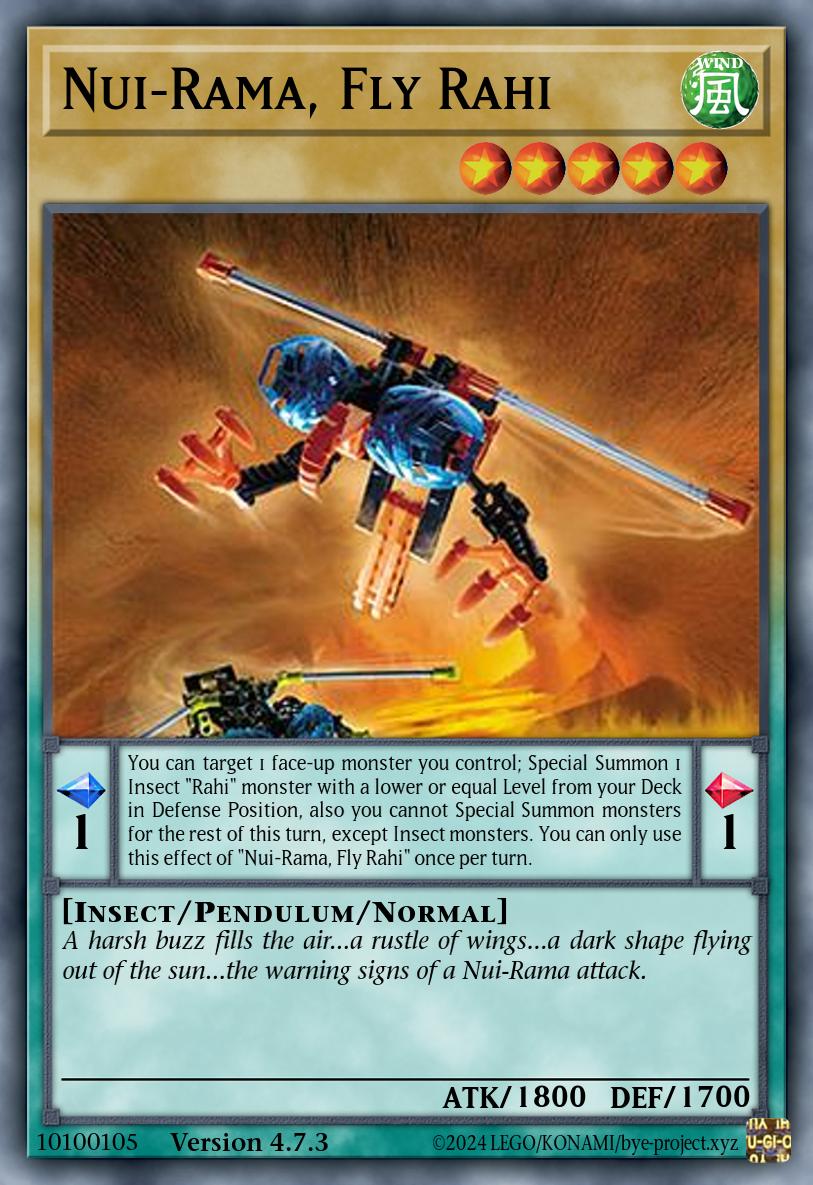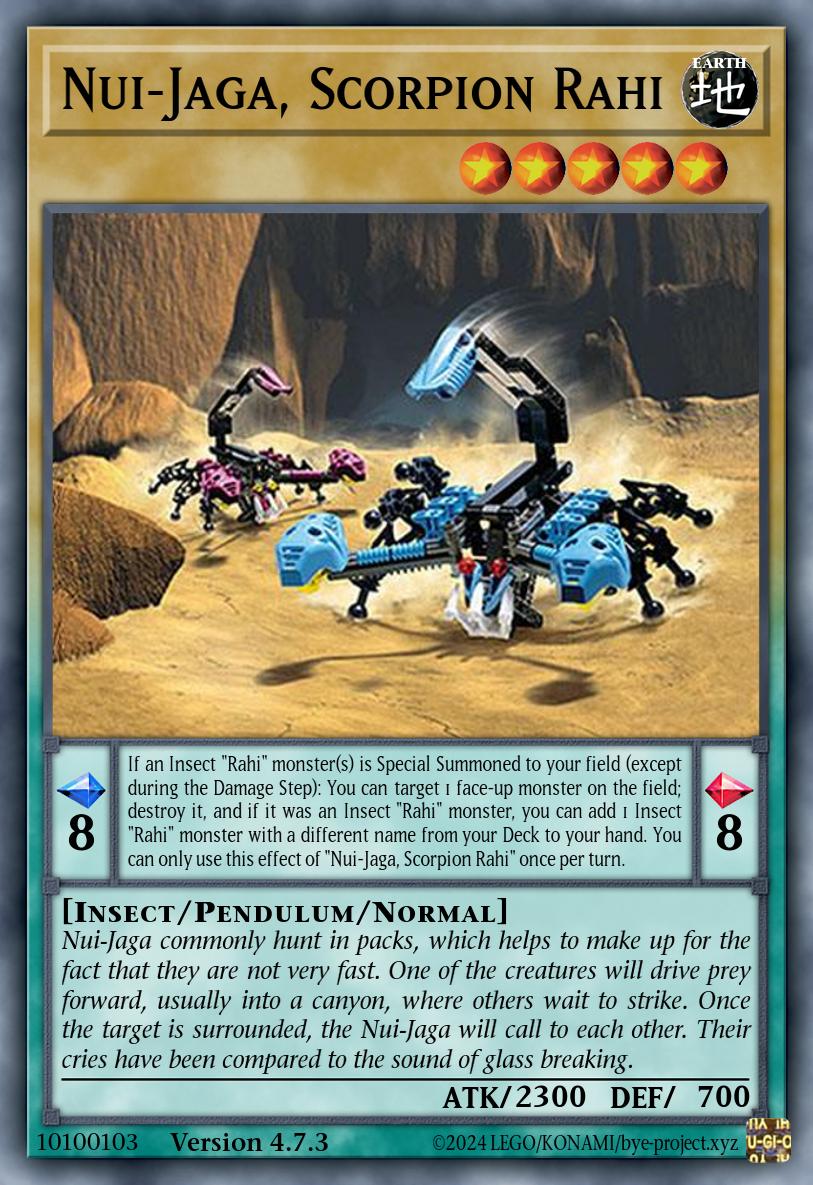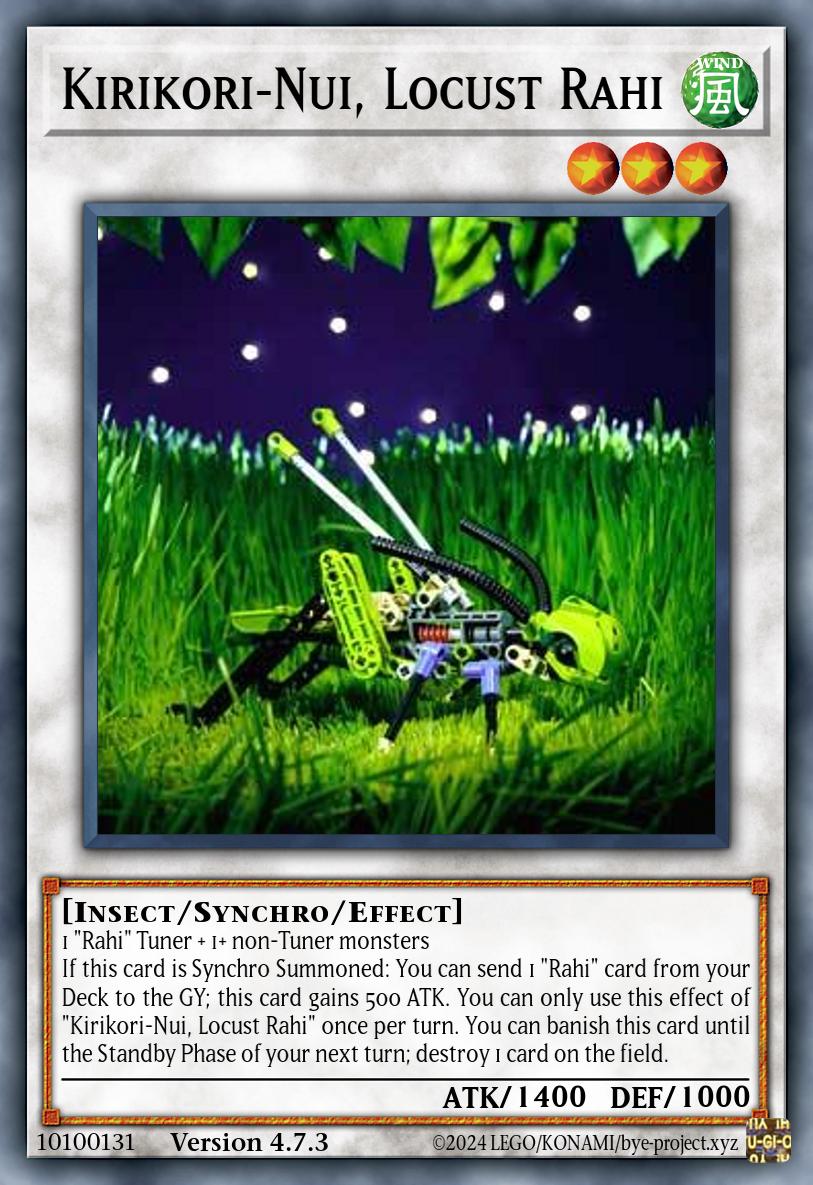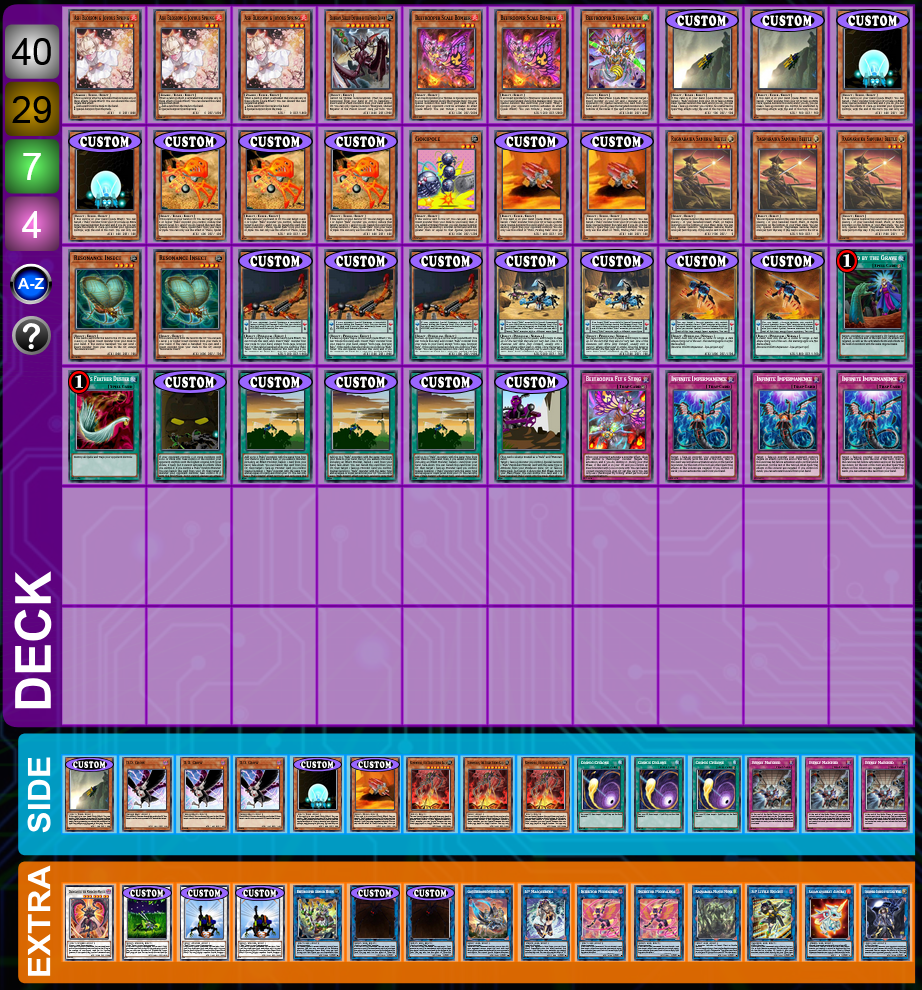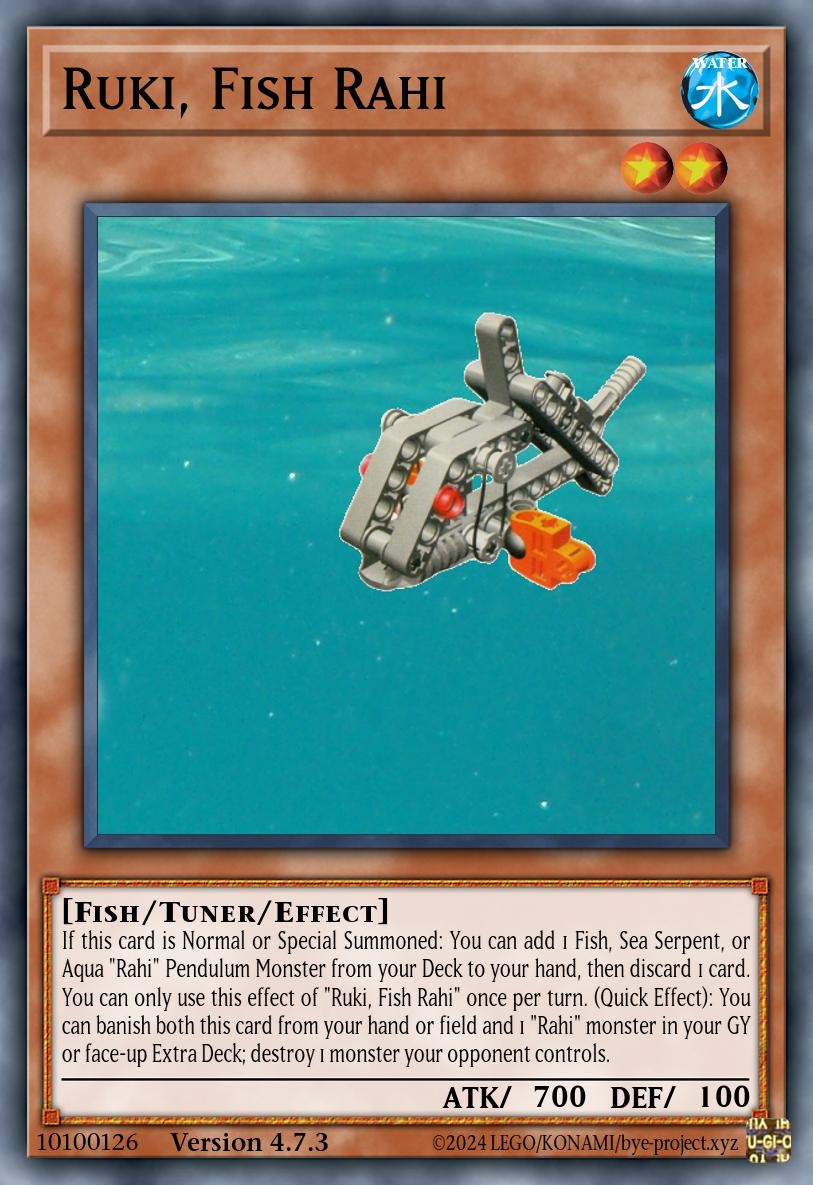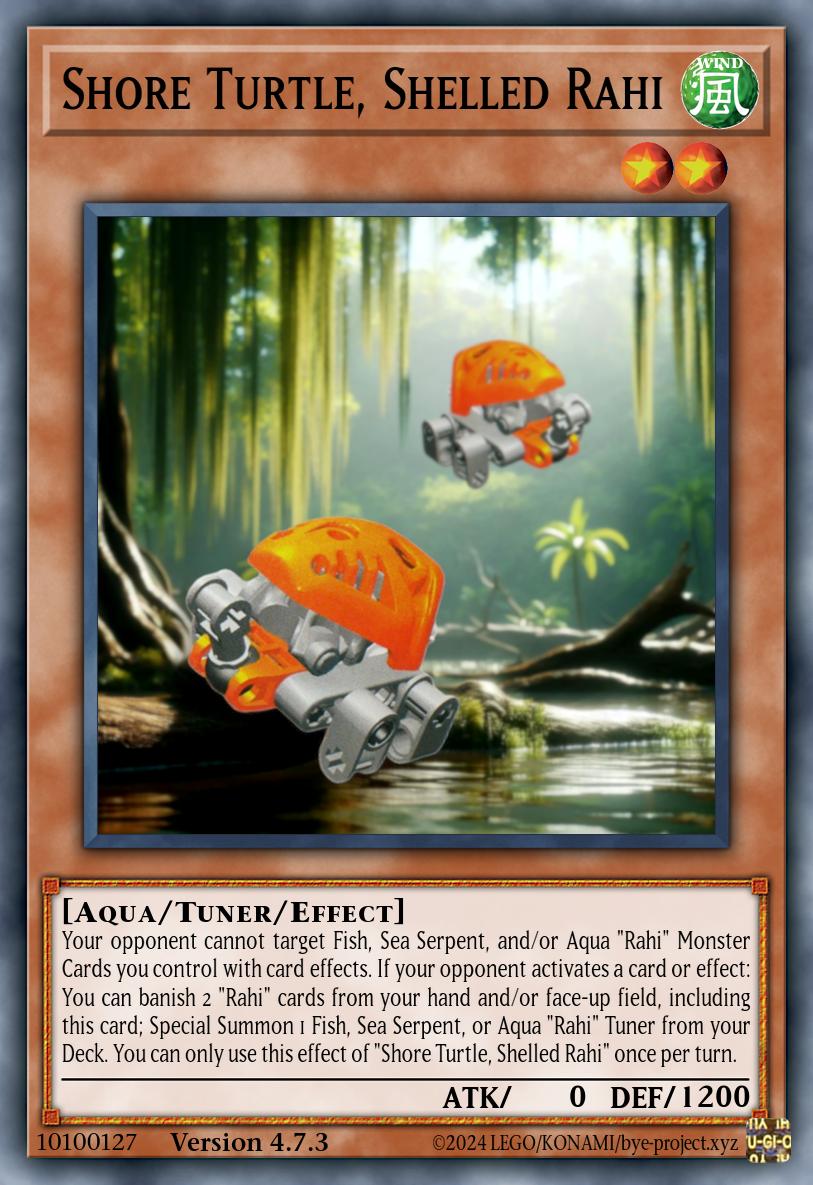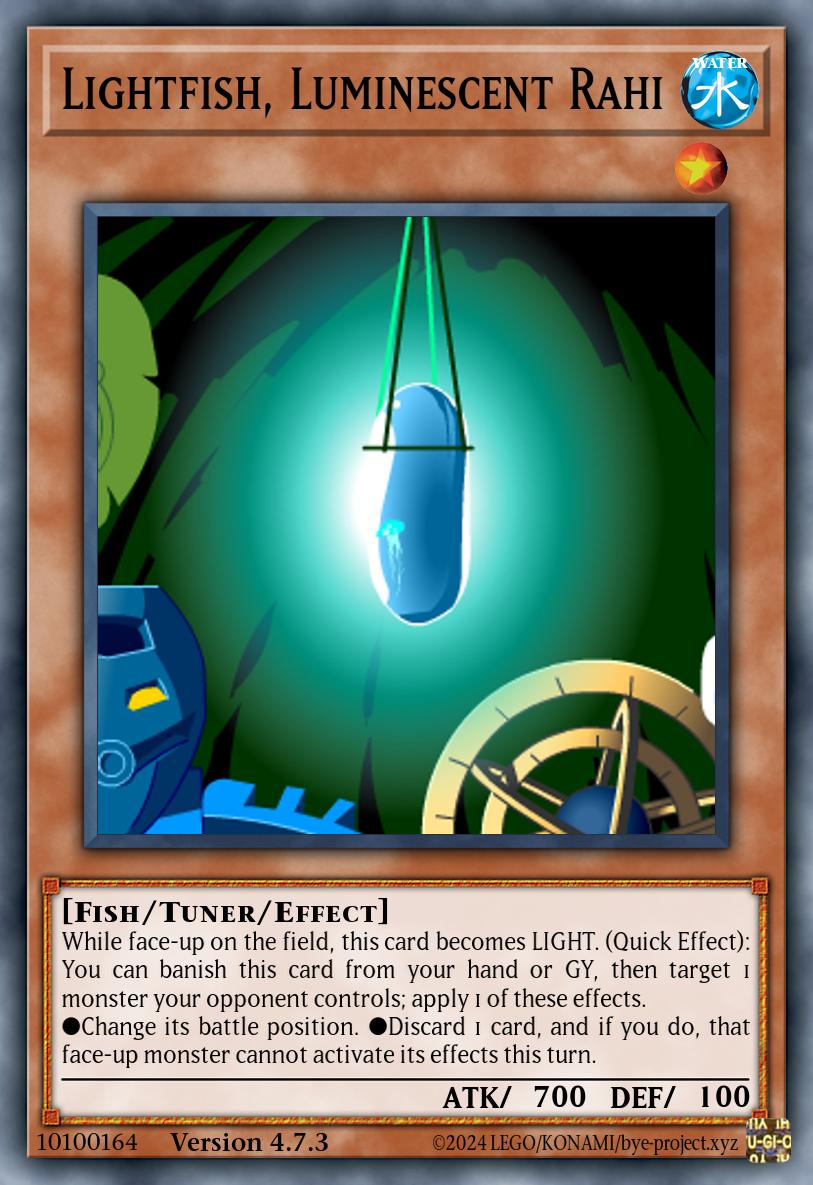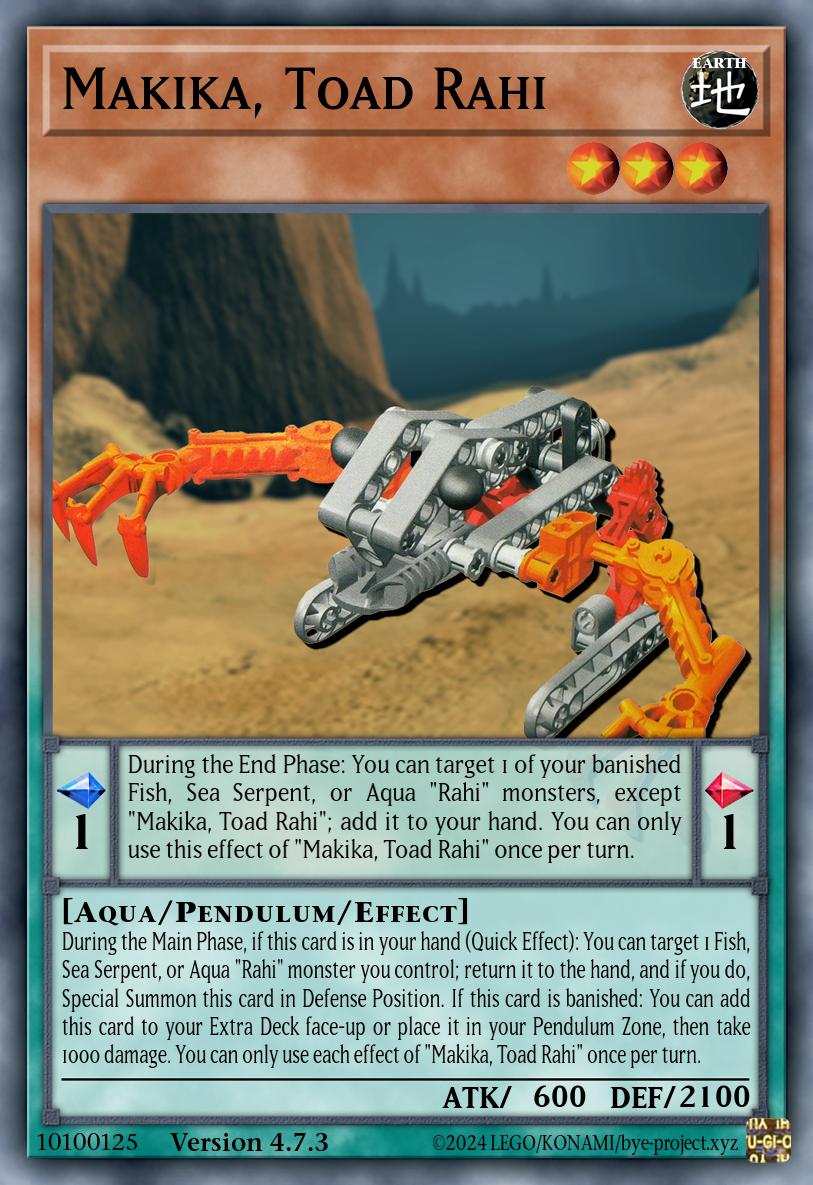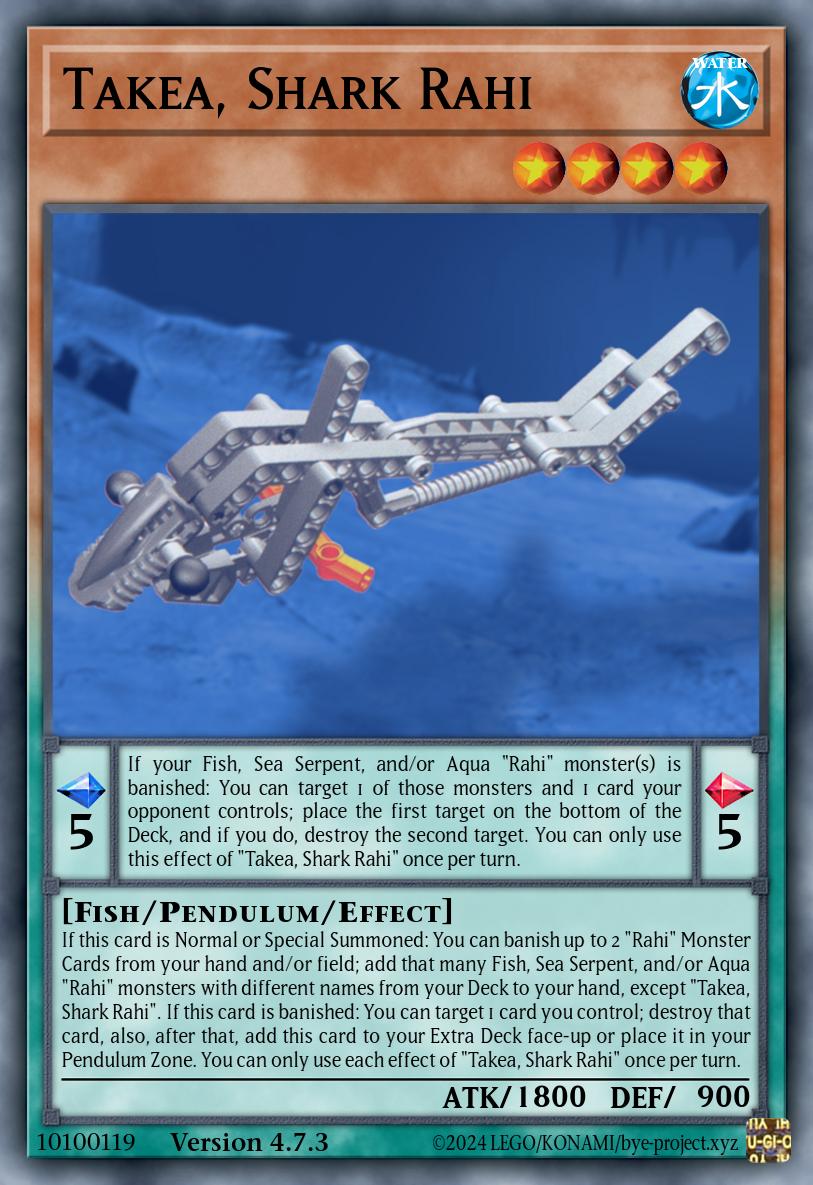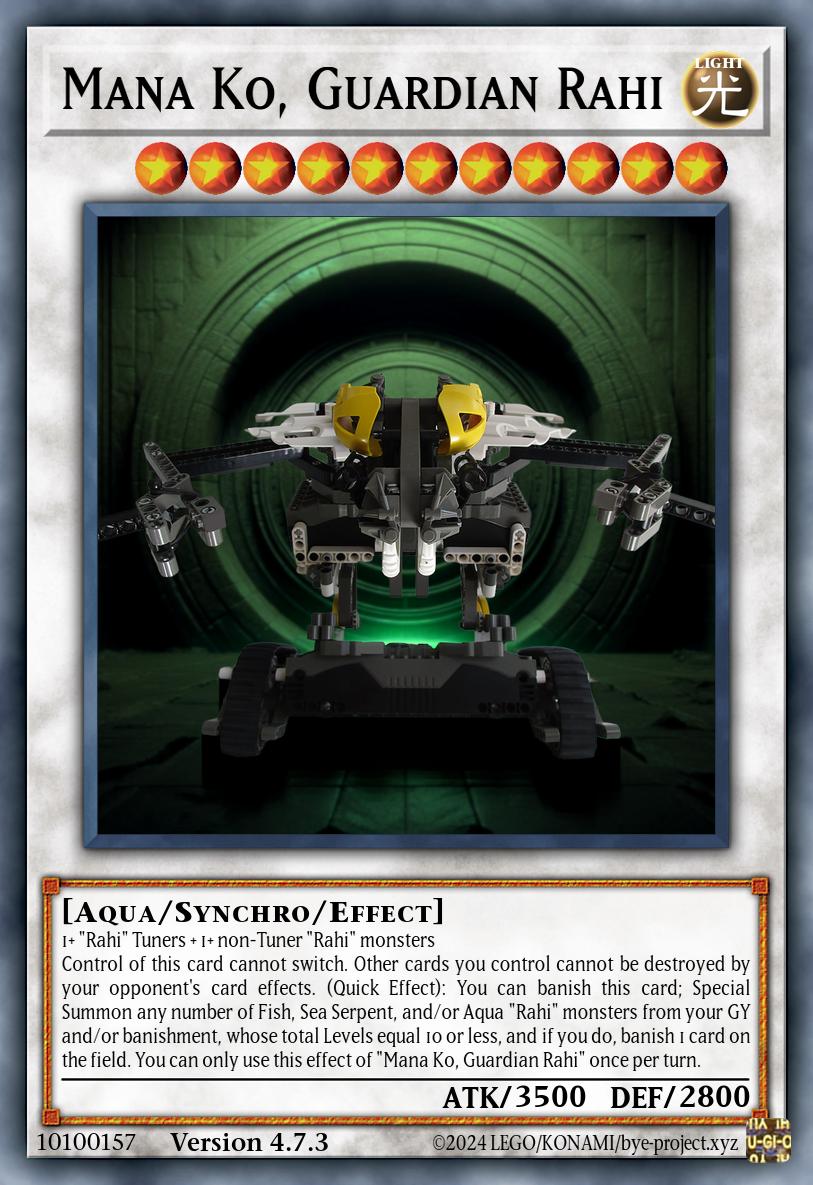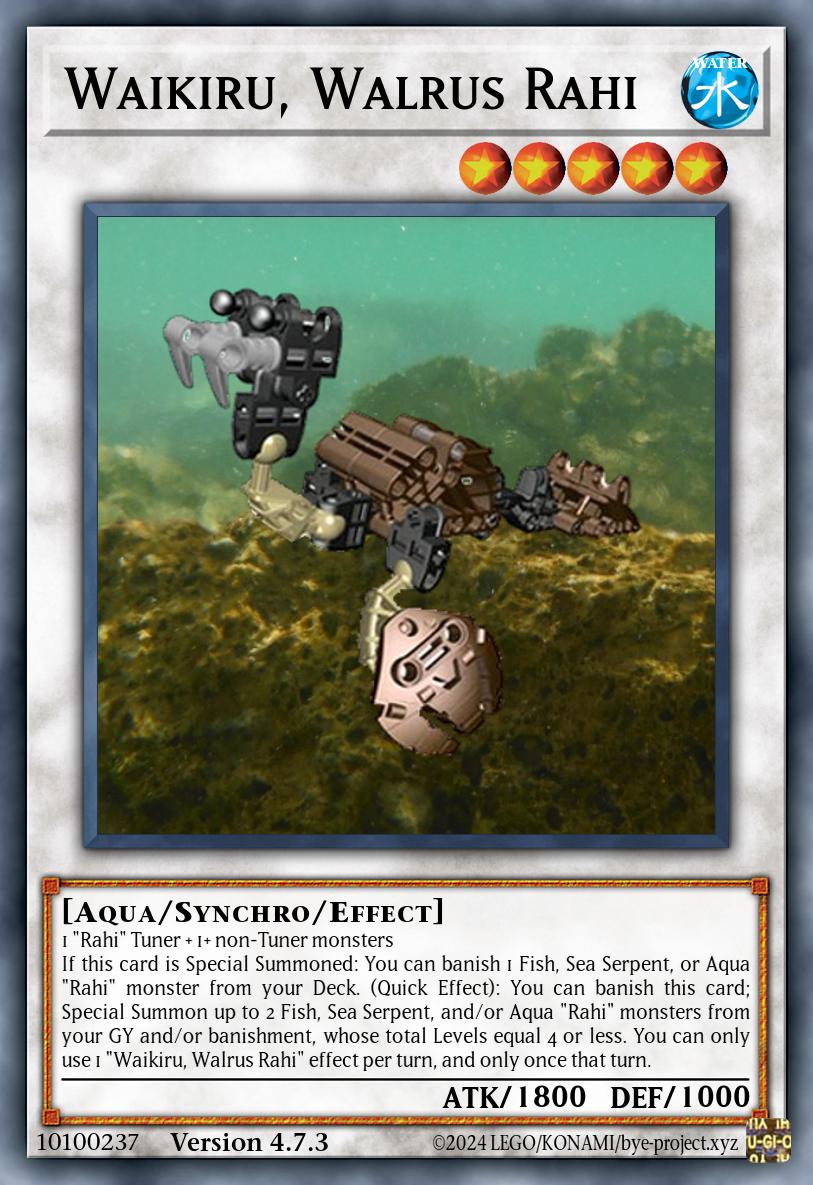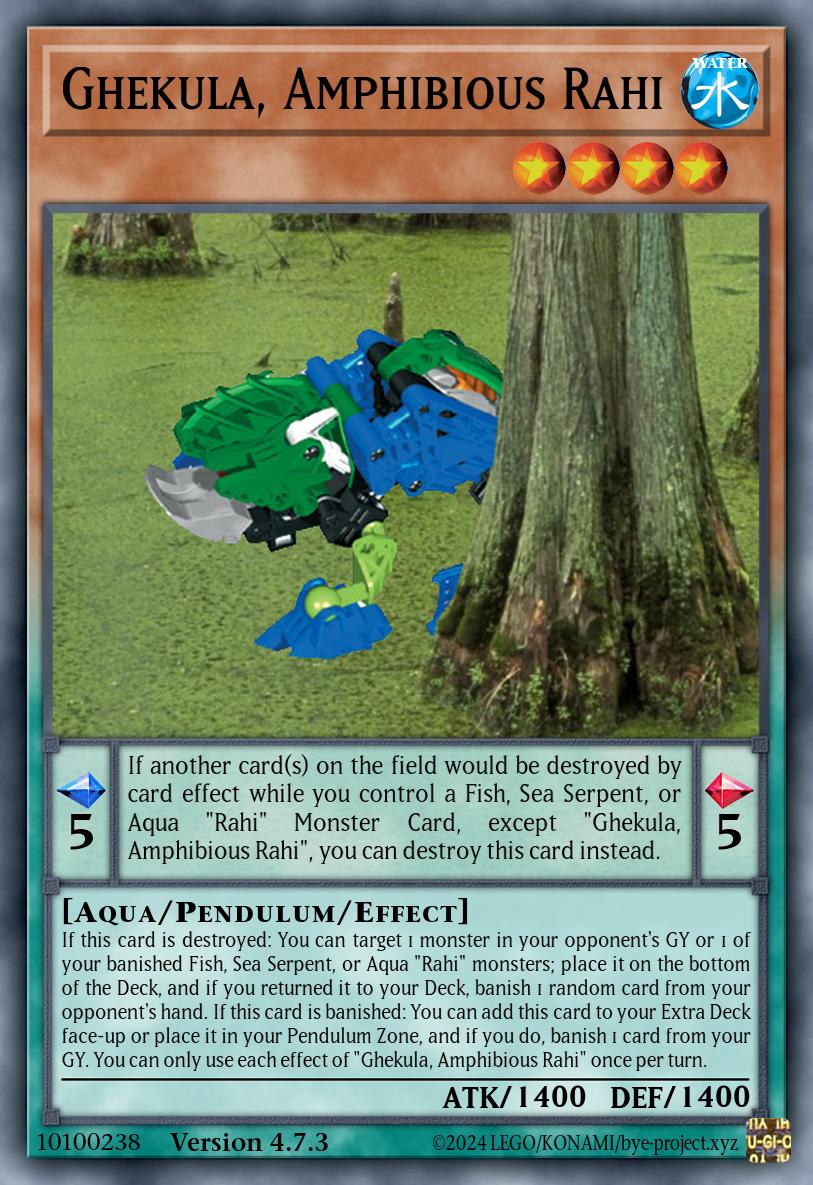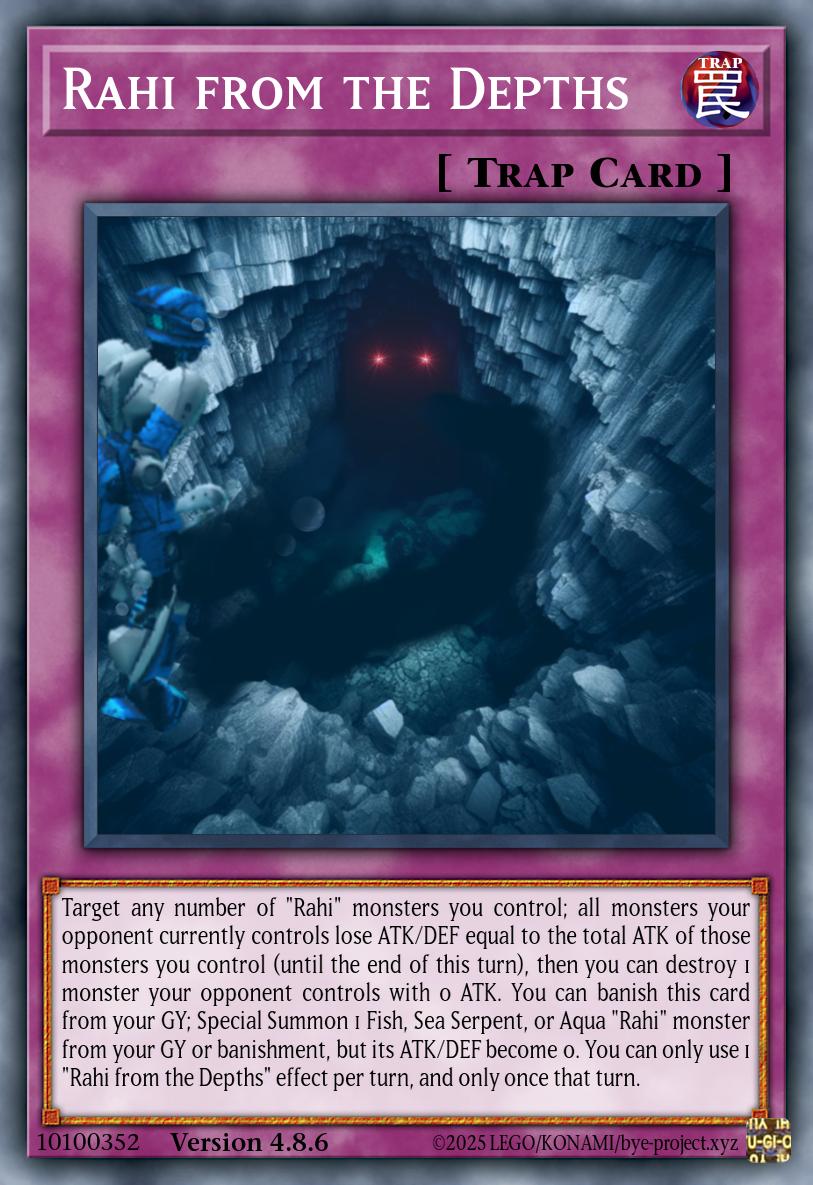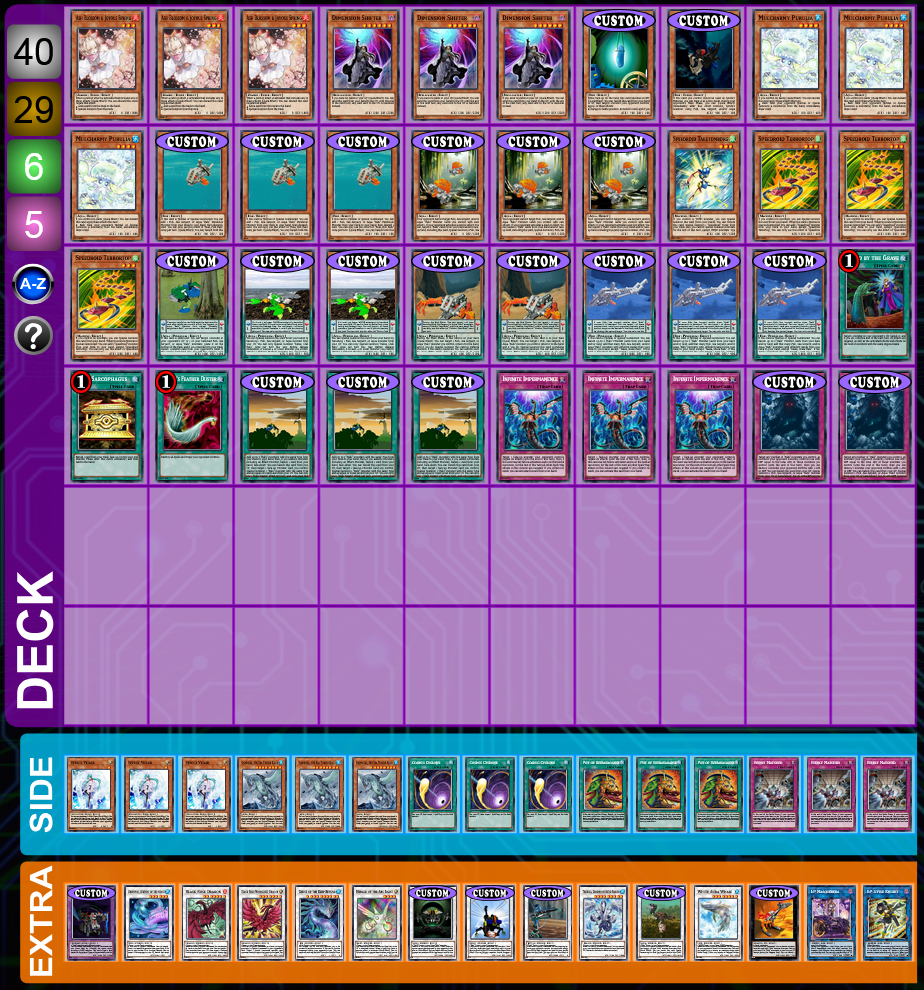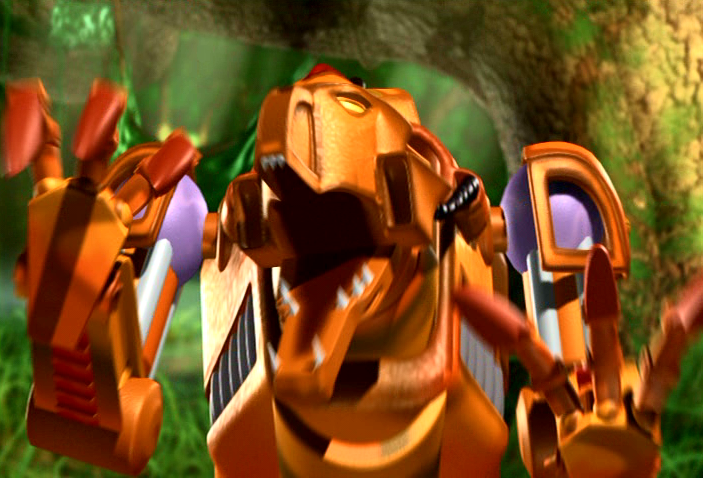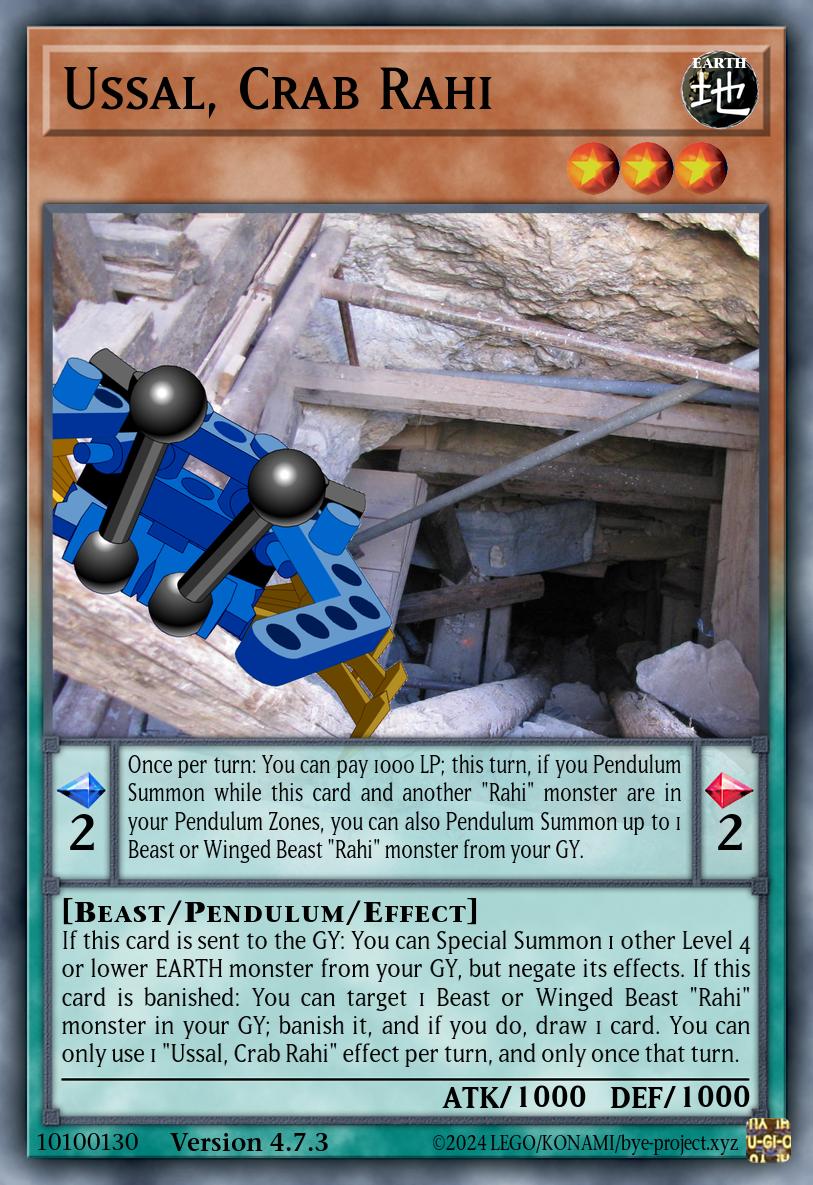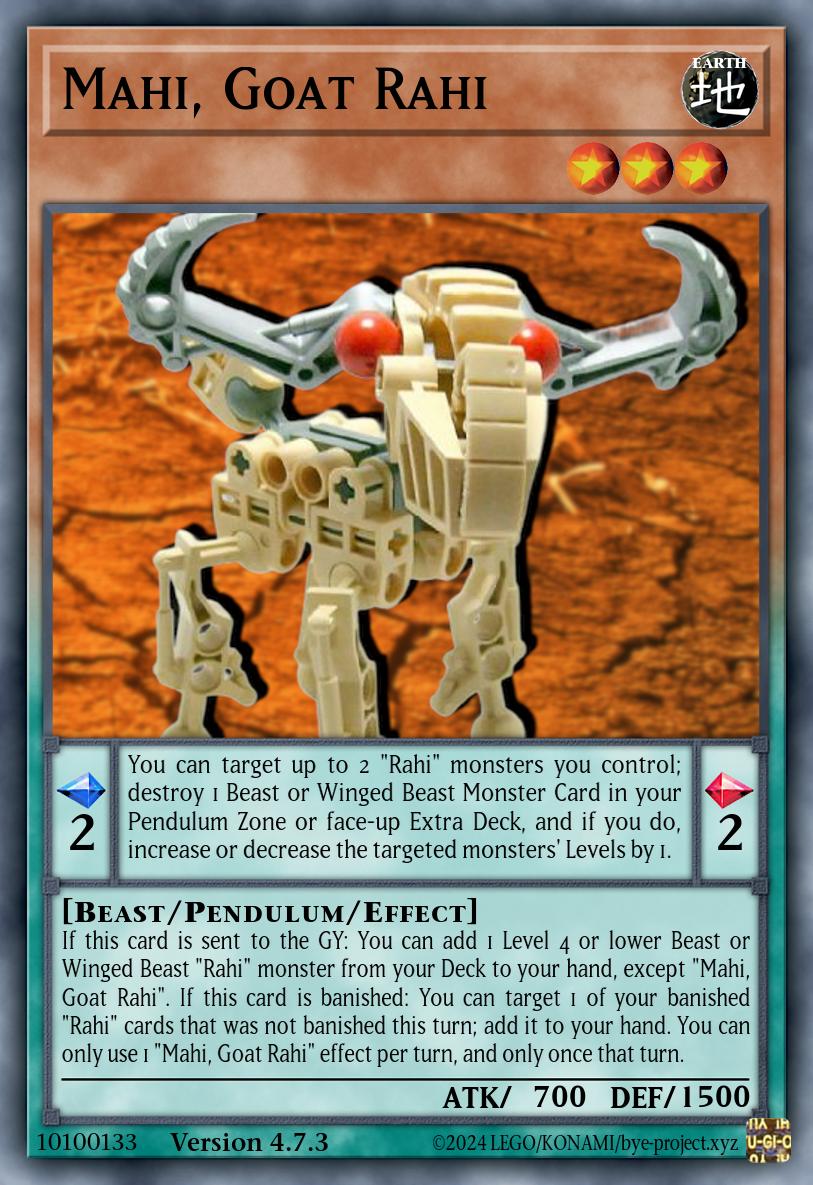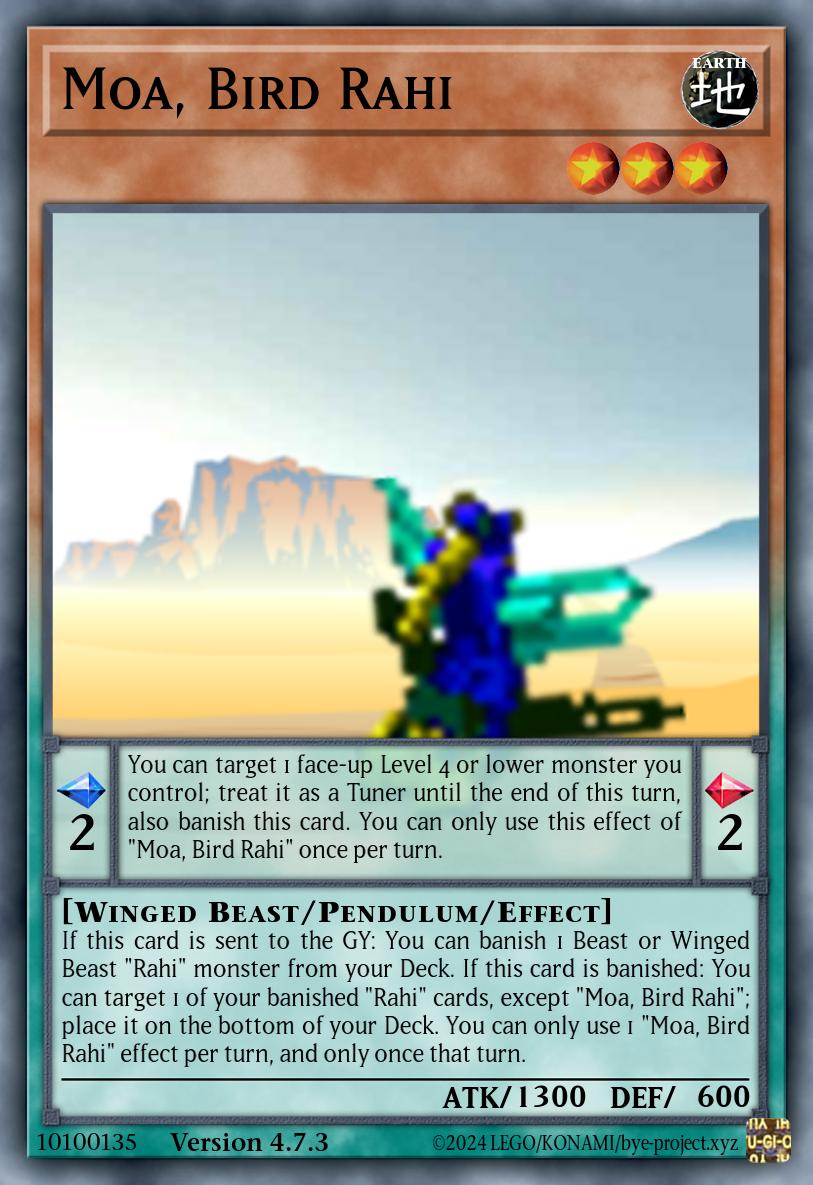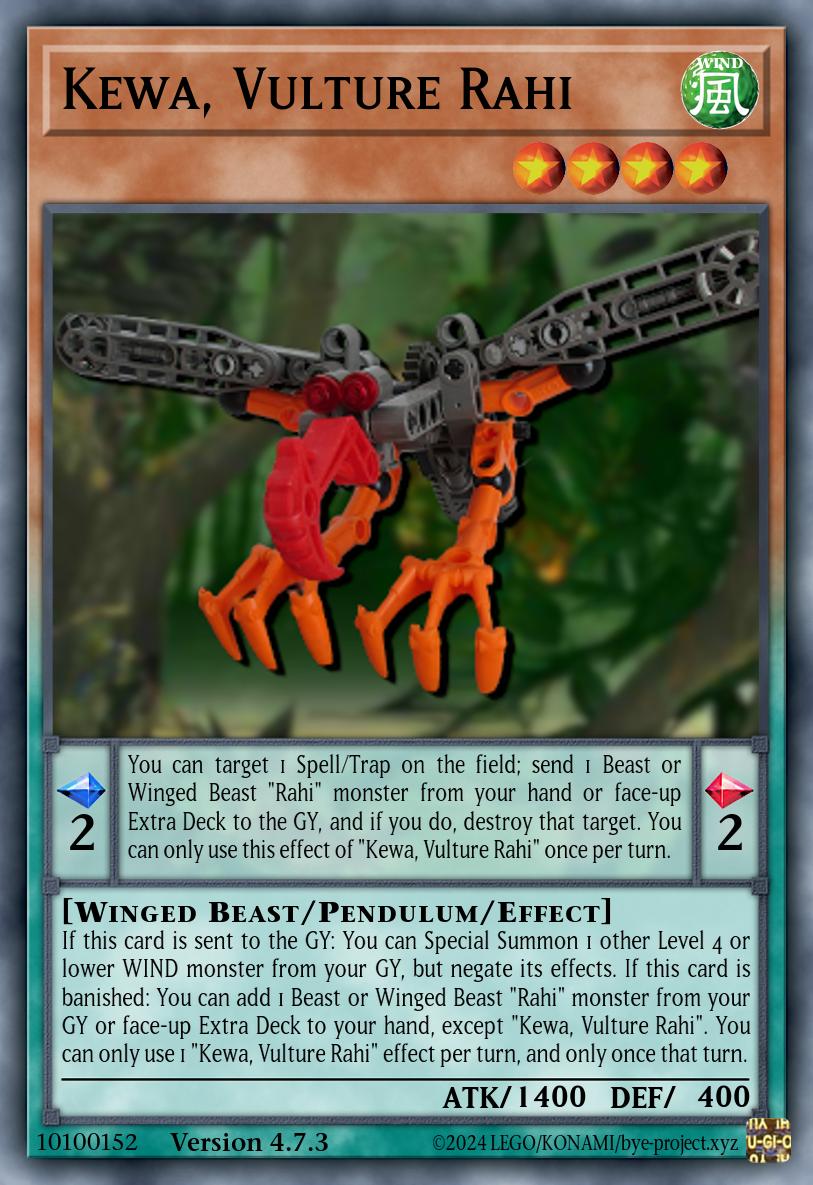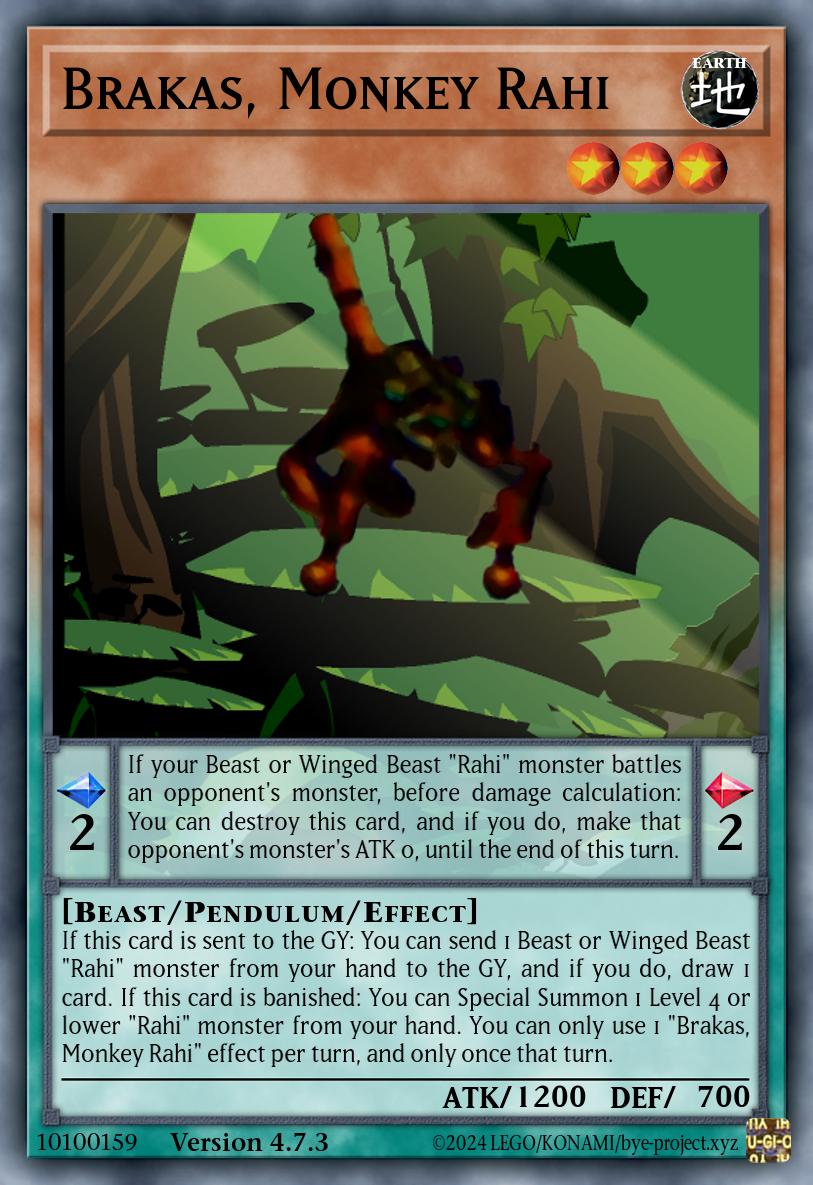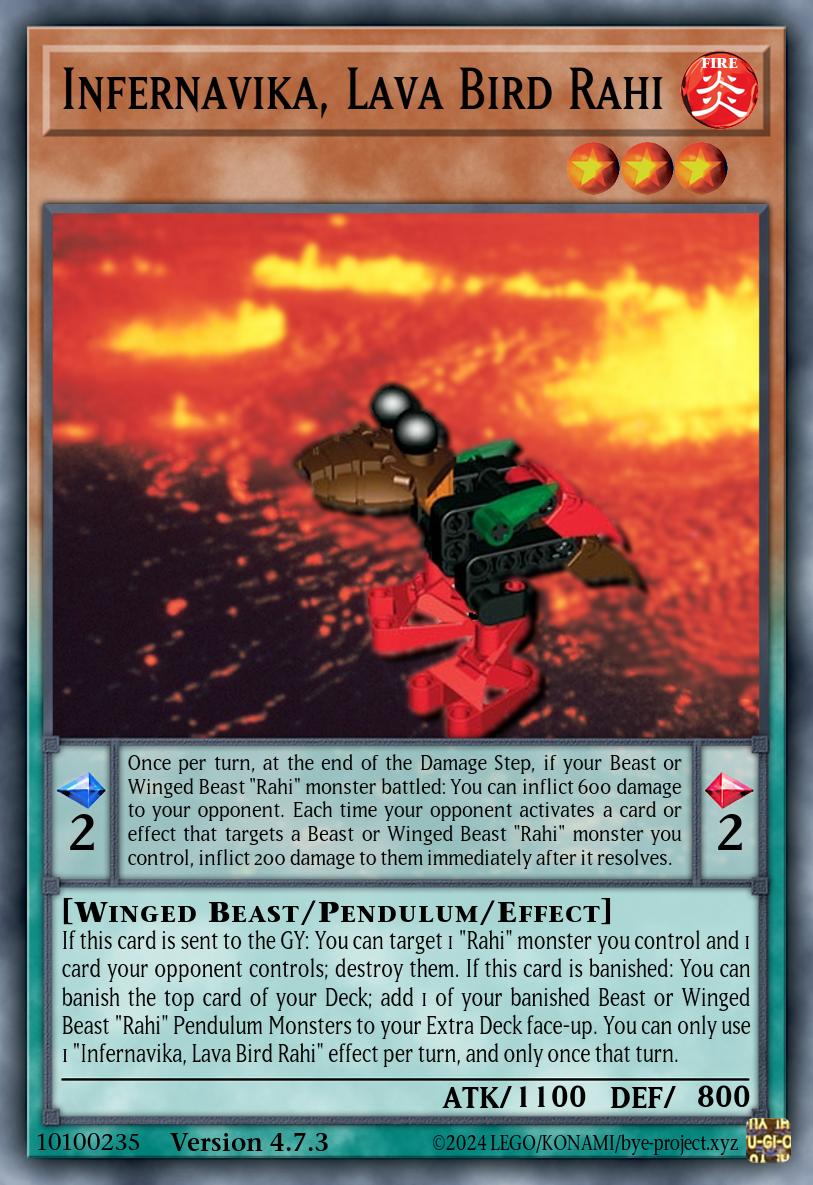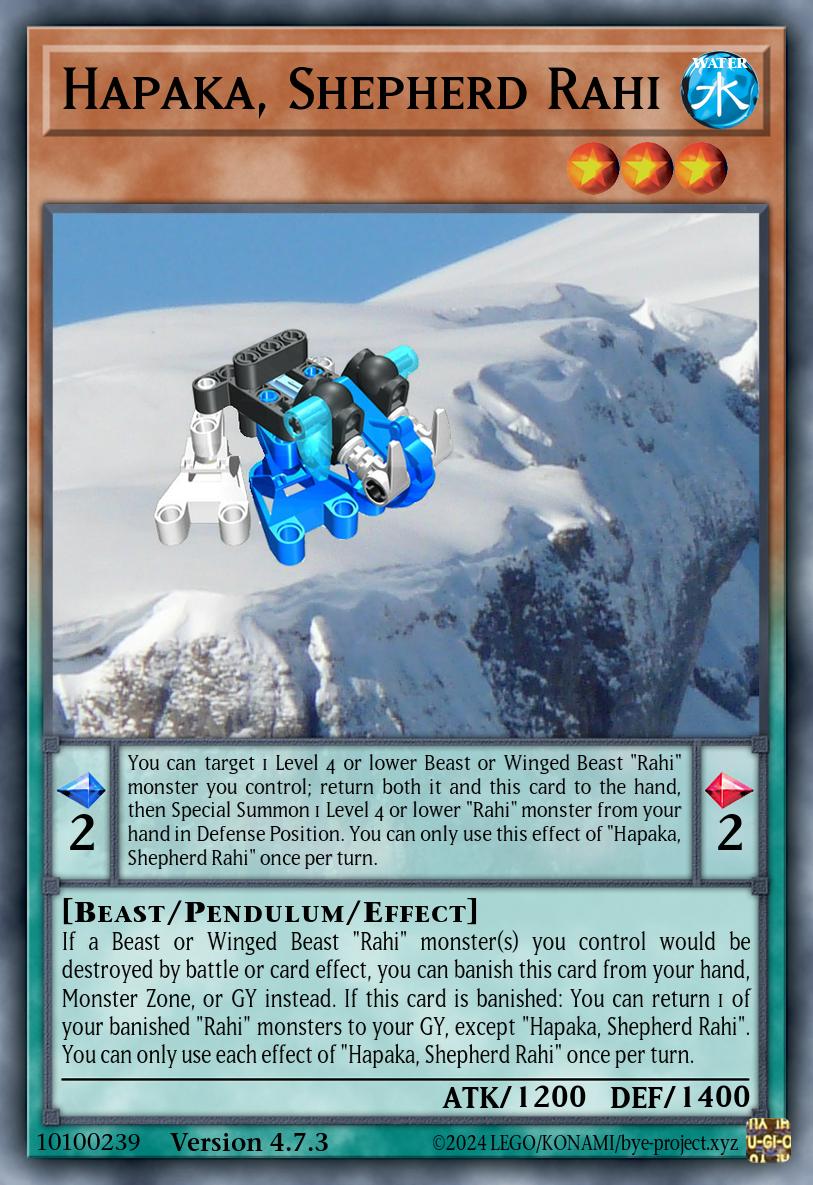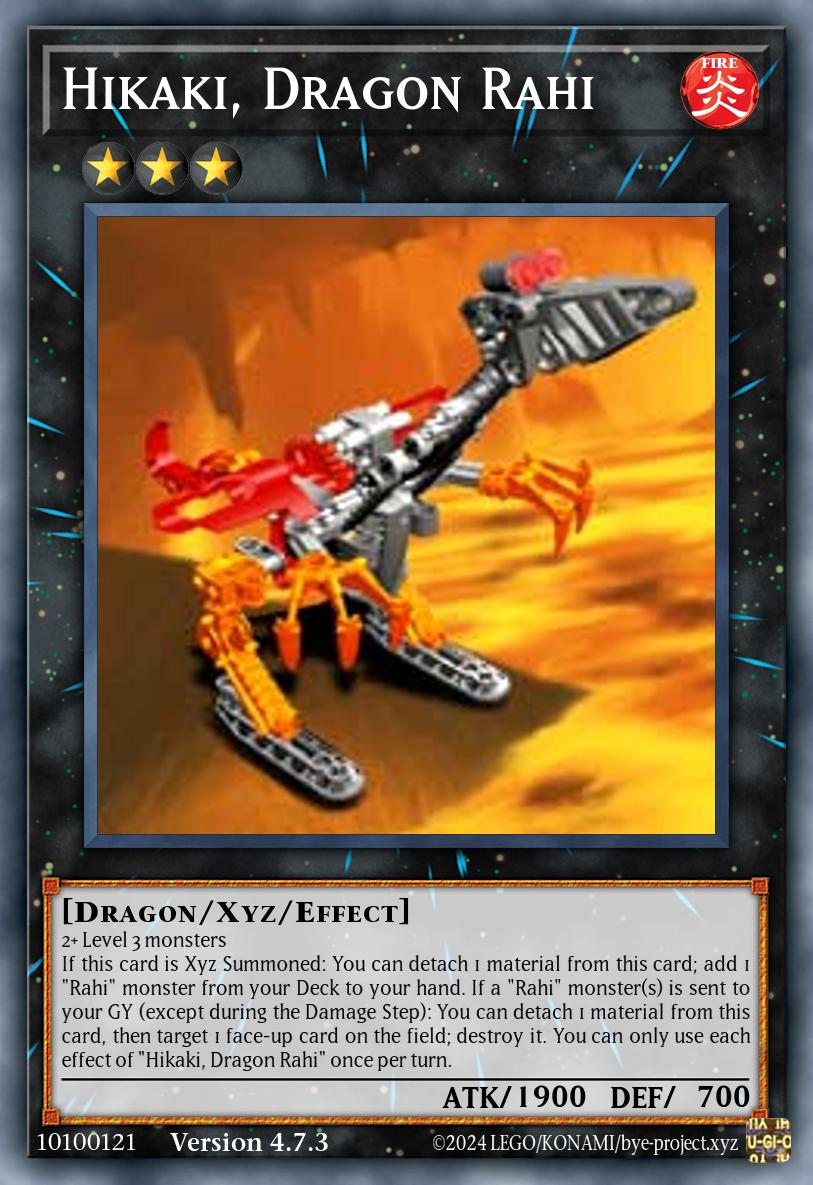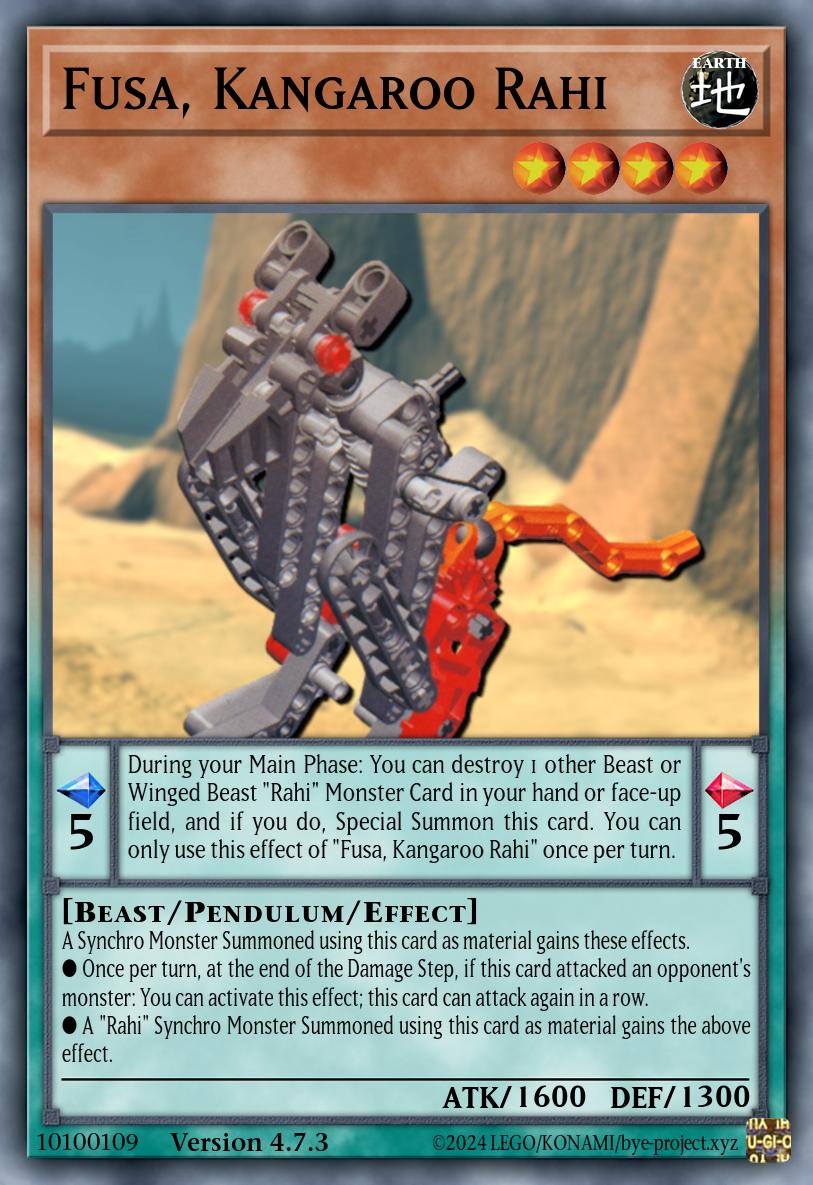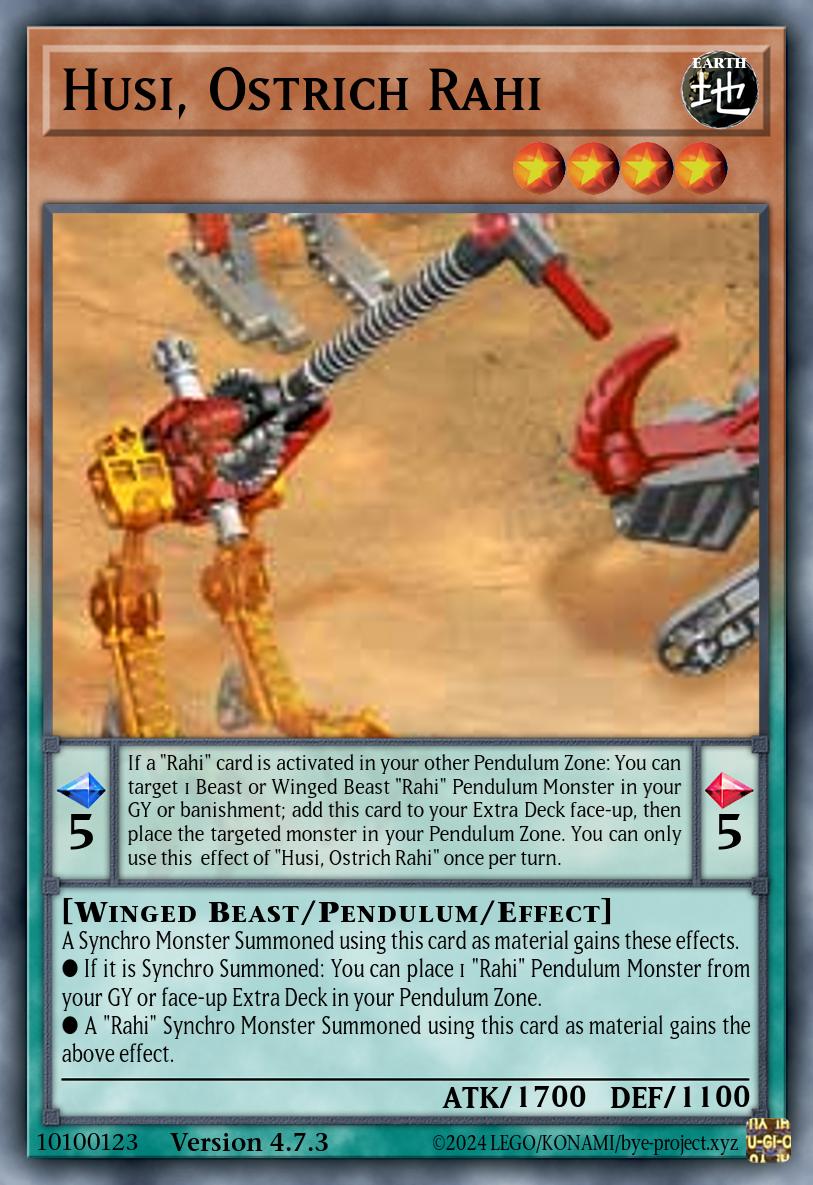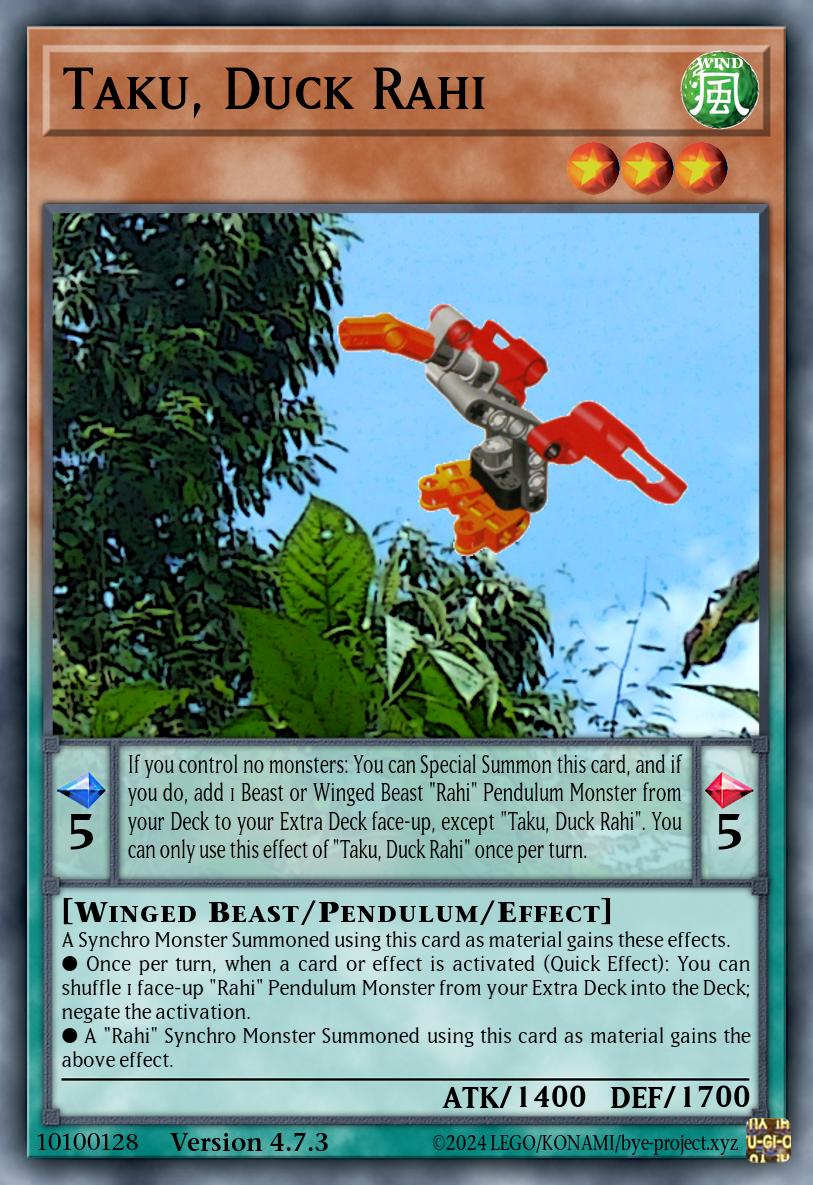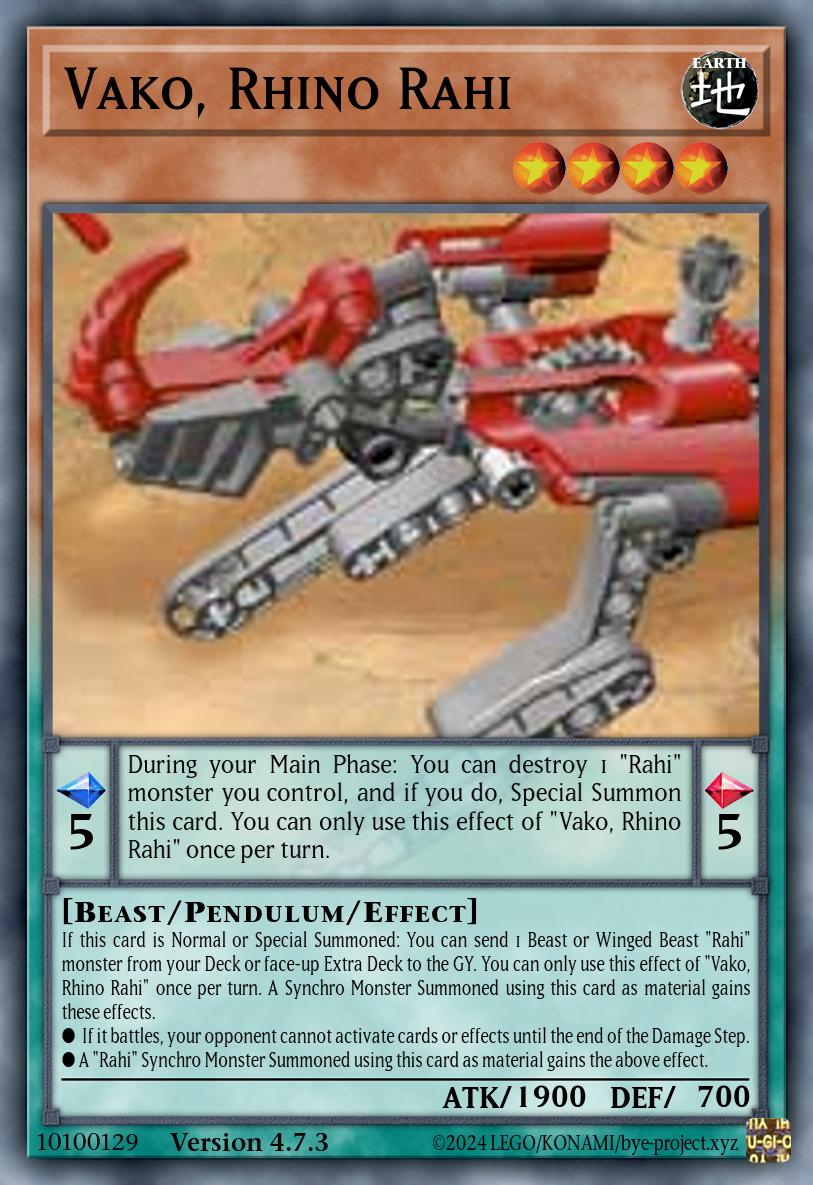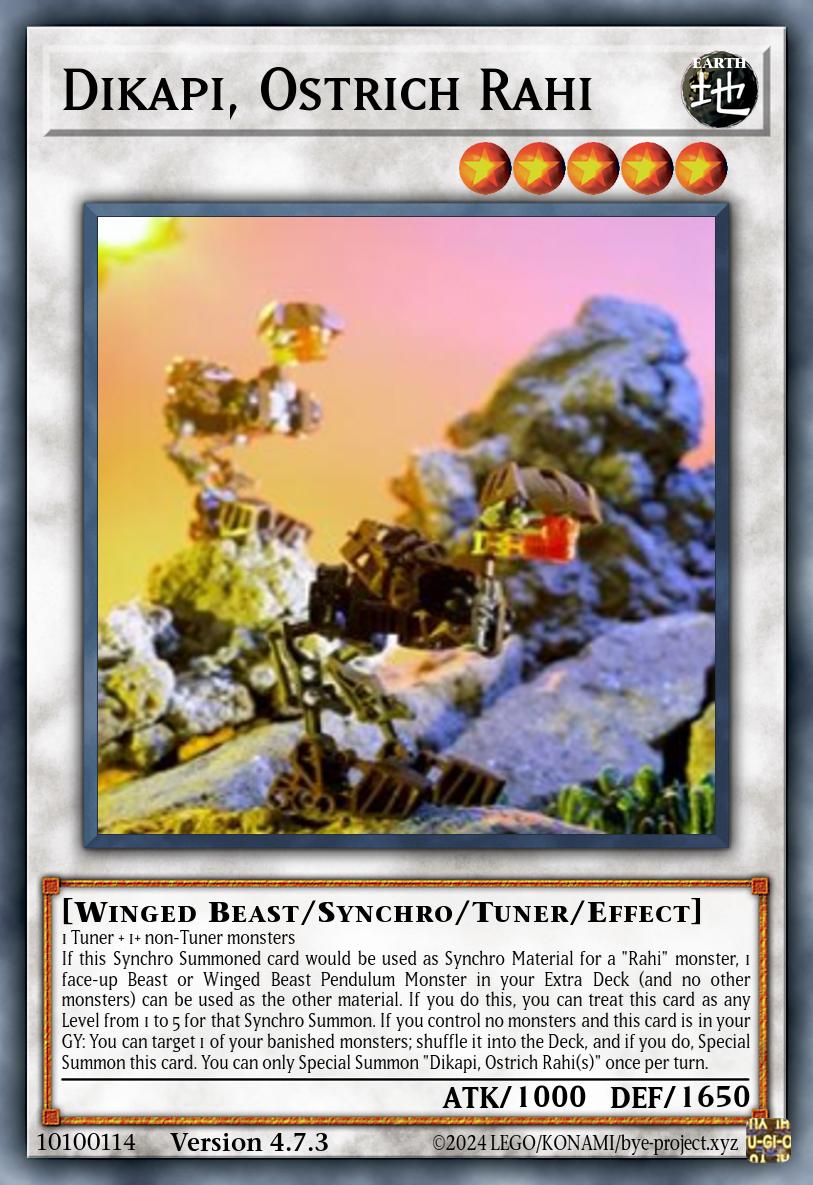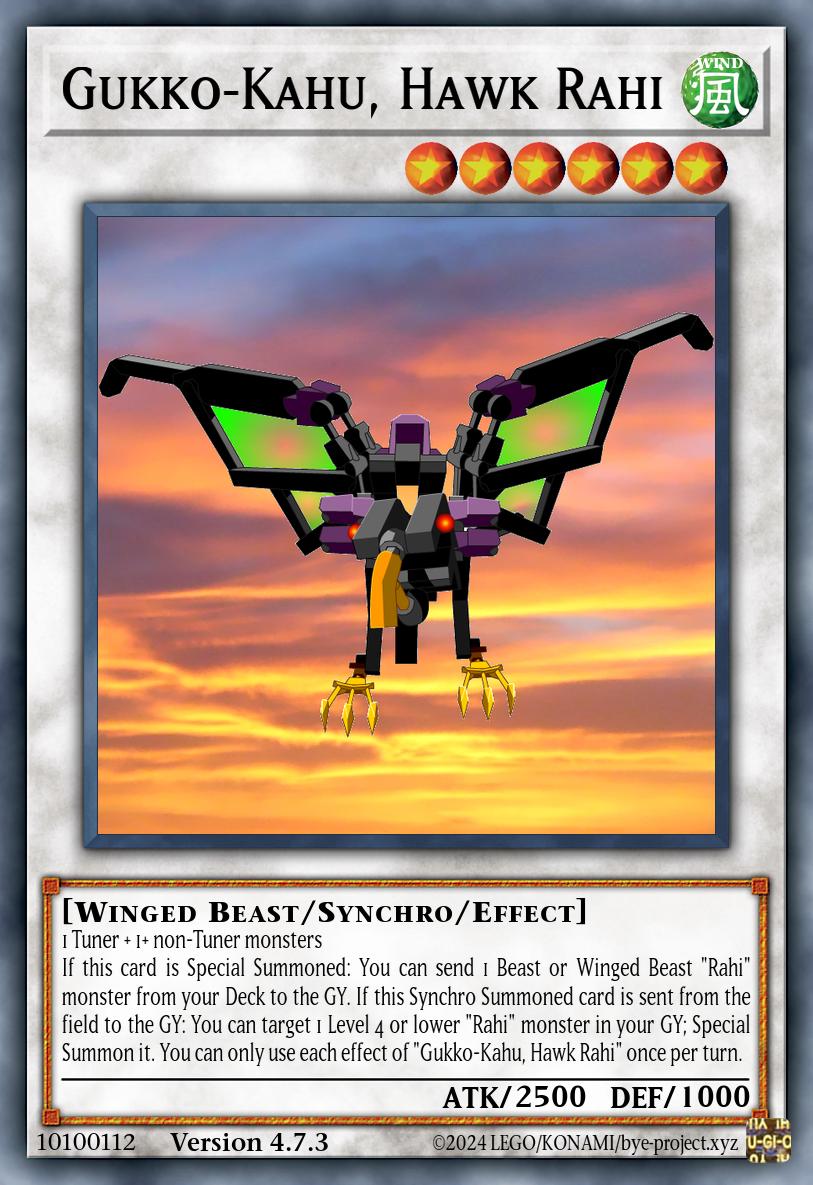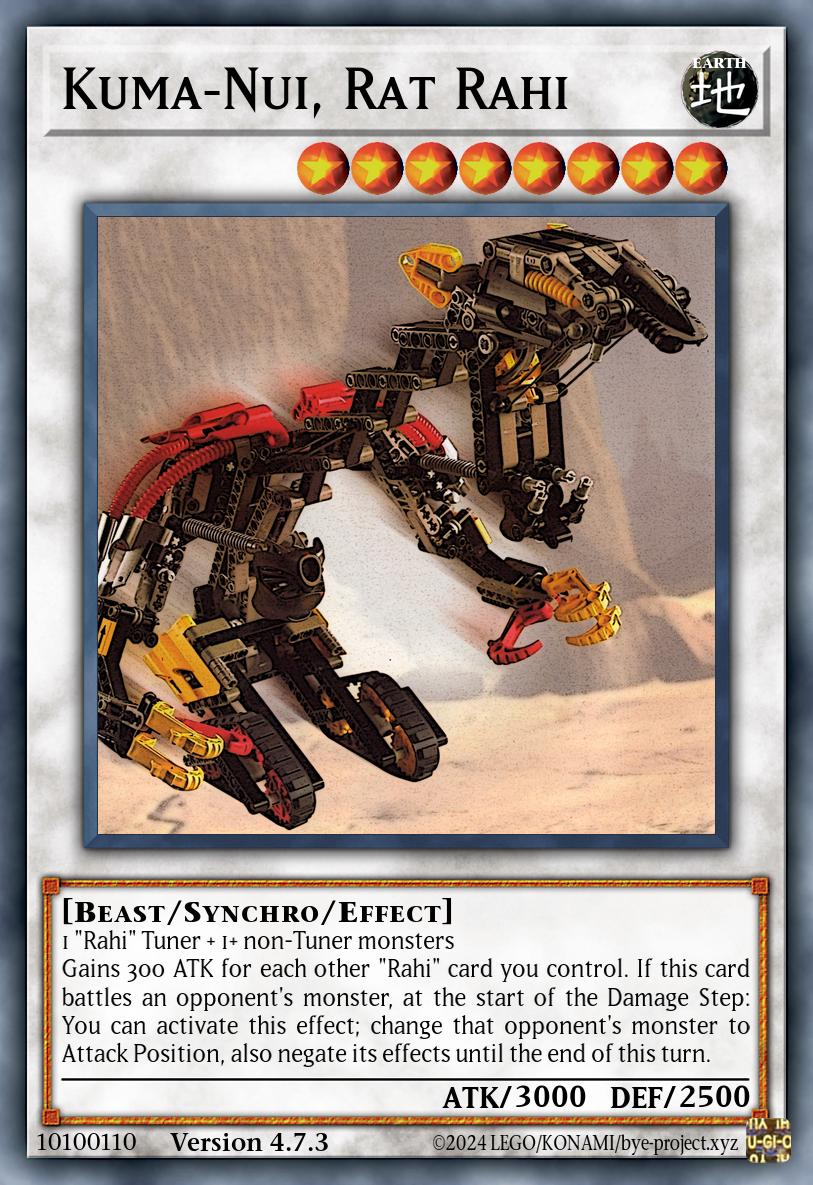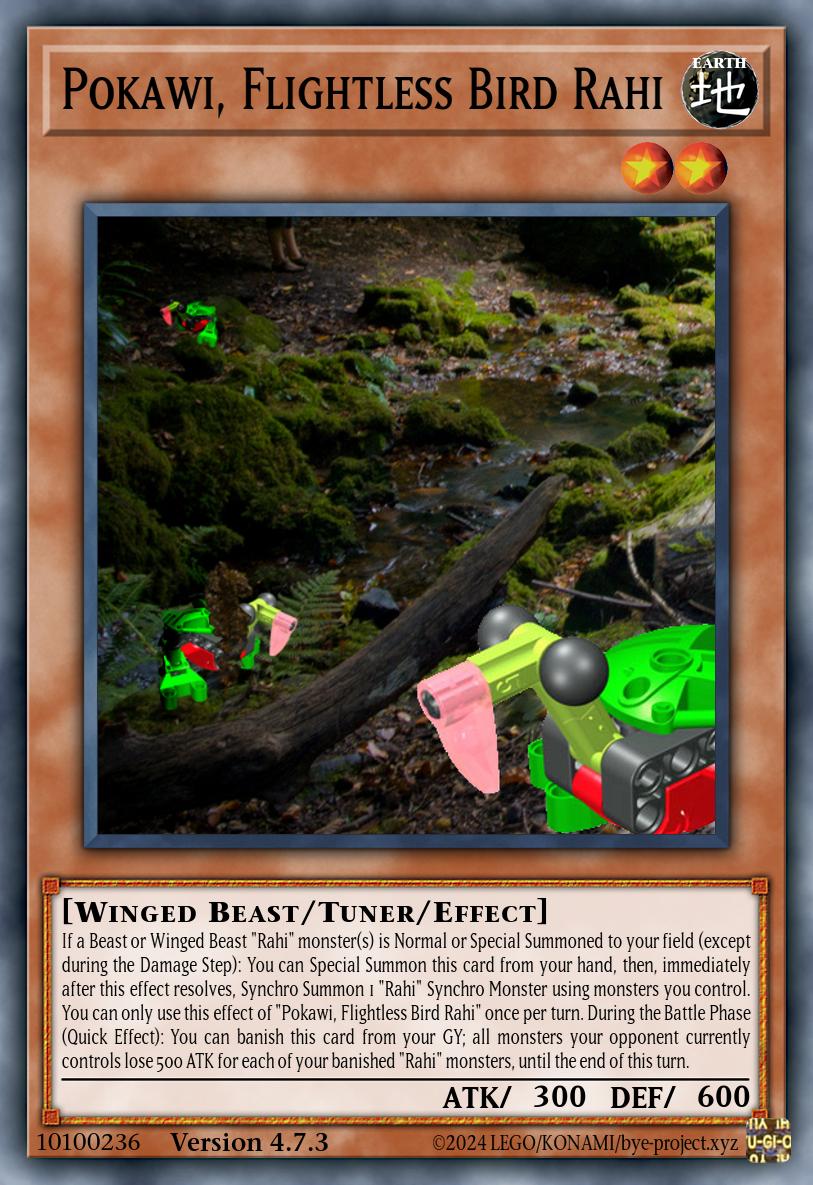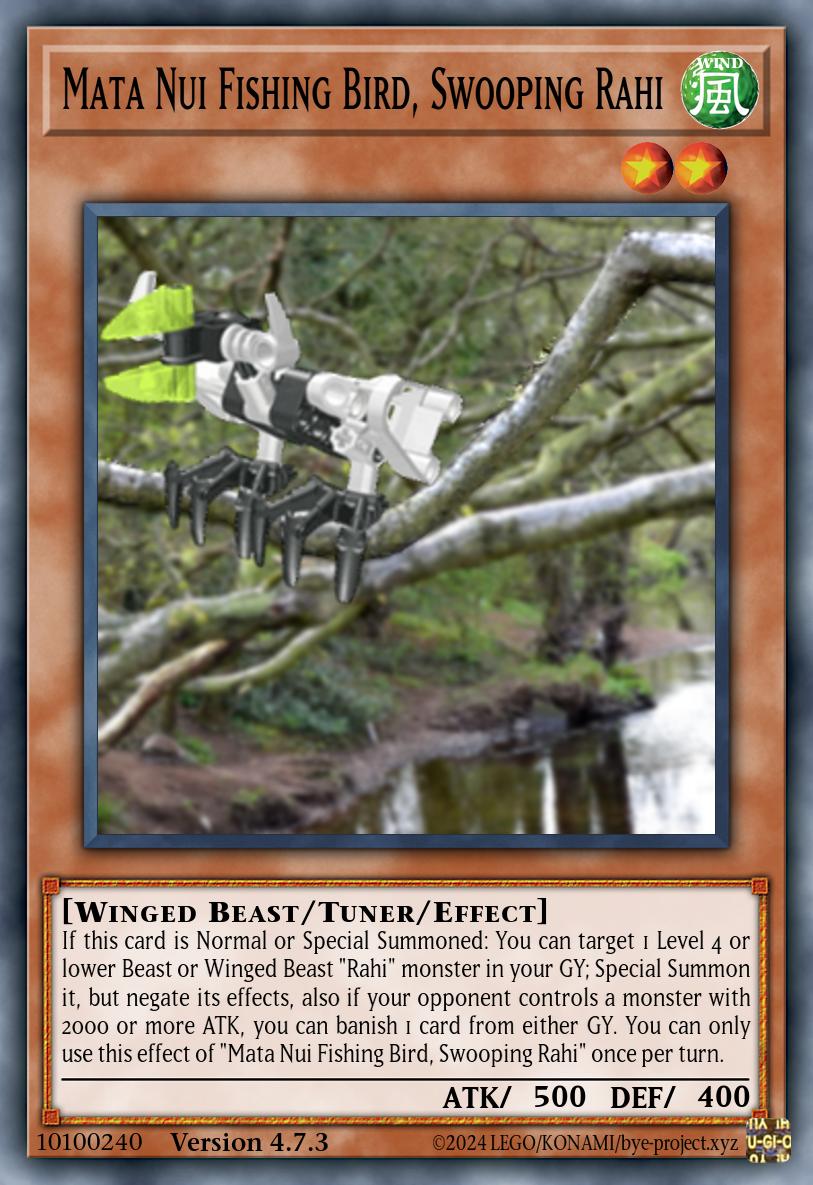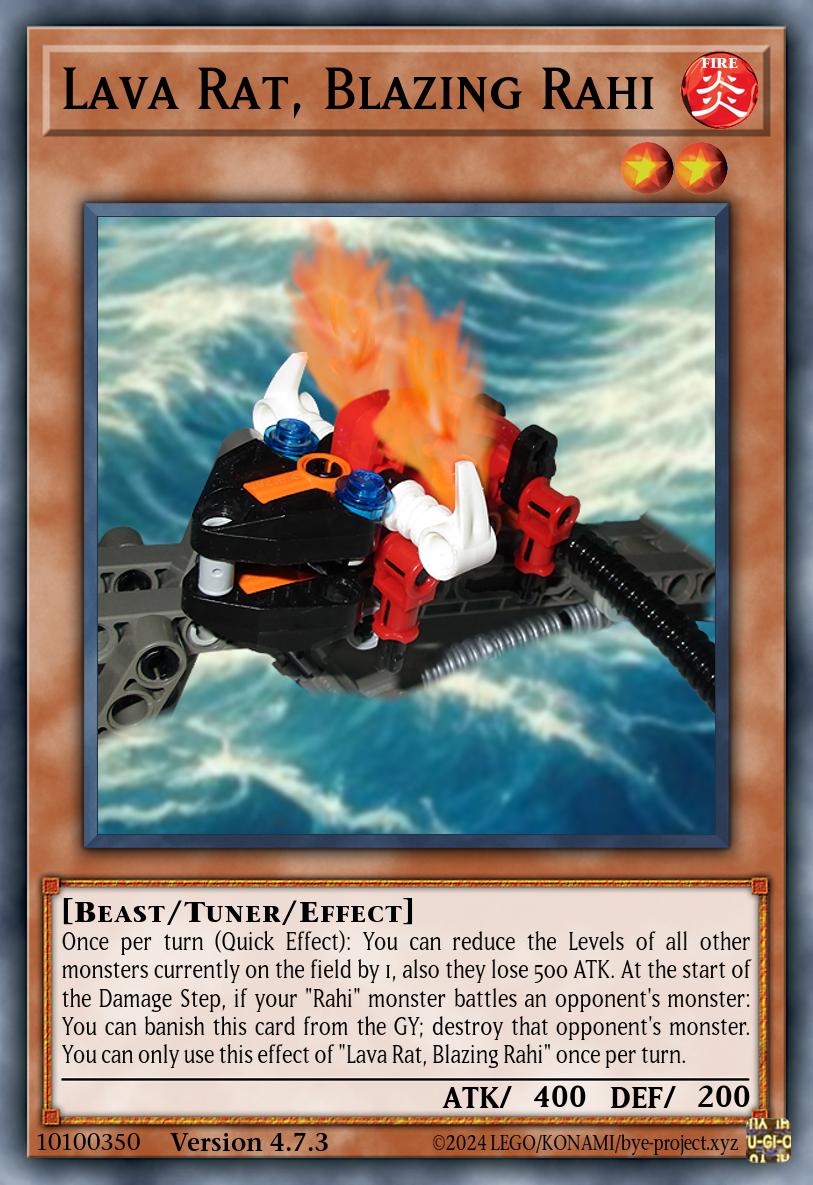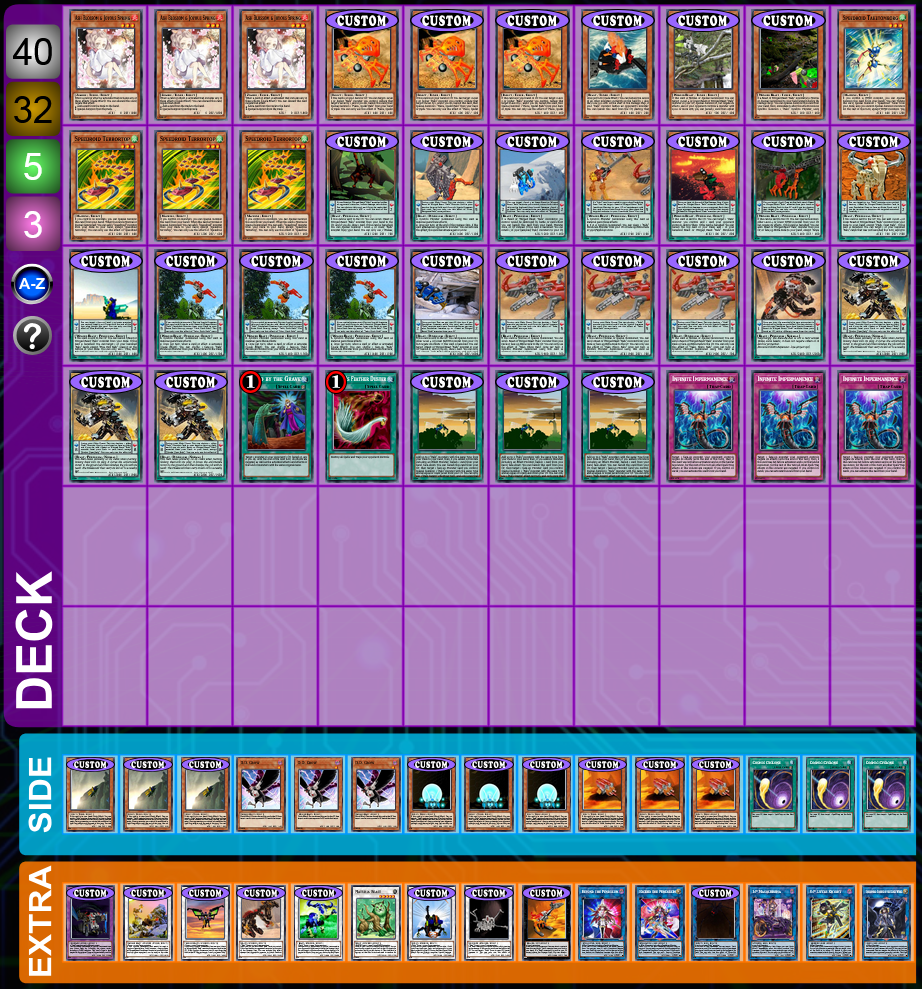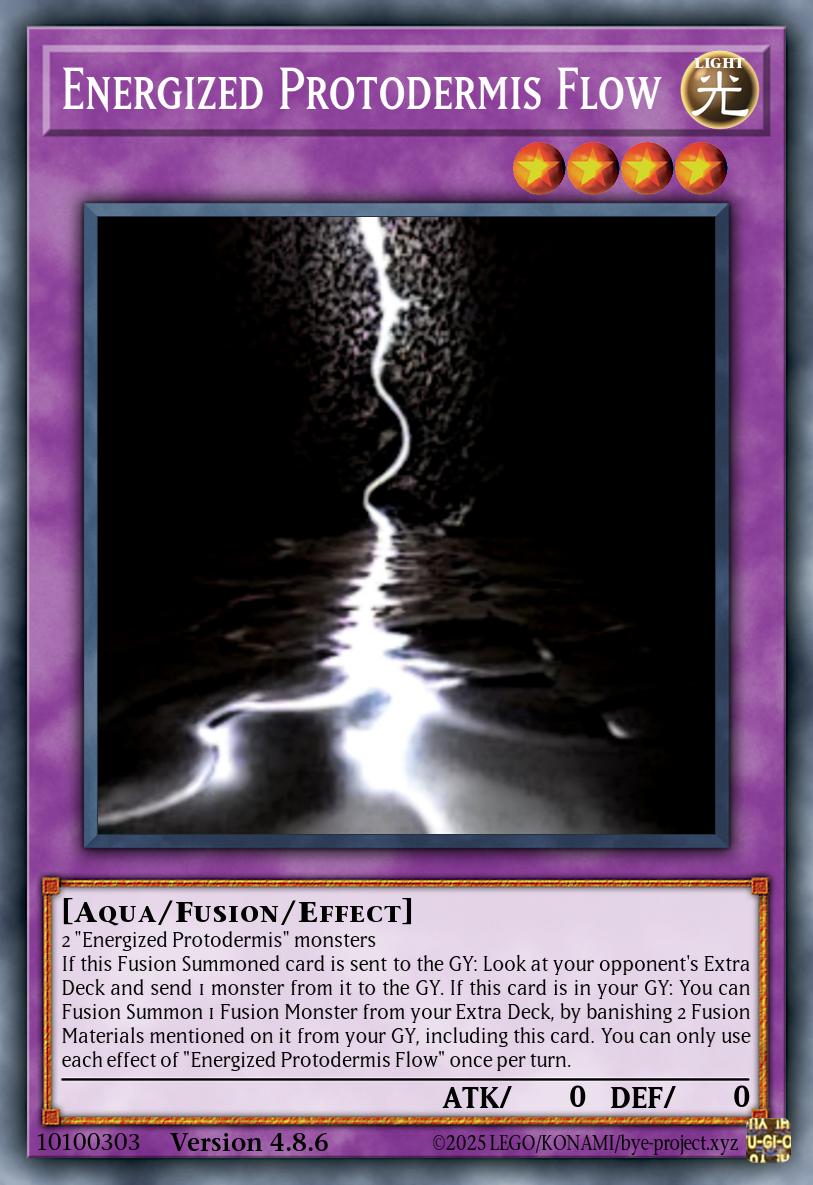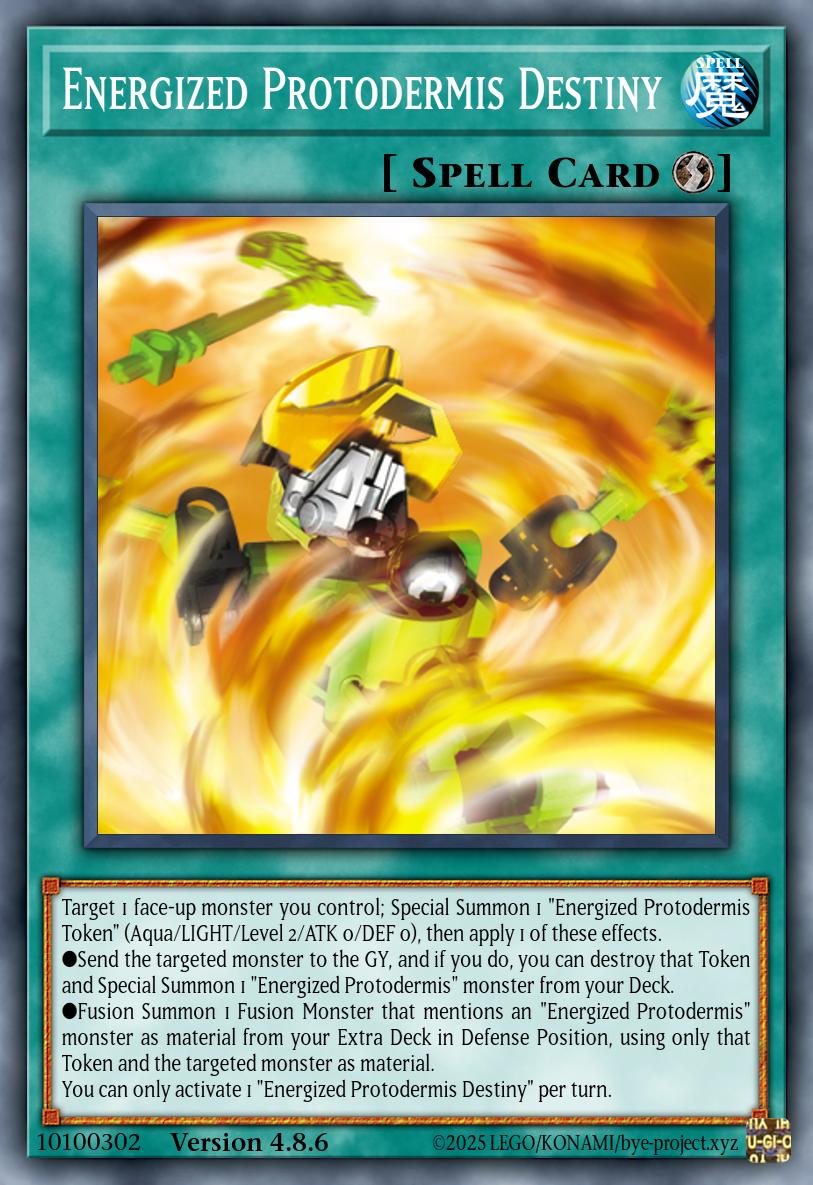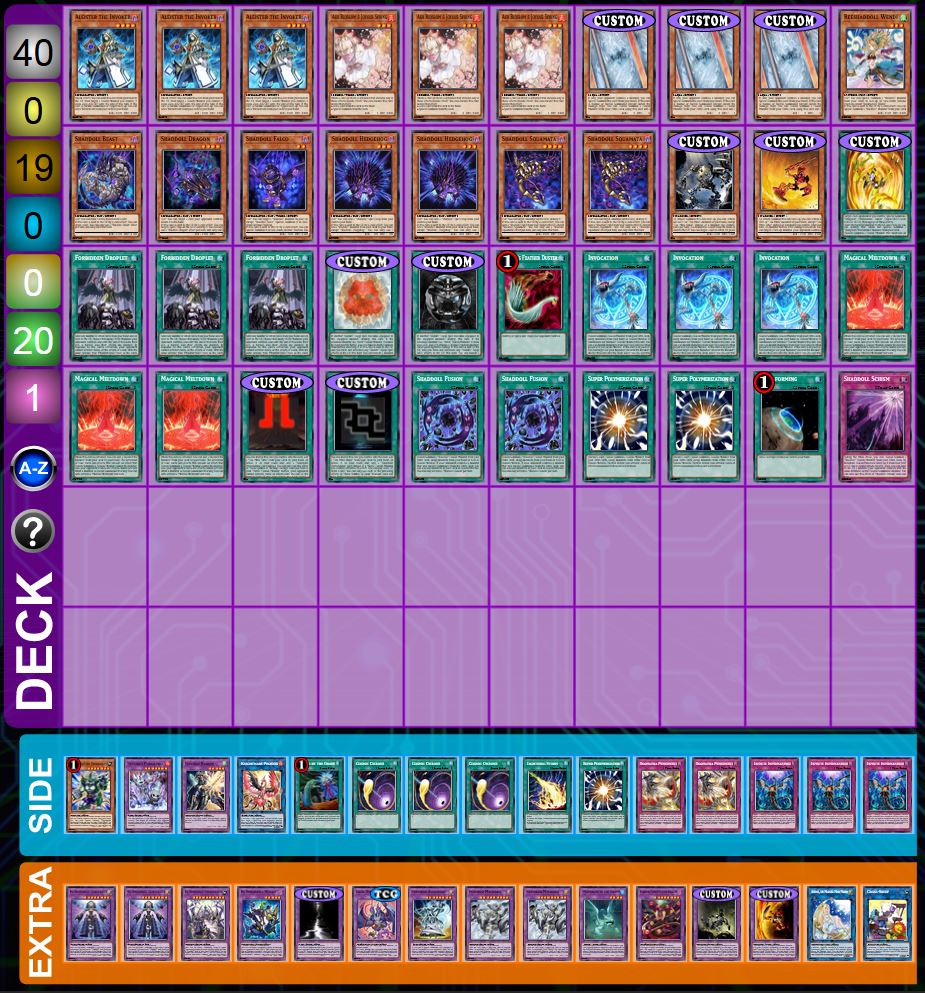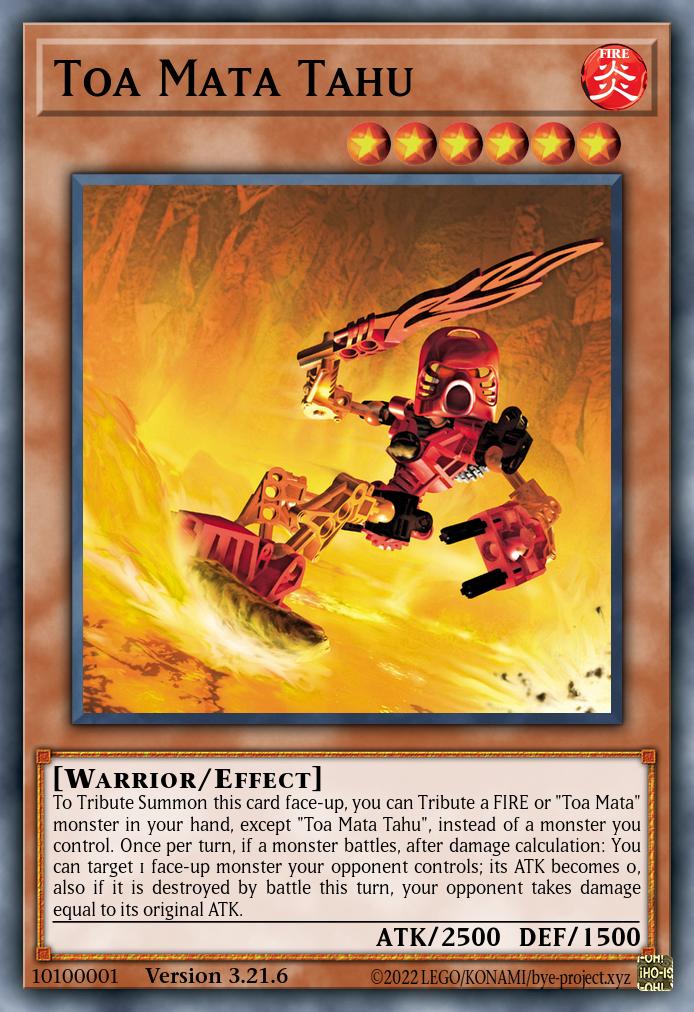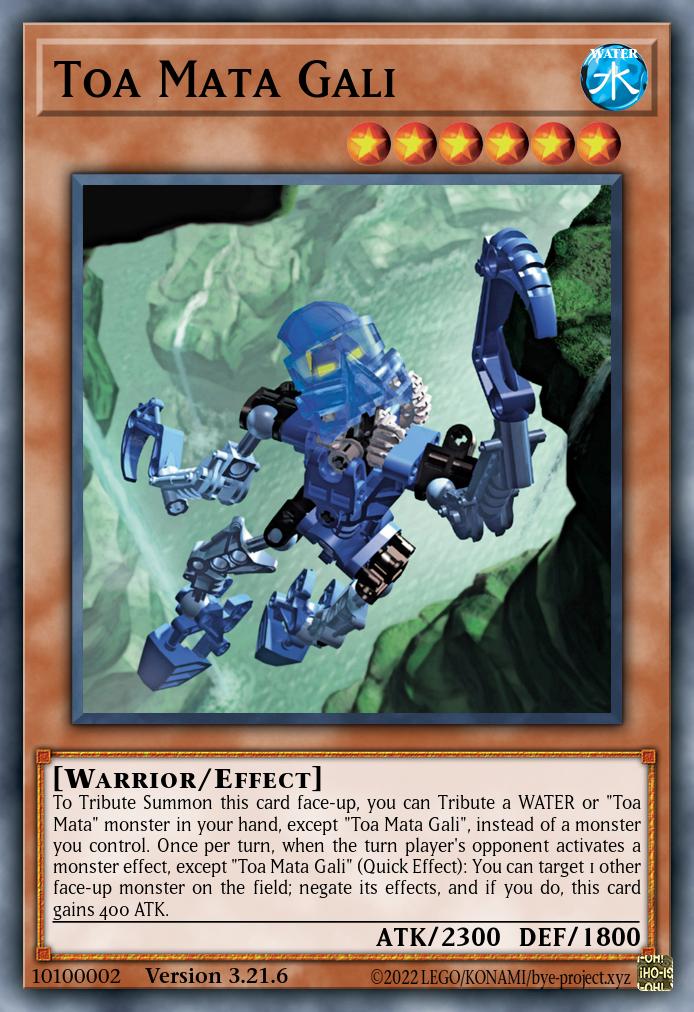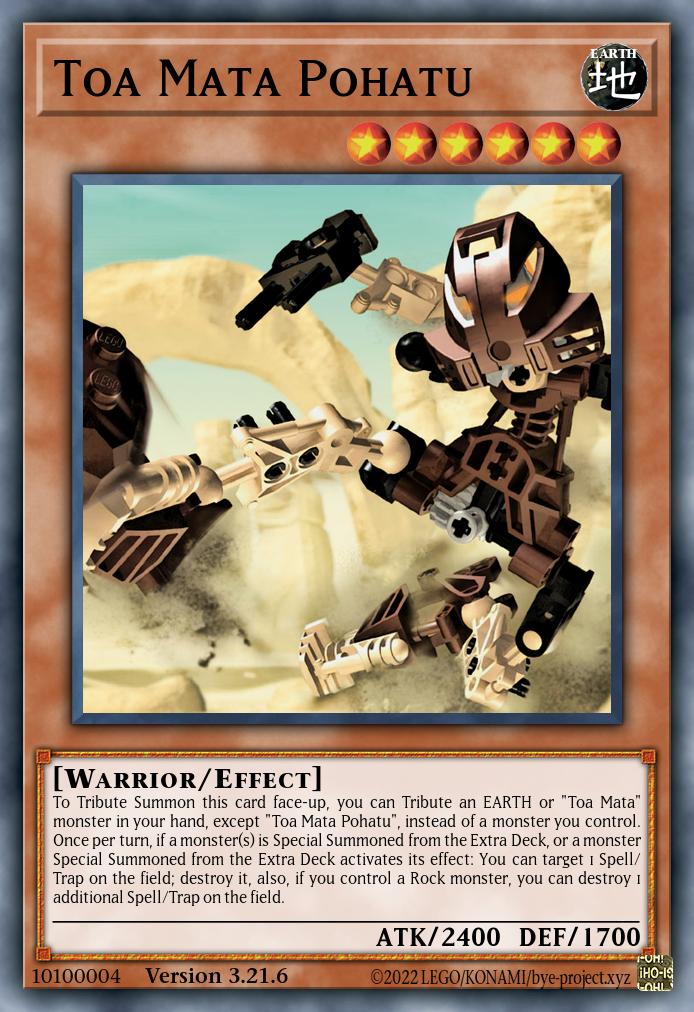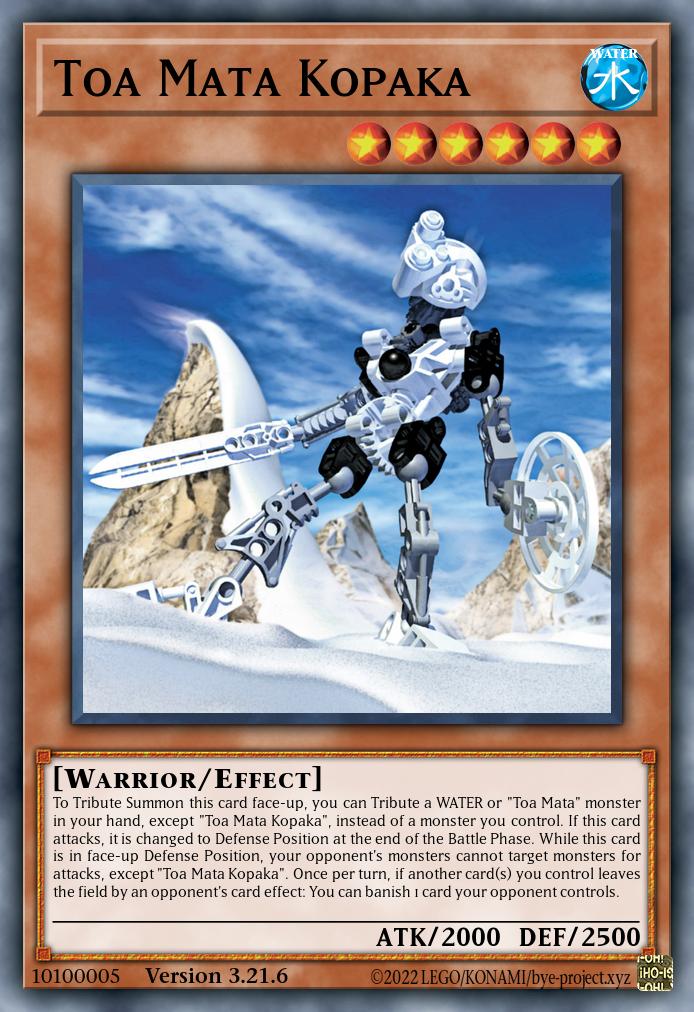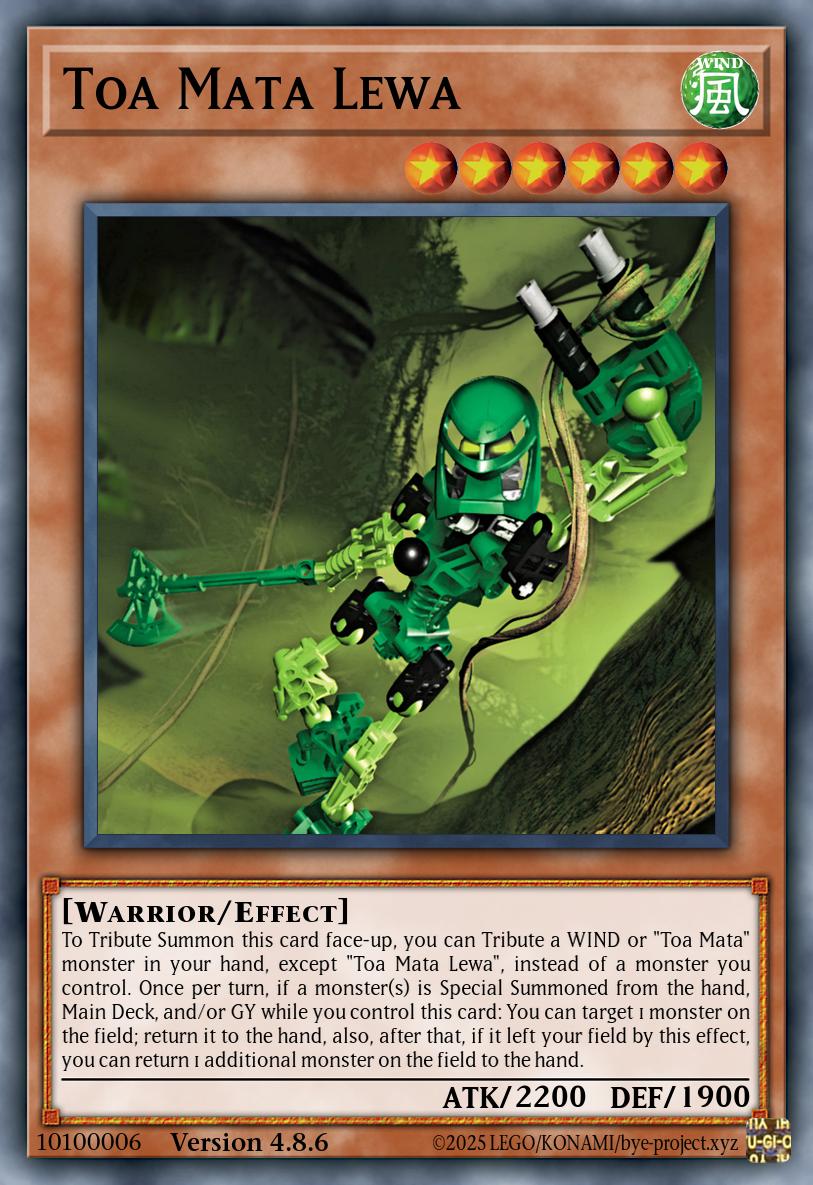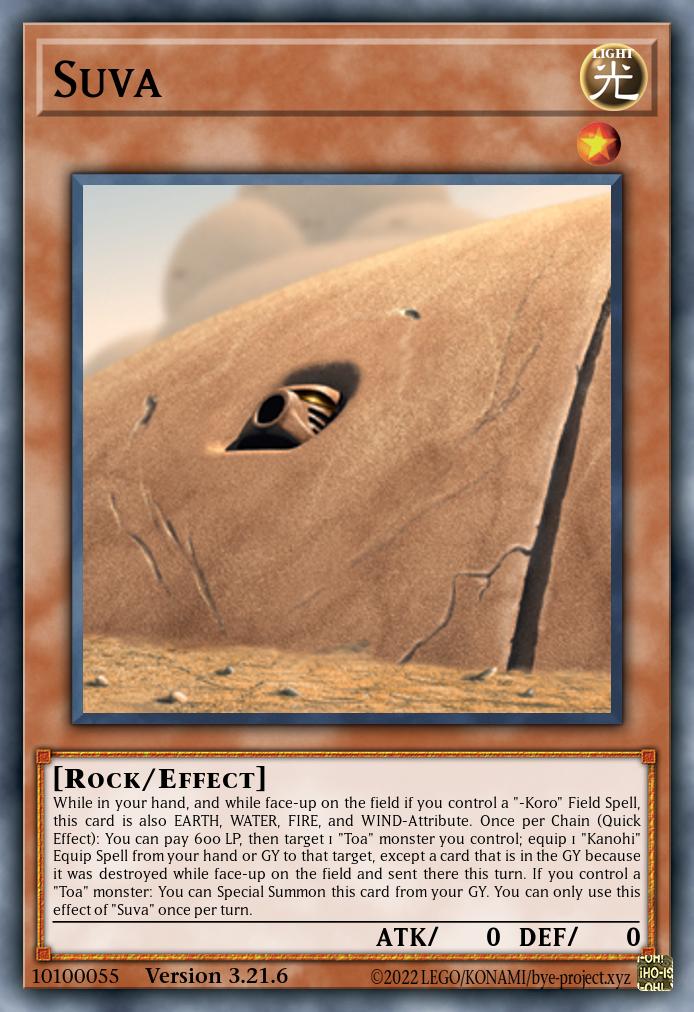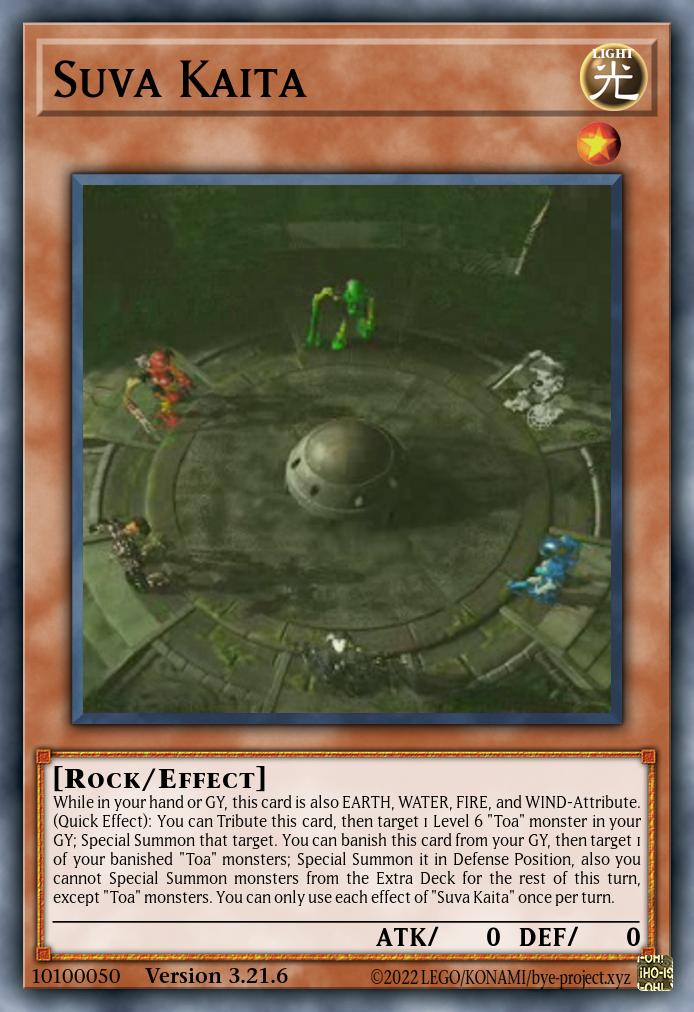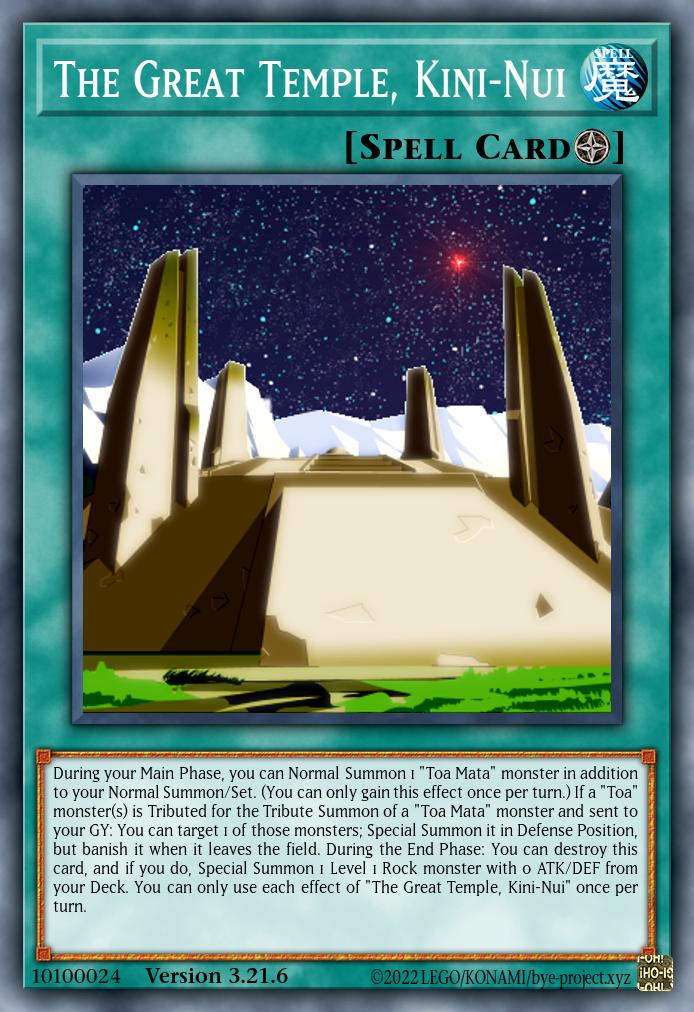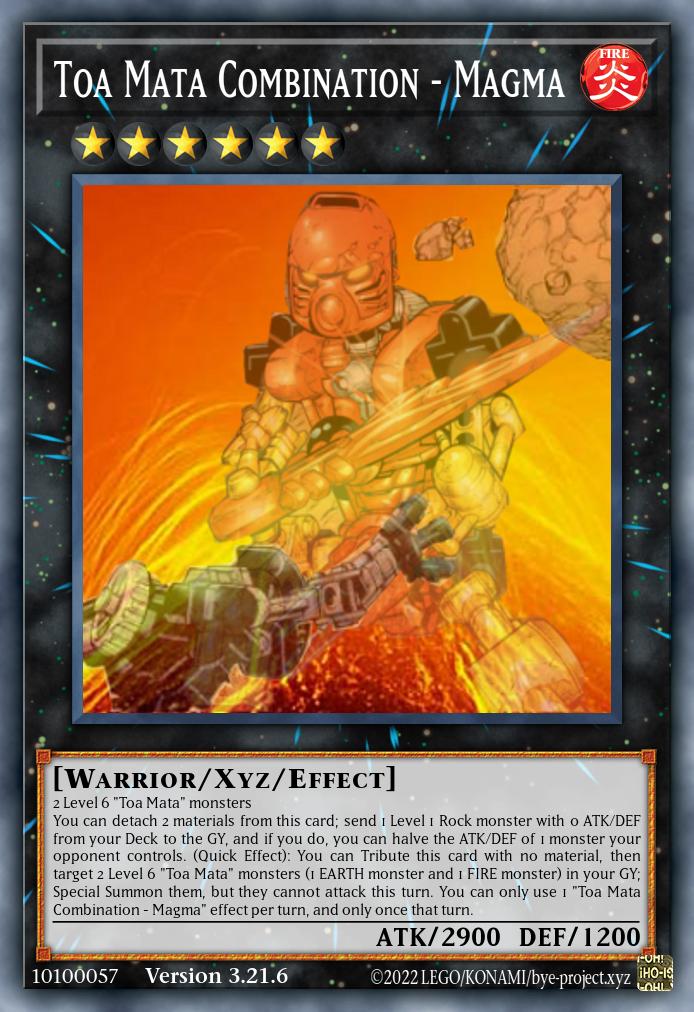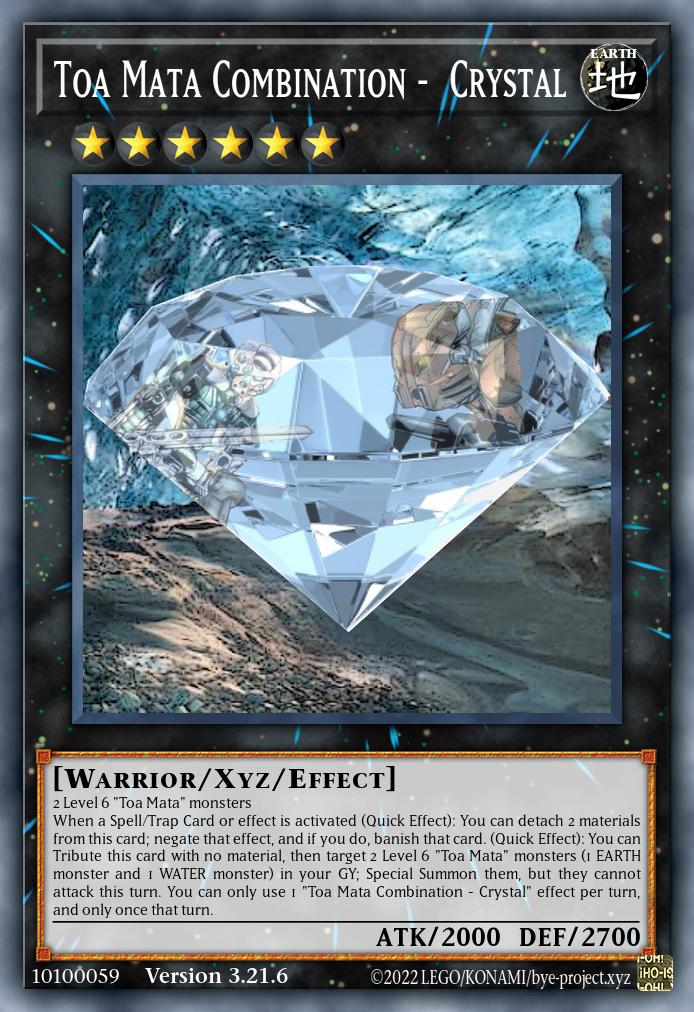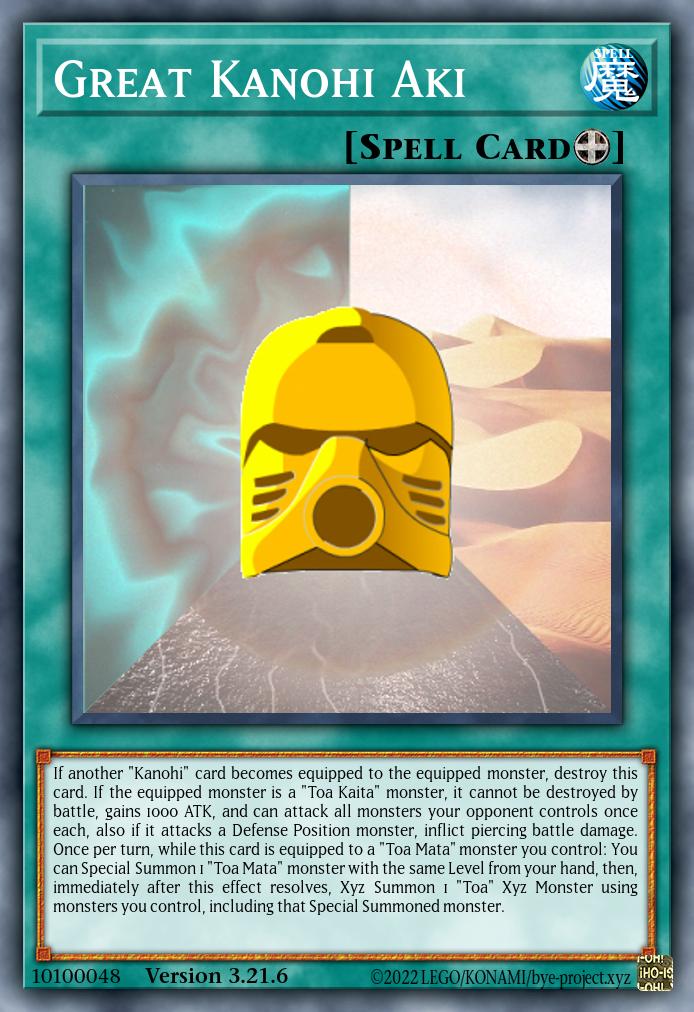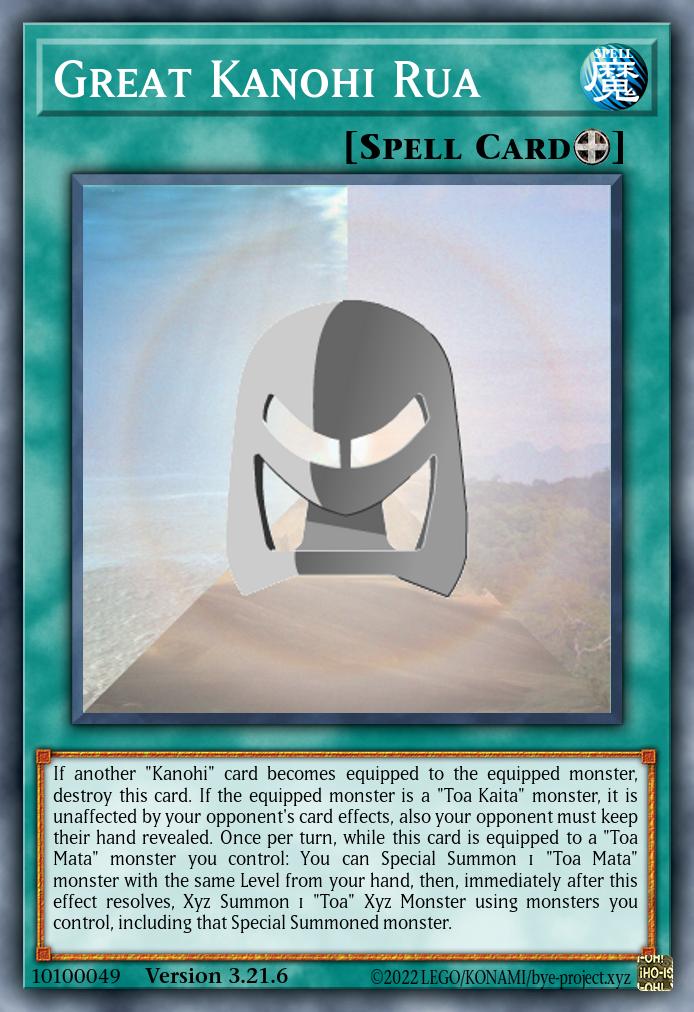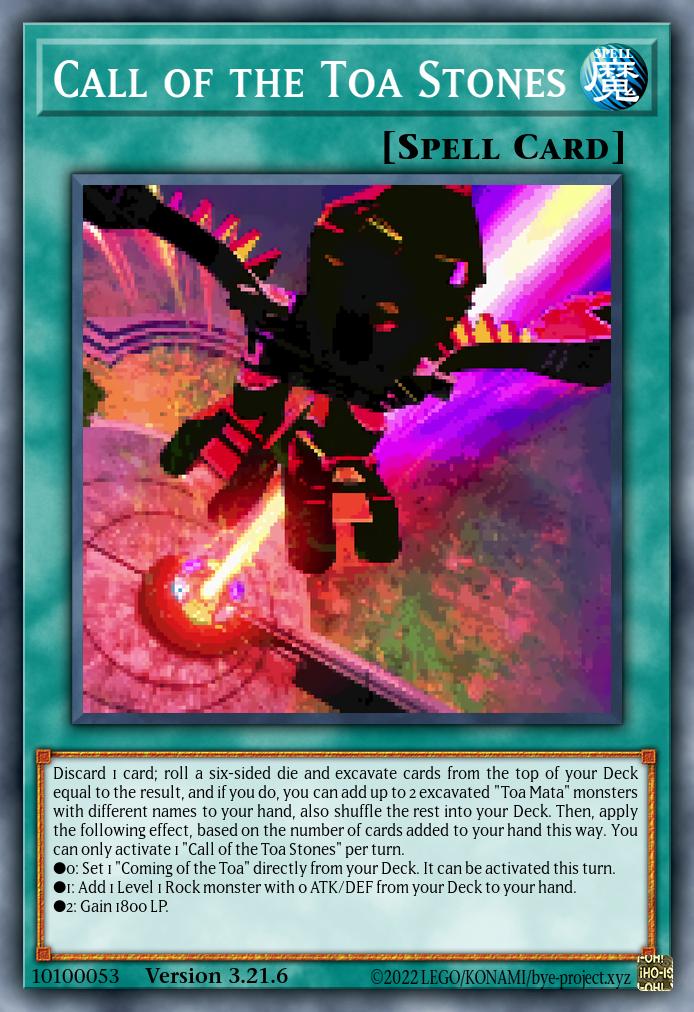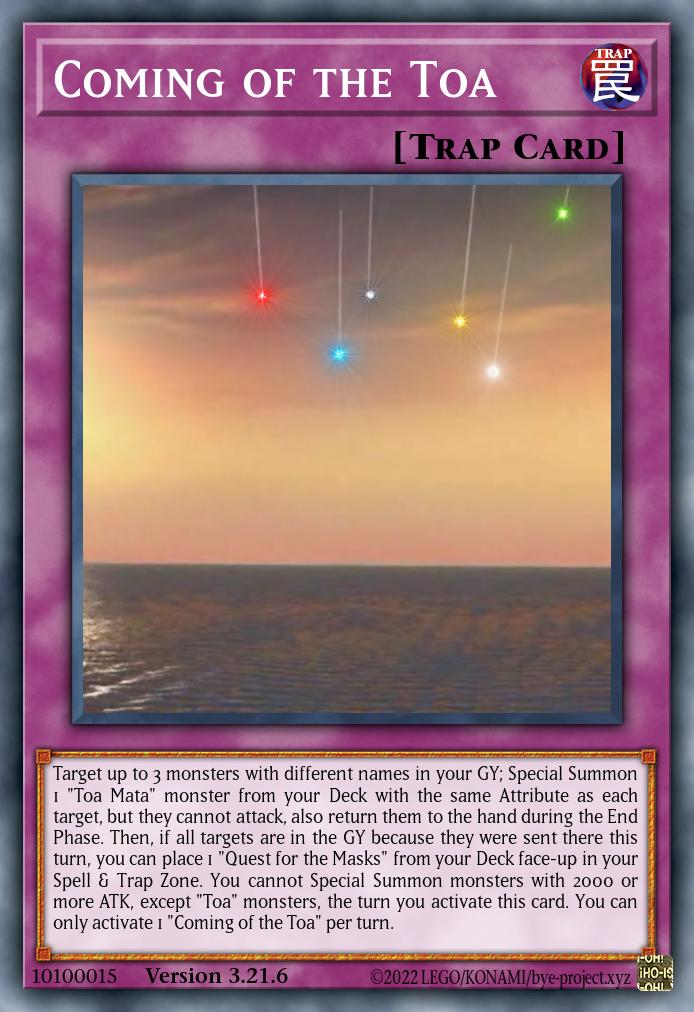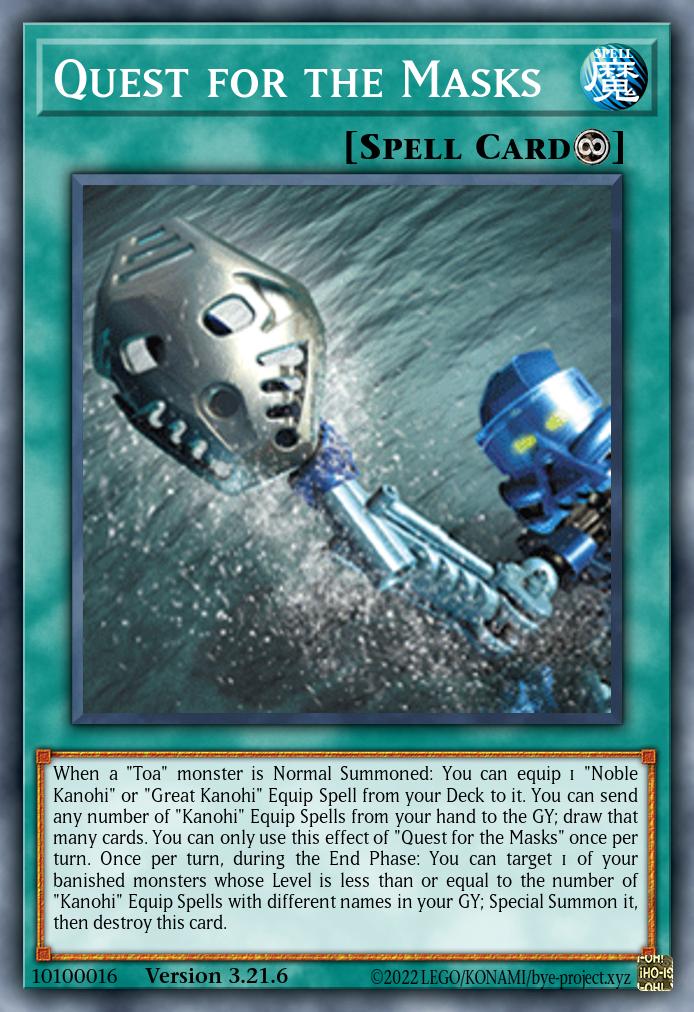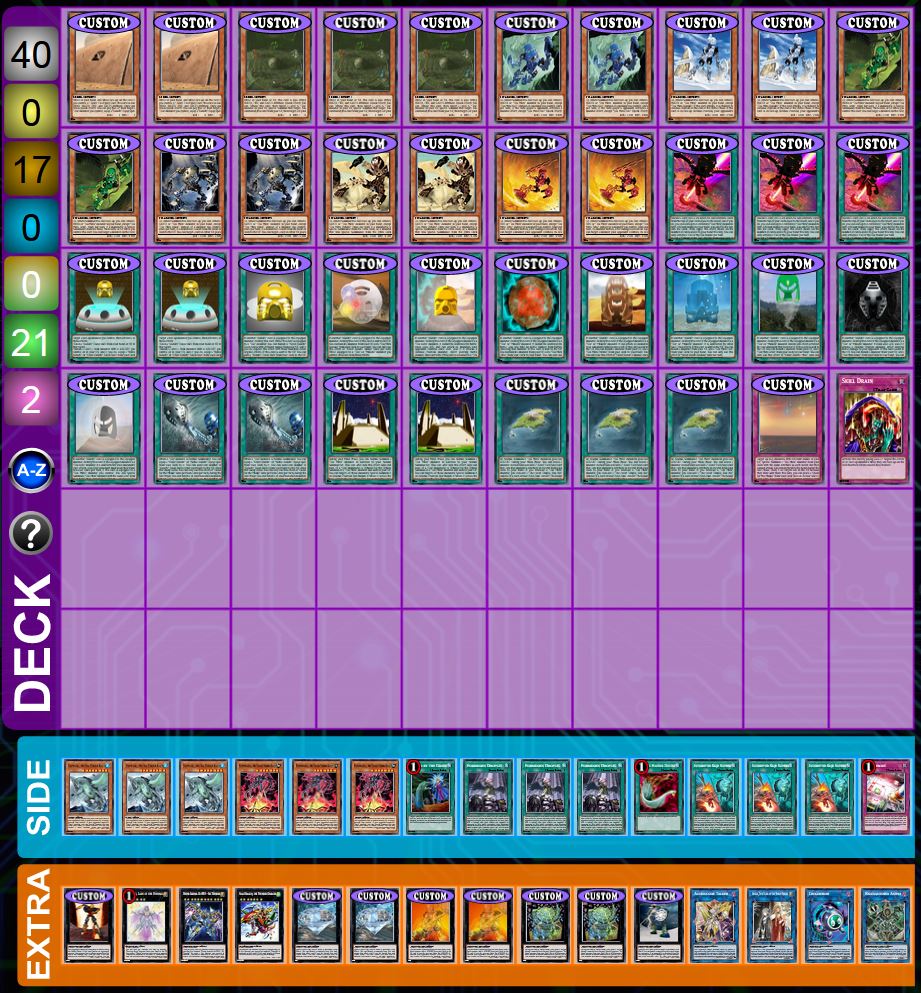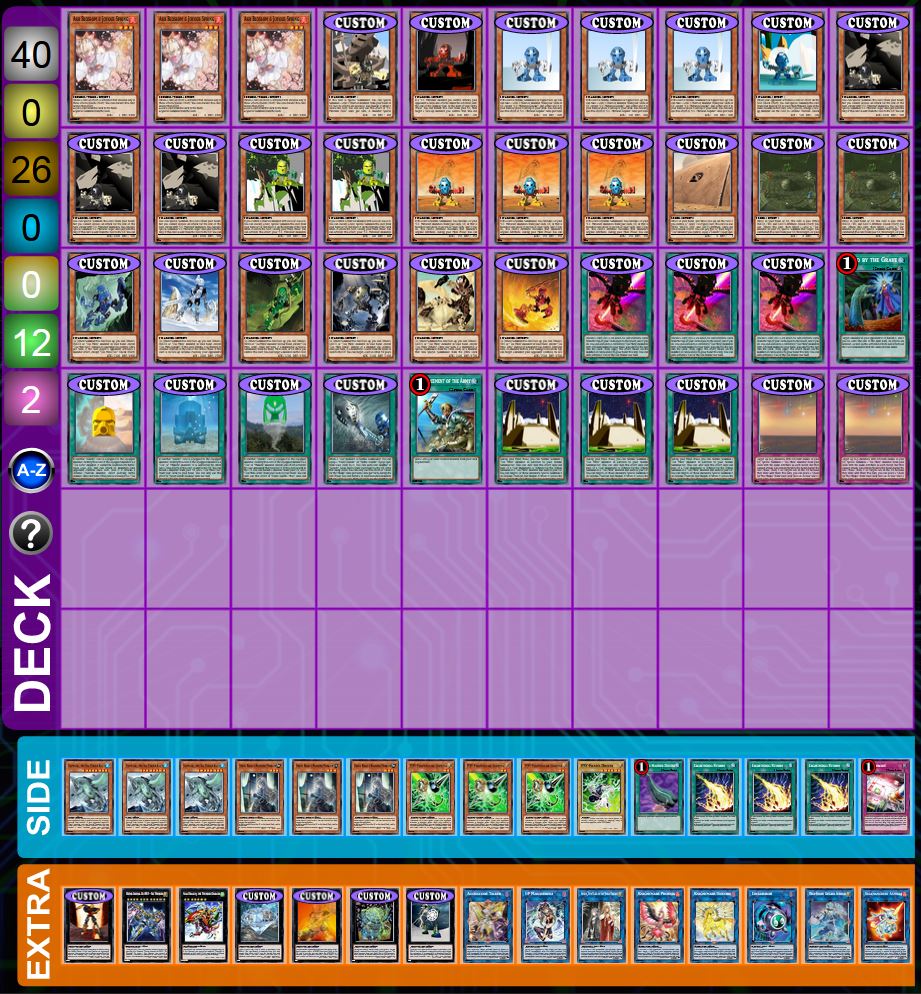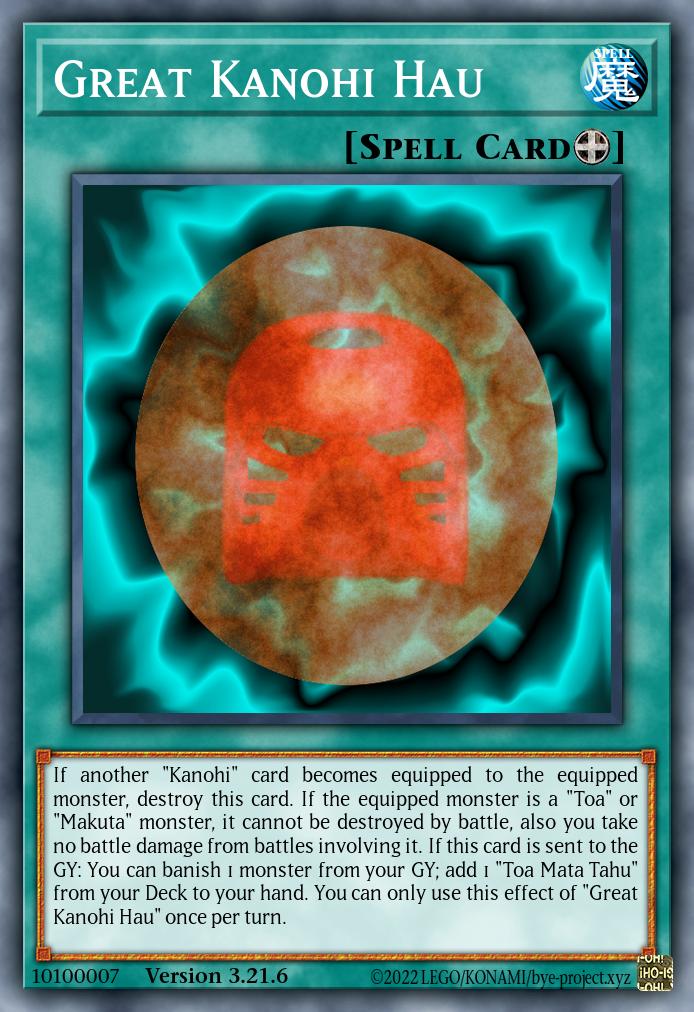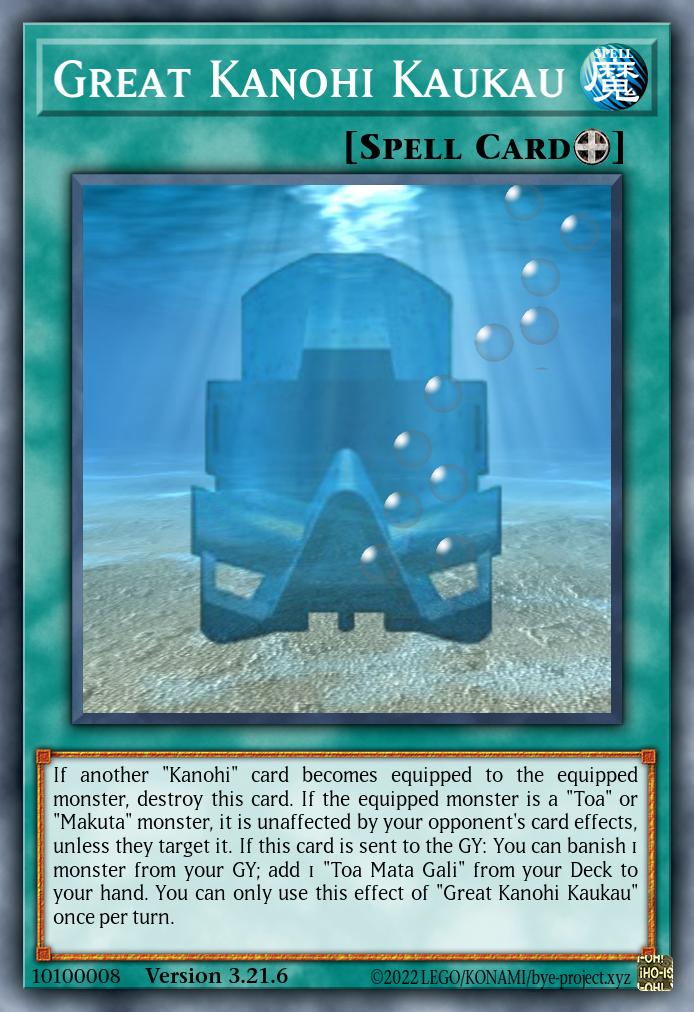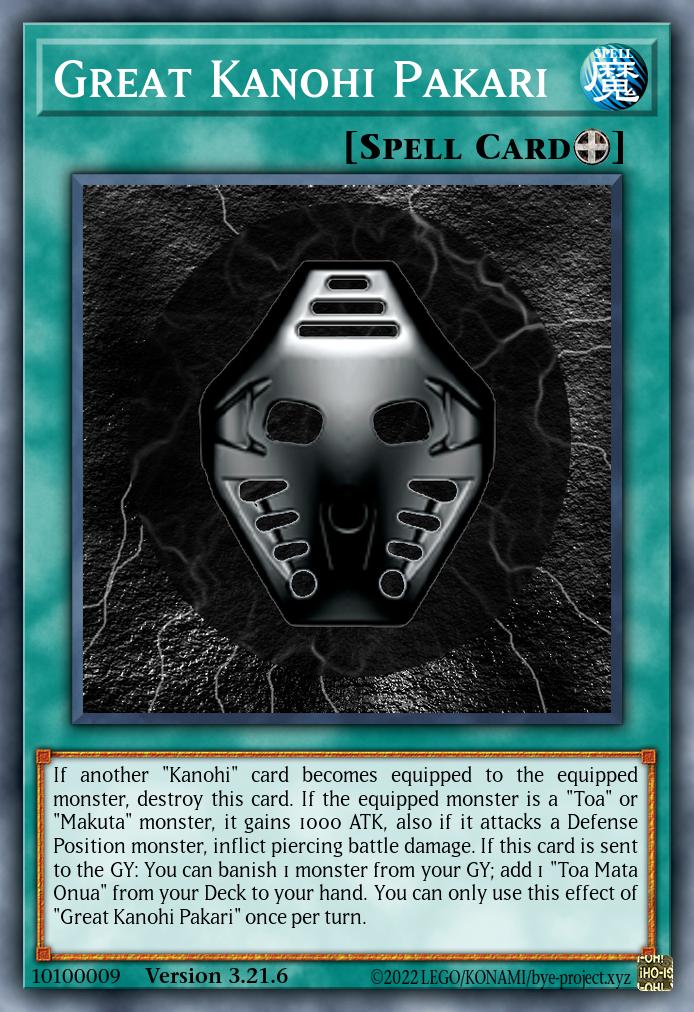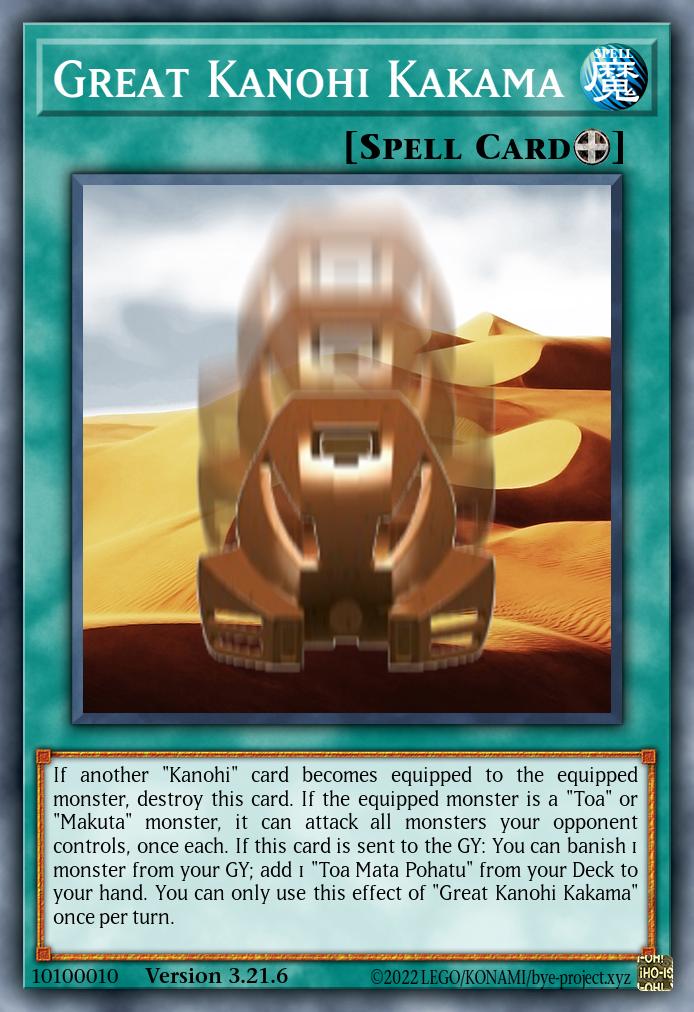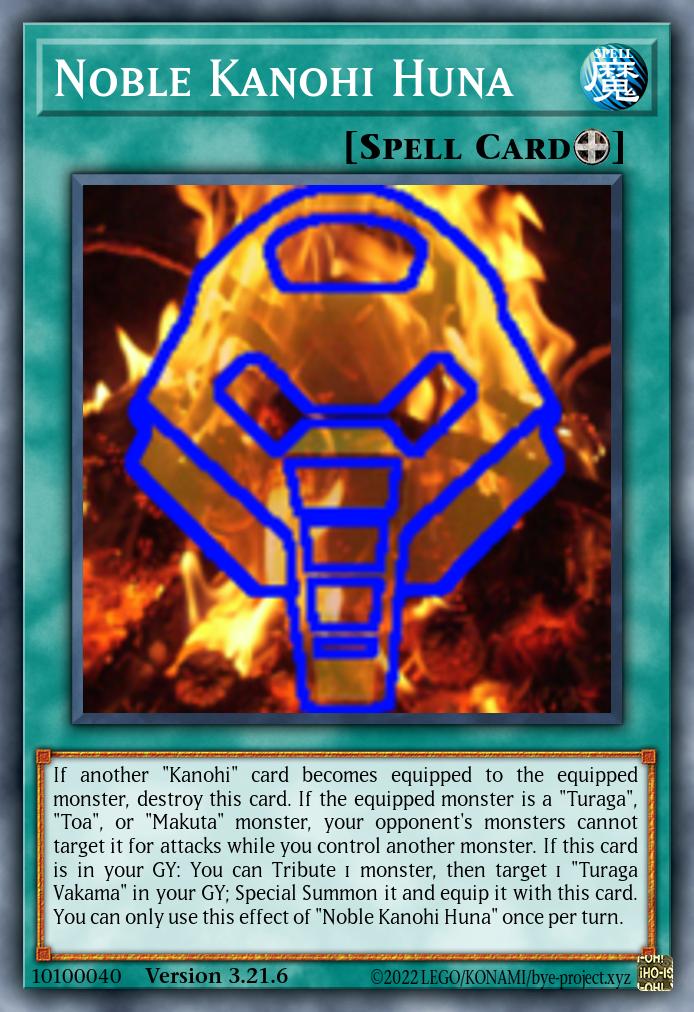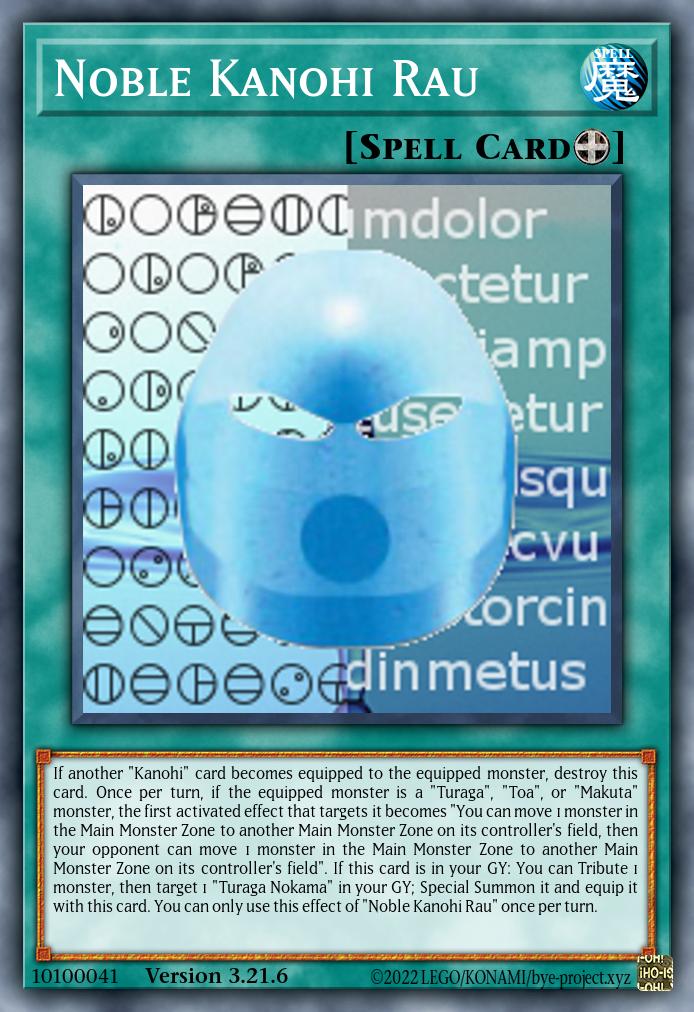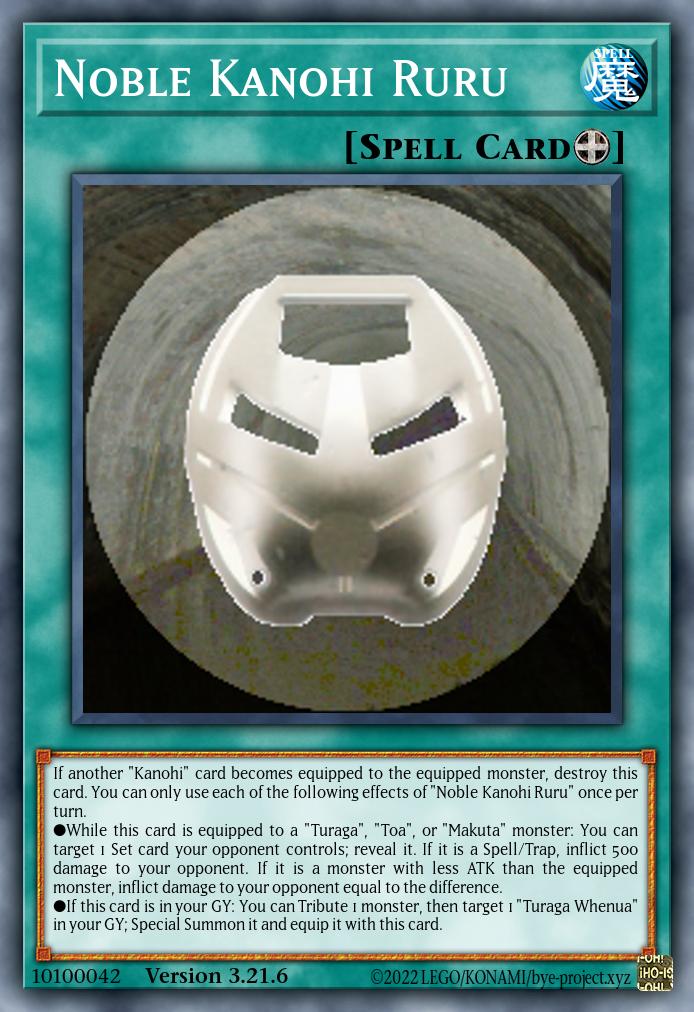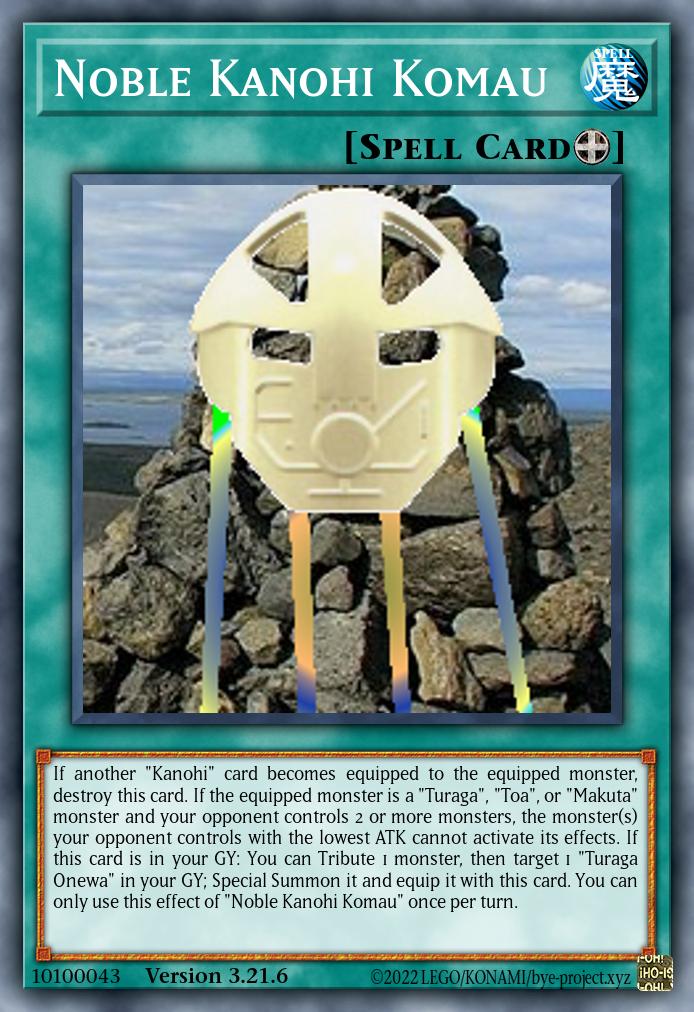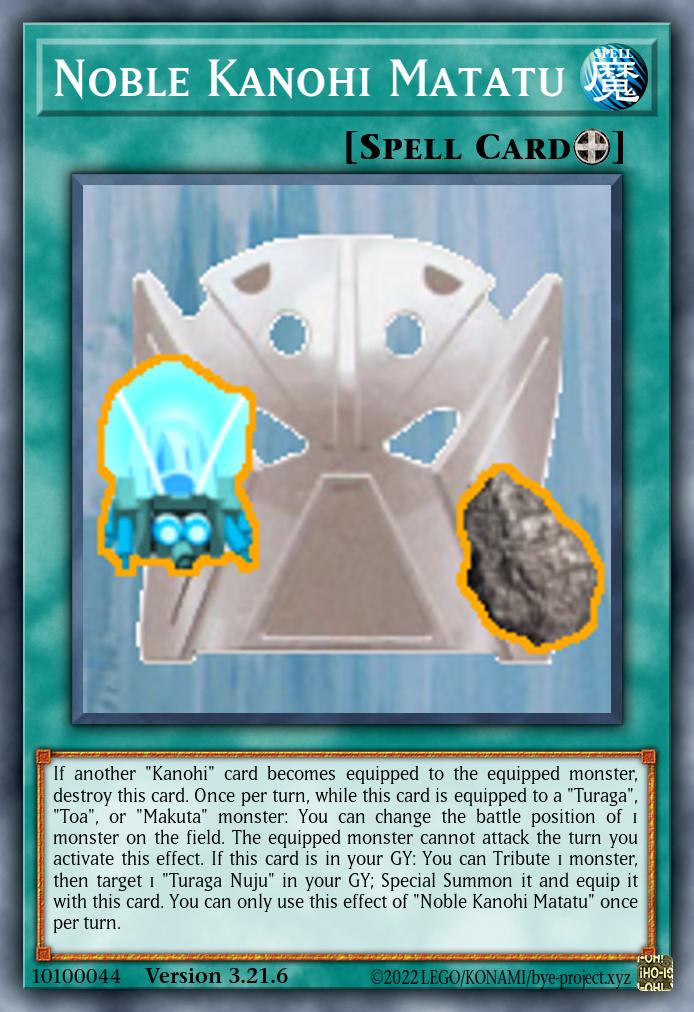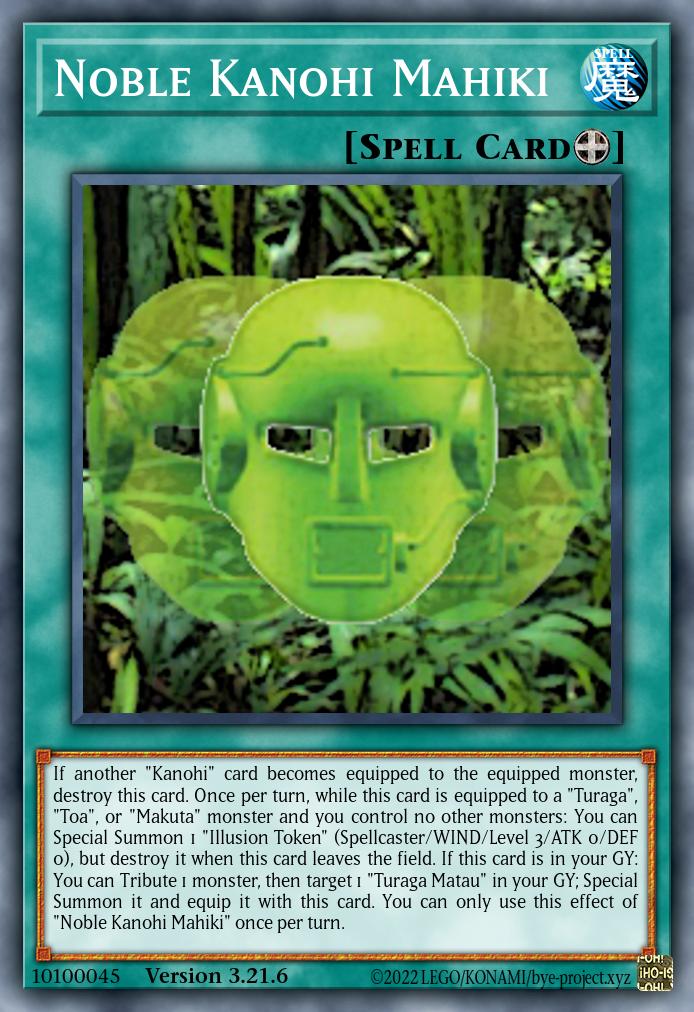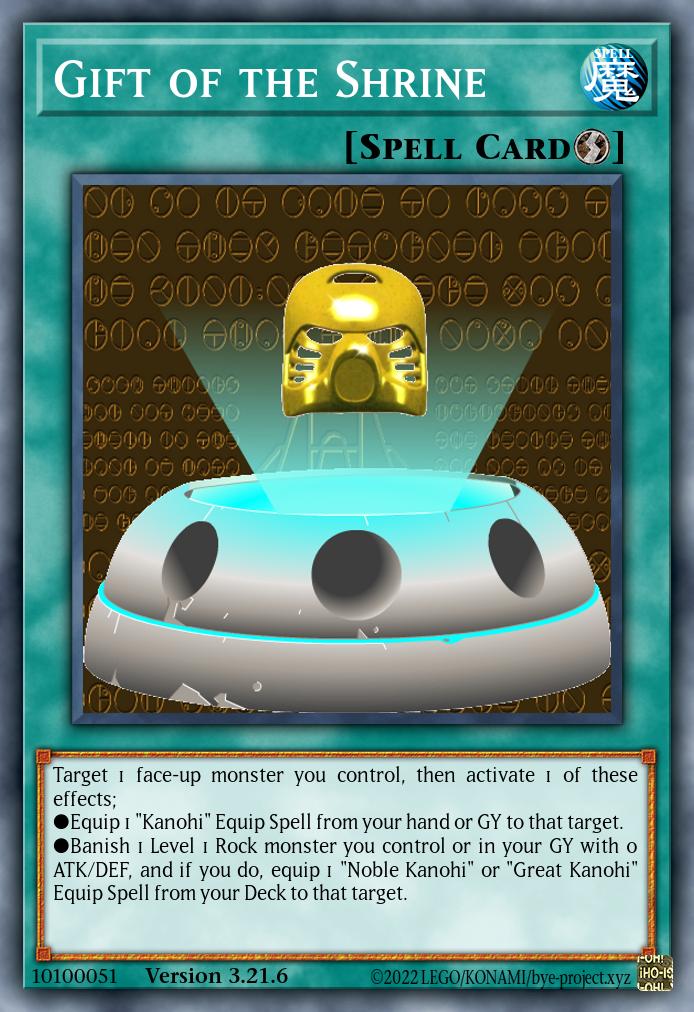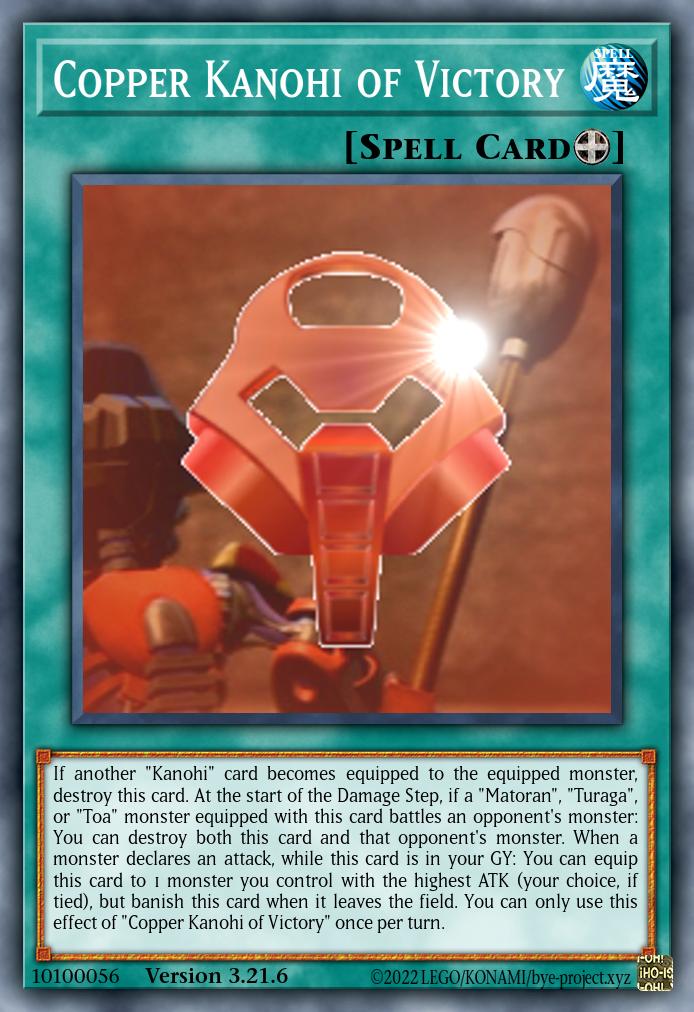Where there are heroes, there must also be … misunderstood cleanup professionals just trying to get their job back on schedule. Now, the time has come to awaken the Bahrag and unleash the swarms once more!
The Bohrok-Kal
A team of six elite Bohrok, to be activated in the event that the regular operations of the Bohrok swarms face a critical obstacle such as having their commanding queens sealed away.
Far more advanced than their regular brethren in both powers and intelligence, they have been realized as a suite of Rank 4 Xyz Boss monsters for the archetype here. Shared between all of them are two special features: The ability to attach “Krana” monsters from hand/field/GY as additional material, and the fact that their detached materials return to the Deck (which keeps you from re-attaching the same Krana and plays into the general Bohrok resource loop).

Bohrok Tahnok-Kal
Xyz Effect MonsterRank 4 | FIRE Machine | ATK 2100 / DEF 22002 Level 4 “Bohrok” monsters
Place materials detached from this card on the bottom of the Deck instead of sending them to the GY. Once per turn: You can attach 1 “Krana” monster from your hand, field, or GY to this card as material. (Quick Effect): You can detach 1 material from this card, then target 1 face-up monster your opponent controls; it cannot attack or activate its effects this turn, also you can detach 1 material from this card, and if you do, destroy all monsters your opponent controls with less than 2000 ATK. You can only use this effect of “Bohrok Tahnok-Kal” once per turn.
The lightning powers of Tahnok-Kal manifest at two levels: The “stun” setting that was mostly used in the story so things don’t get too violent for Lego, and the straight-up Raigeki thunderbolt it should theoretically also be capable of. Not quite Raigeki, though – any monsters at 2000 ATK and above, such as all the Toa, will survive this quick effect boardwipe.

Bohrok Gahlok-Kal
Xyz Effect MonsterRank 4 | WATER Machine | ATK 2200 / DEF 21002 Level 4 “Bohrok” monsters
Place materials detached from this card on the bottom of the Deck instead of sending them to the GY. Once per turn: You can attach 1 “Krana” monster from your hand, field, or GY to this card as material. At the start of the Battle Phase: You can detach 1 material from this card, then target 1 face-up monster on the field; it cannot attack until the end of your turn, then you can equip 1 monster adjacent to it or in its column to it. You can only use this effect of “Bohrok Gahlok-Kal” once per turn.
Gahlok-Kal uses its magnetism to make foes stick to the ground (preventing them from attacking) or to each other (acting as non-targeting removal given sufficient proximity). Since this happens at the start of either Battle Phase, it can be fun to have people (and/or AIs) run into it due to careless zone placement.

Bohrok Nuhvok-Kal
Xyz Effect MonsterRank 4 | EARTH Machine | ATK 2000 / DEF 23002 Level 4 “Bohrok” monsters
Place materials detached from this card on the bottom of the Deck instead of sending them to the GY. Once per turn: You can attach 1 “Krana” monster from your hand, field, or GY to this card as material. You can detach 2 or more materials from this card, then choose that many Main Monster Zones and/or Spell & Trap Zones; return as many cards in those zones to the hand as possible, also any of those zones that are unused after that cannot be used until your next Standby Phase. You can only use this effect of “Bohrok Nuhvok-Kal” once per turn.
Nuhvok-Kal gets a bit fancy with the mechanics, applying its gravity powers to both “float” cards off the field back to the hand and to “crush” the zones they were in into an unusable state. Since you pick the zones rather than the cards, this is essentially non-targeting mass removal.
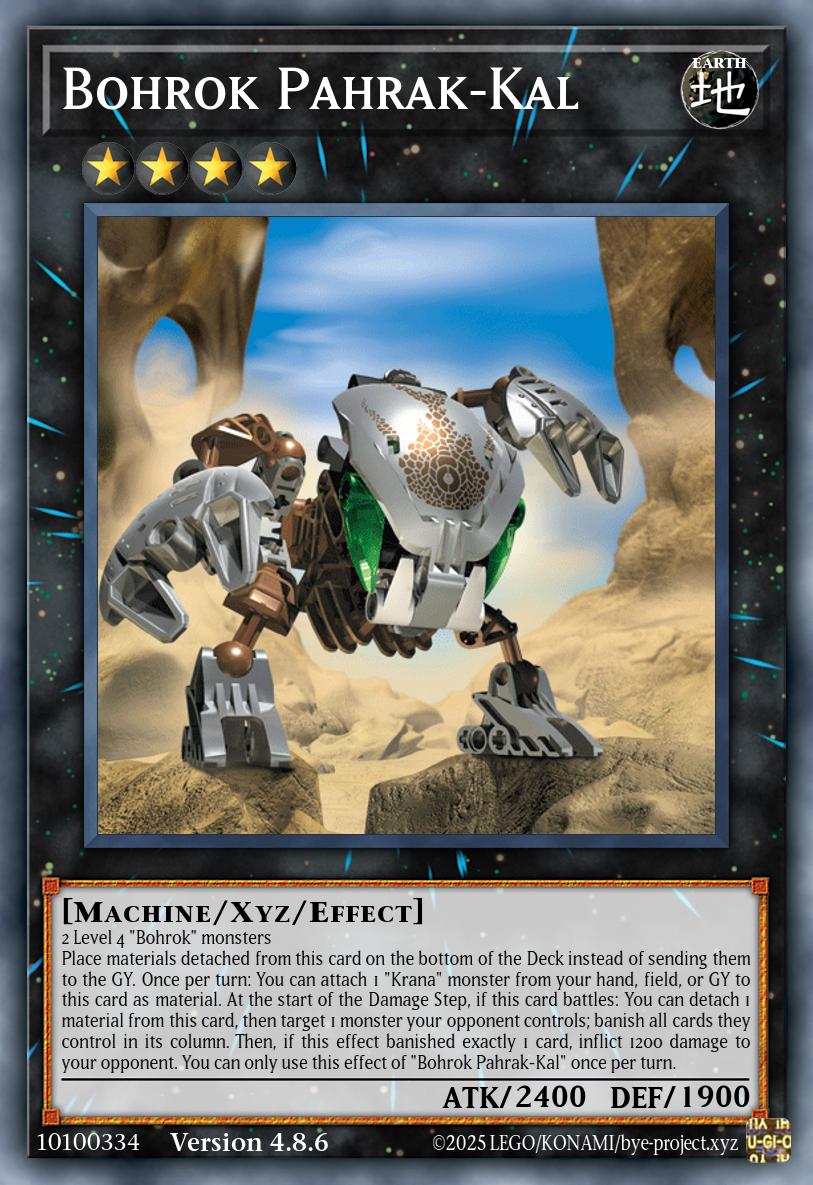
Bohrok Pahrak-Kal
Xyz Effect MonsterRank 4 | EARTH Machine | ATK 2400 / DEF 19002 Level 4 “Bohrok” monsters
Place materials detached from this card on the bottom of the Deck instead of sending them to the GY. Once per turn: You can attach 1 “Krana” monster from your hand, field, or GY to this card as material. At the start of the Damage Step, if this card battles: You can detach 1 material from this card, then target 1 monster your opponent controls; banish all cards they control in its column. Then, if this effect banished exactly 1 card, inflict 1200 damage to your opponent. You can only use this effect of “Bohrok Pahrak-Kal” once per turn.
When Pahrak-Kal fires its plasma, it does so in the straight line of a column, obliterating everything in its path and burning the opponent behind it if not met with sufficient resistance. Being an upgrade of the battle-focused Pahrak , this happens in the Damage Step, so response options are limited.

Bohrok Kohrak-Kal
Xyz Effect MonsterRank 4 | WATER Machine | ATK 2300 / DEF 20002 Level 4 “Bohrok” monsters
Place materials detached from this card on the bottom of the Deck instead of sending them to the GY. Once per turn: You can attach 1 “Krana” monster from your hand, field, or GY to this card as material. During the Main Phase (Quick Effect): You can detach 2 materials from this card; change all other face-up monsters on the field to Defense Position, also negate their effects until the end of this turn. You can only use this effect of “Bohrok Kohrak-Kal” once per turn.
What Kohrak-Kal does is stun everything around – friend or foe – with a sudden massive blast of noise, negating their effects and switching them to Defense Position. Which, it just so happens, provides a pretty decent setup for some Zeus action as well.

Bohrok Lehvak-Kal
Xyz Effect MonsterRank 4 | WIND Machine | ATK 1900 / DEF 24002 Level 4 “Bohrok” monsters
Place materials detached from this card on the bottom of the Deck instead of sending them to the GY. (Quick Effect): You can target 1 other card you control or in either GY; attach it to this card as material. If this card has 5 or more materials: You can detach all materials from this card, and if you do, destroy up to that many cards your opponent controls, then you can attach 1 of those destroyed cards to this card as material. You can only use each effect of “Bohrok Lehvak-Kal” once per turn.
Lehvak-Kal twists the formula a bit by replacing the standard Krana-attaching effect with a more broad Quick Effect that can also steal stuff from the opponent’s GY. This is the “suck” component of its vacuum powers, with the “blow” coming into play once it has (usually over the course of several turns) gathered enough material to unleash it all in a destructive blast. In short, this one both sucks and blows, which paradoxically makes it pretty good.
And in case even this elite squad isn’t enough, they also possess the ability to combine into Kaita, either the usual way by Bohrok Swarm Fusion or more easily throug a contact fusion procedure (since getting the materials in the first place is already hard enough).

Bohrok-Kal Kaita Za
Fusion Effect MonsterLevel 9 | LIGHT Machine | ATK 3000 / DEF 0“Bohrok Tahnok-Kal” + “Bohrok Nuhvok-Kal” + “Bohrok Pahrak-Kal”
Must first be either Fusion Summoned, or Special Summoned from your Extra Deck by Tributing the above cards. You can banish up to 3 “Bohrok” cards from your GY; until the end of this turn, this card gains 1000 ATK for each, also it can make up to that many attacks on monsters during each Battle Phase this turn. If this card is sent to the GY: You can target 1 “Bohrok” Xyz Monster in your GY; Special Summon it, and if you do, attach this card to it as material. You can only use each effect of “Bohrok-Kal Kaita Za” once per turn.
The Kaita Za primarily deals with monsters that would resist our effect-based removal attempts, by simply getting big and hitting over them. It also gains multiple attacks (on monsters) when doing so, granting it board-clearing and game-ending capabilities depending on the situation.
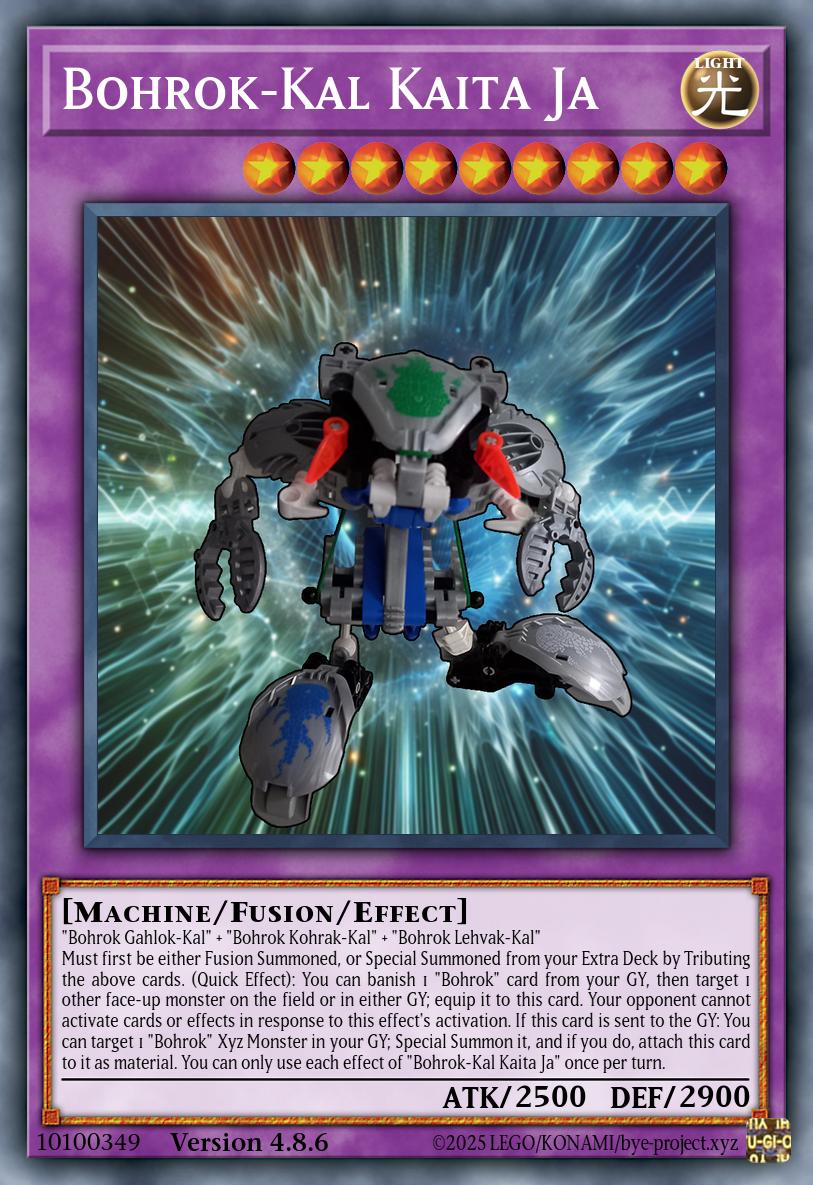
Bohrok-Kal Kaita Ja
Fusion Effect MonsterLevel 9 | LIGHT Machine | ATK 2500 / DEF 2900“Bohrok Gahlok-Kal” + “Bohrok Kohrak-Kal” + “Bohrok Lehvak-Kal”
Must first be either Fusion Summoned, or Special Summoned from your Extra Deck by Tributing the above cards. (Quick Effect): You can banish 1 “Bohrok” card from your GY, then target 1 other face-up monster on the field or in either GY; equip it to this card. Your opponent cannot activate cards or effects in response to this effect’s activation. If this card is sent to the GY: You can target 1 “Bohrok” Xyz Monster in your GY; Special Summon it, and if you do, attach this card to it as material. You can only use each effect of “Bohrok-Kal Kaita Ja” once per turn.
The Kaita Ja, bearing the glorious mantle of “has appeared in the story”, serves as a thing you can theoretically build up to in the face of big negation boards. Since its brand of Quick Effect removal cannot be responded to, it can simply grab a problematic monster without giving it a chance to defend itself, and then do that again every turn as long as you have enough Bohrok to banish. In terms of lore, this usage tracks with its victory over Wairuha Nuva , who is, wouldn’t you know it, a boss monster that negates.
What both of those have in common is the second effect, which tries to offset the big material investment by floating into a regular Bohrok-Kal and kindly attaching itself as material. By doing that, it’s also in a position to go to the GY and trigger again next turn, so if you get to the point where you can make these Fusions, they actually have a stealth benefit of infinite revival baked in.
And another thing of note is that, due to requiring specifically named materials, the Kal Kaita are in fact still compatible with the material replacement effect of Premature Bohrok Beacon … if you’re not making them by Contact Fusion, that is. One good reason to actually run the Fusion Spell even with these.
The Krana-Kal
To walk back the earlier staement about the intelligence of the Bohrok-Kal a bit, technically that part belongs to the Krana-Kal who pilot those mechanical shells. Their 8 variations are just enough to make one round trip of all the Link Arrows, so they’re implemented as a bunch of Link-1 monsters with two effects each: One for utility, based on the direction of the arrow (Down: Xyz Summon with a single Bohrok / Up: Battle debuff for opponent’s monsters / Side: tag out into a Bohrok from hand or GY), and one granted to a Bohrok-Kal that attaches it, representing the unique special power of that Krana-Kal.
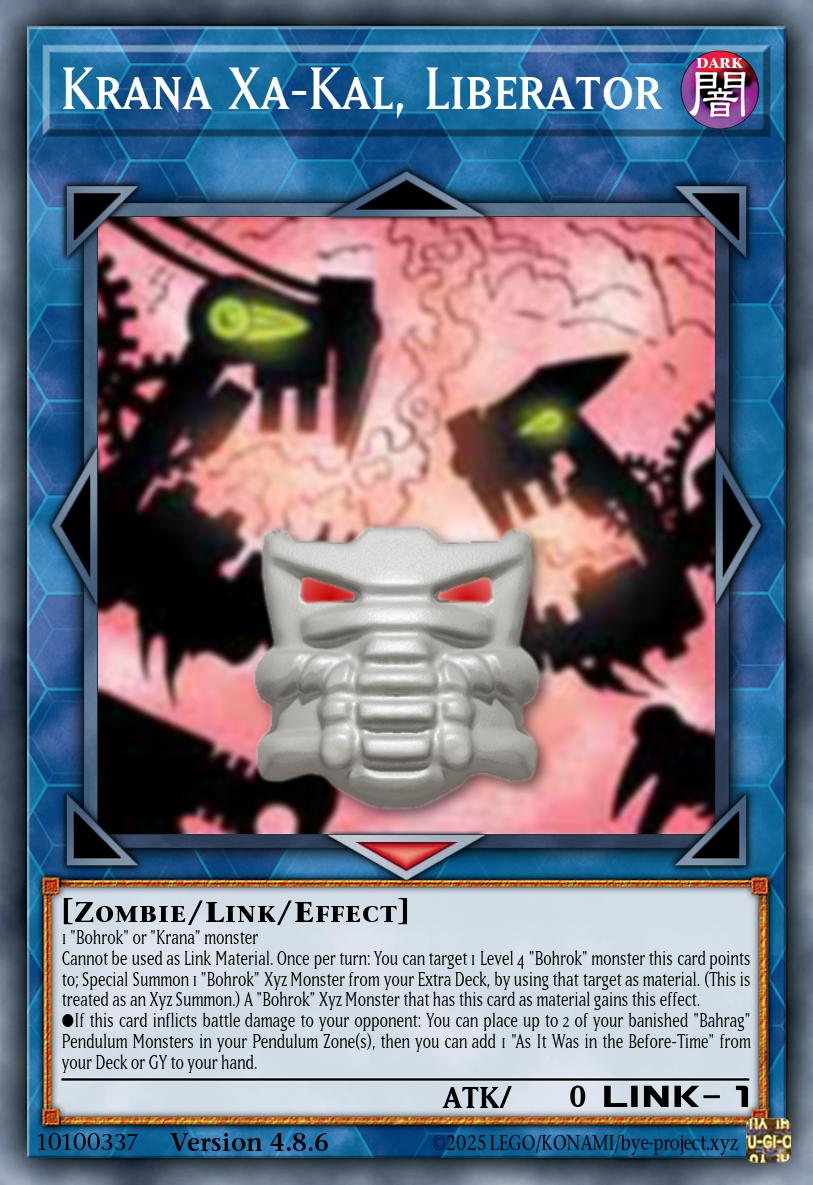
Krana Xa-Kal, Liberator
Link Effect MonsterLink-1 [▼] | DARK Zombie | ATK 01 “Bohrok” or “Krana” monster
Cannot be used as Link Material. Once per turn: You can target 1 Level 4 “Bohrok” monster this card points to; Special Summon 1 “Bohrok” Xyz Monster from your Extra Deck, by using that target as material. (This is treated as an Xyz Summon.) A “Bohrok” Xyz Monster that has this card as material gains this effect.
●If this card inflicts battle damage to your opponent: You can place up to 2 of your banished “Bahrag” Pendulum Monsters in your Pendulum Zone(s), then you can add 1 “As It Was in the Before-Time” from your Deck or GY to your hand.
The Xa-Kal carries the crucial task of awakening the Bahrag once contact is made, thus fulfilling the mission. In game terms, “making contact” here means dealing damage, and “awakening the Bahrag” means getting them out of their banished state (where they were put by, say, a Toa Seal ) back into the Pendulum Zone so that the swarms can proceed to make Mata Nui clean, As It Was In The Before-Time .
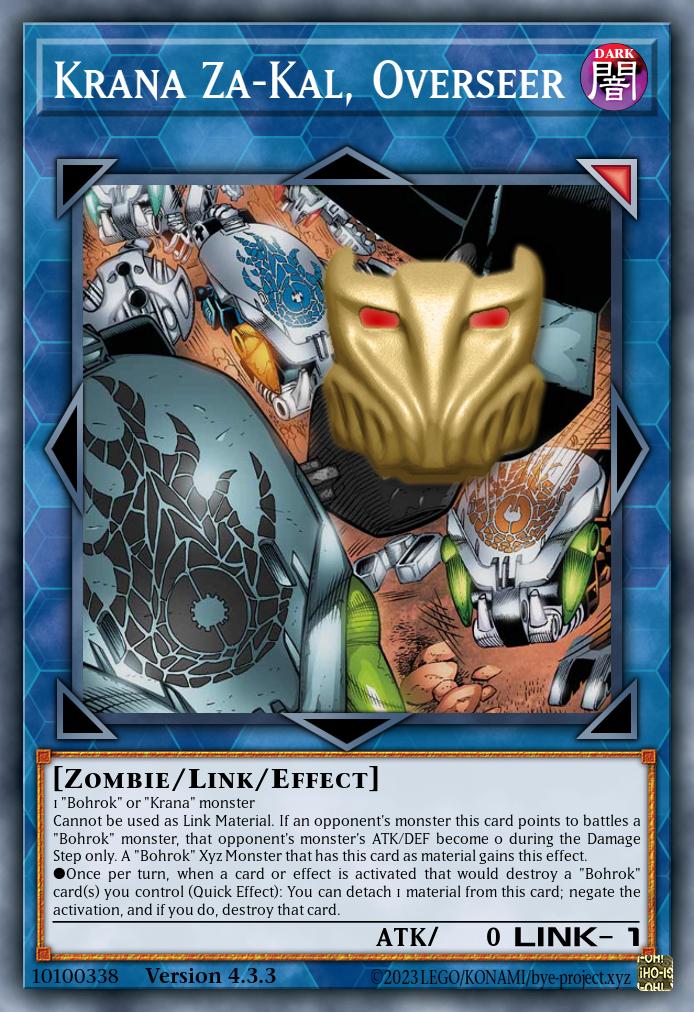
Krana Za-Kal, Overseer
Link Effect MonsterLink-1 [↗] | DARK Zombie | ATK 01 “Bohrok” or “Krana” monster
Cannot be used as Link Material. If an opponent’s monster this card points to battles a “Bohrok” monster, that opponent’s monster’s ATK/DEF become 0 during the Damage Step only. A “Bohrok” Xyz Monster that has this card as material gains this effect.
●Once per turn, when a card or effect is activated that would destroy a “Bohrok” card(s) you control (Quick Effect): You can detach 1 material from this card; negate the activation, and if you do, destroy that card.
The Za-Kal handles telepathic communication and coordination, protecting the group by reading the minds of potential threats and countering them with a negate once they attempt to strike.

Krana Vu-Kal, Transporter
Link Effect MonsterLink-1 [↘] | DARK Zombie | ATK 01 “Bohrok” or “Krana” monster
Cannot be used as Link Material. Once per turn: You can target 1 Level 4 “Bohrok” monster this card points to; Special Summon 1 “Bohrok” Xyz Monster from your Extra Deck, by using that target as material. (This is treated as an Xyz Summon.) A “Bohrok” Xyz Monster that has this card as material gains this effect.
●Once per turn (Quick Effect): You can banish this card until the End Phase, and if you do, you can add 1 “Bohrok” card from your GY to your hand.
The Vu-Kal holds speed and flight powers, mainly used to let its holder dodge away from the field. Doing so comes with the side benefit of recovering a Bohrok card from the GY, befitting its role as a “Transporter”.

Krana Ca-Kal, Seeker
Link Effect MonsterLink-1 [↙] | DARK Zombie | ATK 01 “Bohrok” or “Krana” monster
Cannot be used as Link Material. Once per turn: You can target 1 Level 4 “Bohrok” monster this card points to; Special Summon 1 “Bohrok” Xyz Monster from your Extra Deck, by using that target as material. (This is treated as an Xyz Summon.) A “Bohrok” Xyz Monster that has this card as material gains these effects based on the number of “Bahrag” Monster Cards with different names in your field and banishment.
●1+: Cannot be destroyed by battle. ●2+: Once per turn: You can draw 1 card, then discard 1 card.
Where the Xa-Kal awakens the Bahrag, the telepathic link of the Ca-Kal is the key ingredient to finding them in the first place. This has been translated to benefits granted from the mere existence of banished Bahrag: Being in contact with just one already makes your Seeker Bohrok-Kal not fall in battle, and with two, you get to draw deeper into your deck to accelerate the quest.

Krana Yo-Kal, Excavator
Link Effect MonsterLink-1 [↖] | DARK Zombie | ATK 01 “Bohrok” or “Krana” monster
Cannot be used as Link Material. If an opponent’s monster this card points to battles a “Bohrok” monster, that opponent’s monster’s ATK/DEF become 0 during the Damage Step only. A “Bohrok” Xyz Monster that has this card as material gains this effect.
●This card can attack directly, also if it attacks, your opponent cannot activate monster effects until the end of the Damage Step.
The Yo-Kal grants the ability to tunnel through the earth and sense underground movement, making it excellent for suprise attacks. Specifically, it lets a Bohrok-Kal attack directly while simultaneously limiting responses during the Damage Step further, which has some obvious synergy with the pictured Pahrak-Kal.

Krana Ja-Kal, Tracker
Link Effect MonsterLink-1 [◀] | DARK Zombie | ATK 01 “Bohrok” or “Krana” monster
Cannot be used as Link Material. You can Tribute this card; Special Summon 1 Level 4 “Bohrok” monster from your hand or GY in face-up or face-down Defense Position, but place it on the bottom of the Deck when it leaves the field. A “Bohrok” Xyz Monster that has this card as material gains this effect.
●Once per turn: You can declare 1 card name; until the end of your opponent’s turn, “Bohrok” cards and Set cards you control are unaffected by the effects of cards with that original name.
The Ja-Kal’s job is to detect and track distant obstacles, so what it allows you to do is “sniff out” what your opponent may try to use against you in the future and render it ineffective in advance.
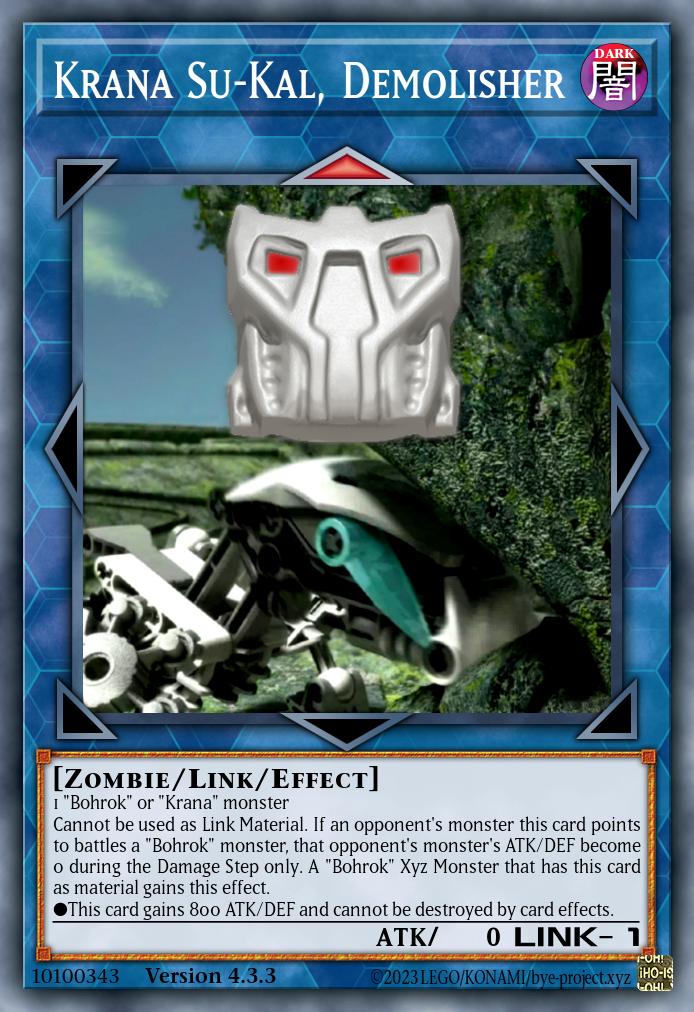
Krana Su-Kal, Demolisher
Link Effect MonsterLink-1 [▲] | DARK Zombie | ATK 01 “Bohrok” or “Krana” monster
Cannot be used as Link Material. If an opponent’s monster this card points to battles a “Bohrok” monster, that opponent’s monster’s ATK/DEF become 0 during the Damage Step only. A “Bohrok” Xyz Monster that has this card as material gains this effect.
●This card gains 800 ATK/DEF and cannot be destroyed by card effects.
The Su-Kal is simply a boost to power and thoughness, so it gives bonus stats and effect protection.

Krana Bo-Kal, Visionary
Link Effect MonsterLink-1 [▶] | DARK Zombie | ATK 01 “Bohrok” or “Krana” monster
Cannot be used as Link Material. You can Tribute this card; Special Summon 1 Level 4 “Bohrok” monster from your hand or GY in face-up or face-down Defense Position, but place it on the bottom of the Deck when it leaves the field. A “Bohrok” Xyz Monster that has this card as material gains this effect.
●Once per turn: You can look at all Set cards your opponent controls, also look at as many random cards in their hand as possible, up to the number of “Bohrok” monsters you control.
The Bo-Kal grants all kinds of vision through darkness and walls, and the private information of Set cards and hand is no exception. In order to not make looking at the hand too easy, it’s tied to how many Bohrok you have managed to put on the field, for which I engineered a novel “as many random cards as possible, up to” phrasing so you don’t have to go through an ingame dropdown where you’d always select the maximum anyway.
The Plan
We have the mecha-brawn and we have the bio-brains, so how do we proceed from here? First of all, we must set the scene. Gahdok and Cahdok have been sealed away, there is cleanup still to be done, and so the Bohrok-Kal arise to the sonorous sounds of Red Hot Chilli Peppers. Enter Bohrok Kalifornication.

Bohrok Kalifornication
Continuous TrapIf your opponent controls a face-up card, you can activate this card the turn it was Set, by banishing 2 “Bahrag” monsters with different names from your Extra Deck. During the Main Phase: You can send 1 “Bohrok” or “Krana” card from your hand or face-up field to the GY, then target up to 2 “Bohrok” monsters in your GY; Special Summon 1 “Bohrok” Xyz Monster from your Extra Deck, and if you do, attach the targeted monsters to it as material, but return it to the Extra Deck during your opponent’s End Phase. You can only use this effect of “Bohrok Kalifornication” once per turn.
This is possibly my favorite card name I’ve ever made, and it works just as described above: When facing a populated field, just set and activate it, banish the Bahrag to provide the conditions for Xa-Kal and Ca-Kal to work, and start trading your Bahrag cards in hand or field for a (somewhat temporary) Bohrok-Kal every turn. One neat trick you can actually do is attaching a Vu-Kal to a monster Summoned this way and banishing it before it would leave, thereby making it forget its expiry date and stay around permanently once it returns.
(As a side note, at the very end of development I noticed it would be better to have the Bahrag banish as an alternative effect activation cost rather than part of the accelerated card activation condition, so you can more reliably set up that board state. Didn’t want to change it at this point, but might happen in a legacy update eventually.)
Of course, simply arriving is not enough to accomplish the great task ahead. After all, the Toa Nuva and their mighty elemental powers are sure to stand in our way. Now watch and learn, here’s the deal: The Nuva Symbols we shall steal!
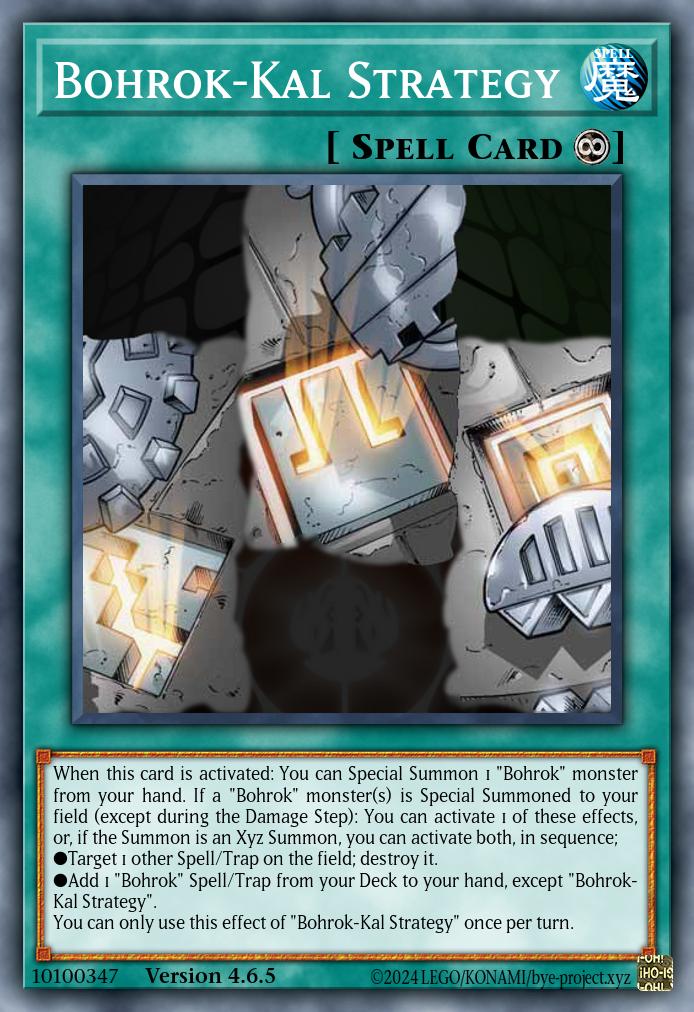
Bohrok-Kal Strategy
Continuous SpellWhen this card is activated: You can Special Summon 1 “Bohrok” monster from your hand. If a “Bohrok” monster(s) is Special Summoned to your field (except during the Damage Step): You can activate 1 of these effects, or, if the Summon is an Xyz Summon, you can activate both, in sequence;
●Target 1 other Spell/Trap on the field; destroy it.
●Add 1 “Bohrok” Spell/Trap from your Deck to your hand, except “Bohrok-Kal Strategy”.
You can only use this effect of “Bohrok-Kal Strategy” once per turn.
If Kalifornication is one of my favorite names, then Bohrok-Kal Strategy is more generally one of my favorite designs in this set. A Continuous Spell that triggers every time you Special Summon a Bohrok (face-up, is the tricky part) and gives you the first trigger as a freebie with a Special Summon from hand. Either you get to destroy another Spell/Trap, which is great against floodgates and of course represents the lore aspect of stealing the Nuva Symbols, or you search another Bohrok Spell/Trap to help with your setup. If you properly Xyz Summon (note that Kalifornication does not do this!), you even get to activate both together for some insane value.
Well then, everything’s ready for our Counterattack. Oh look, a “Counter” Counter Trap, someone call Battlin’ Boxers.

Bohrok Counterattack
Counter TrapWhen your opponent activates a Spell/Trap Card, or monster effect, while you control a “Bohrok” monster or only face-down monsters (min. 1): Send 1 “Krana” monster from your Deck or Extra Deck to the GY; negate the activation, then you can attach that card to 1 “Bohrok” Xyz Monster you control as material.
It’s just a standard archetypal negation backrow, worded so it also works with the usual plain Bohrok setups but actually gets rid of the negated card if the Bohrok-Kal are in play. Getting a Krana into the GY does also come in handy.
And finally, when victory is at hand, the Krana-Kal unleash their last secret: The Silver Shield protecting the Bohrok-Kal from all interference as they cross the finish line.

Bohrok Silver Shield
Quick-Play SpellTarget 1 “Krana” monster you control or in your GY; either return it to the hand or attach it to a “Bohrok” Xyz Monster you control as material. At the start of the Battle Phase: You can banish this card from your GY; until the end of this turn, “Bohrok” Xyz Monsters you control are unaffected by card effects, except their own, while they have a “Krana” Link Monster as material. Neither player can activate cards or effects in response to this effect’s activation. You can only use each effect of “Bohrok Silver Shield” once per turn.
The activation effect is just basic utility to recycle or attach a Krana – doing this without activating a monster effect is actually a pretty good trick to have up your sleeve. But the main point lies in the GY effect, which triggers at the start of the Battle Phase to turn the Krana-Kal attached to your Bohrok-Kal into some of the most potent protection the game has to offer, ensuring your attack to trigger the Xa-Kal will go through uninterrupted. About the only thing that could stop you at that point is a form of negation that makes the Bohrok-Kal fall to its own power, but surely nothing like that exists .
Sterling Silver? Link-8? Match Winner? Whatever are you talking about? I fear you may have had too many expired Vuata Maca Fruits, friend.
Sample Decks
Unlike the Toa Nuva, where a variety of decks came from the question of what to mix them with, Bohrok kind of just don’t mix with anything. The Kal all require archetypal materials only, cards like Strategy or Kalifornication need you to draw other Bohrok stuff to do anything, and so on. As a result, the different builds included in the expansion are more a consequence of limited Extra Deck space – with 8 Krana-Kal, 6 Bohrok-Kal, 2 Bahrag, and 2 Kaita, the numbers just don’t work out for a deck that does everything. However, since the differences are pretty minimal, I won’t bother going over them all and instead leave it at a quick rundown of the lore-accurate “awaken the Bahrag” build.
Its core is a Bohrok package of Gahlok , Nuhvok , and Pahrak , the three breeds that can use their effects and still remain on the field to serve as material. But in some cases you may value more potent removal over maximum efficiency, so the side deck also has a Lehvak to swap in. All of these come with their respective Bohrok Va for additional field presence and utility. Partnered with them are Bohrok Spells/Traps both new and old, as well as a Therion Regulus that Rank 4 lines can search by way of Merrymaker into Sargas.
The Extra Deck features the Bahrag we seek to awaken as well as the Xa-Kal and Ca-Kal to enable that, plus an useful (but necessarily incomplete) selection of other Krana-Kal and Bohrok-Kal. Of course Zeus is here too, it’s an Xyz deck.
Best of Test
Some assorted duel footage that shows not only the above build in action, but also those “minimally different” others that focus either on more general Bohrok-Kal spam or on making the Kaita.
Conclusion
The Bohrok-Kal, but perhaps more so the associated Krana-Kal and the various new Spell and Trap cards, take the slowly ramping Flip Monster strategy of the old Bohrok and augment it with such useful abilities as “building a board going first” or “breaking a board going second”. While their general reliance on archetypal cards makes it hard to put together anything other than a pure deck, the wide variety of Extra Deck monsters added with this support introduces some significant choices to be made in that process. Meanwhile, the Main Deck still contains all the flippy goodness of the Bohrok swarms, which can serve as a surpisingly powerful fallback strategy once the big bombs have been exhausted.

